

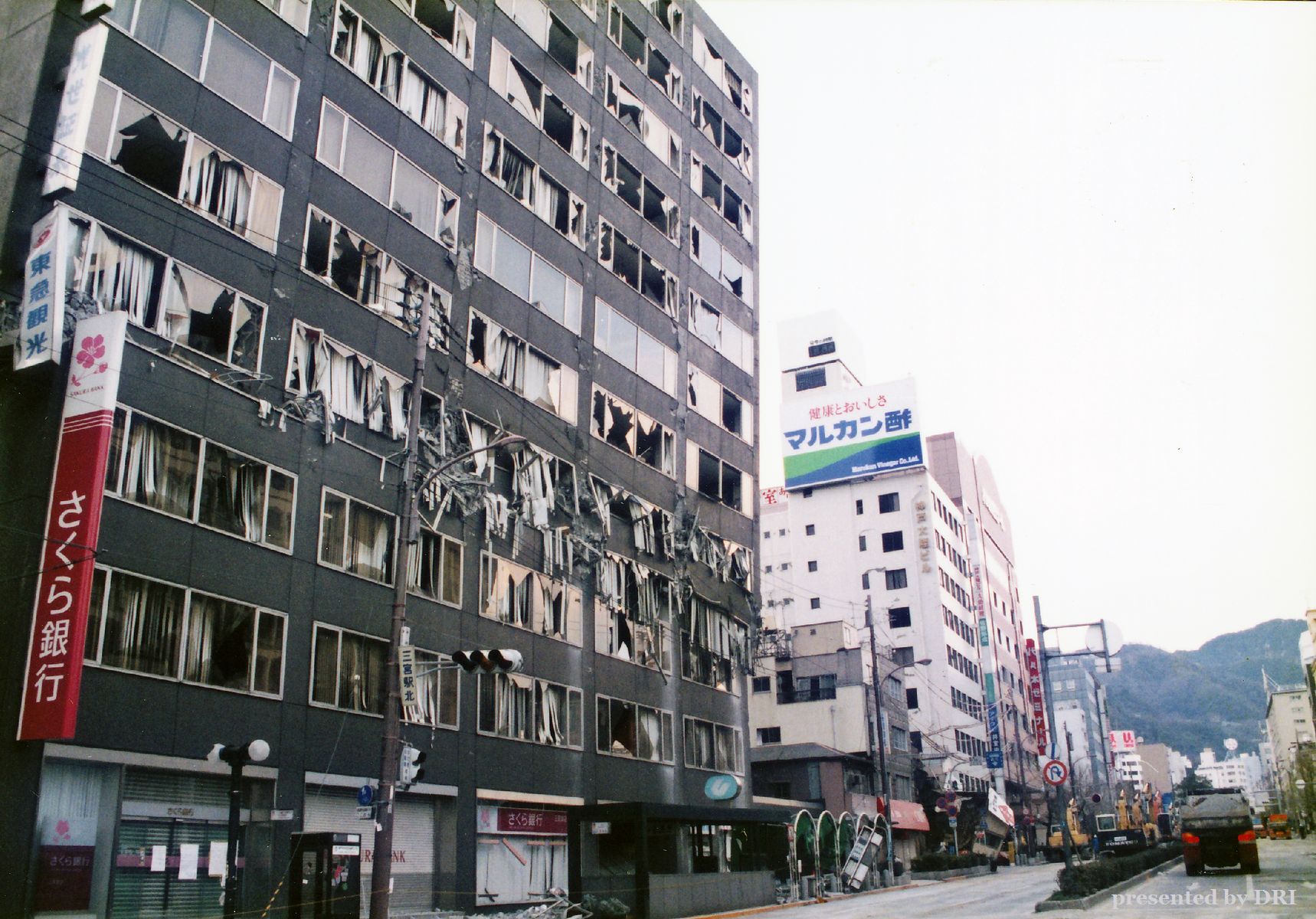
Damaged building in Sannomiya, central Kobe. The fourth floor has completely collapsed and the fifth floor now sits on top of the third floor.
Kobe City, Chuo Ward, 21 January 1995.
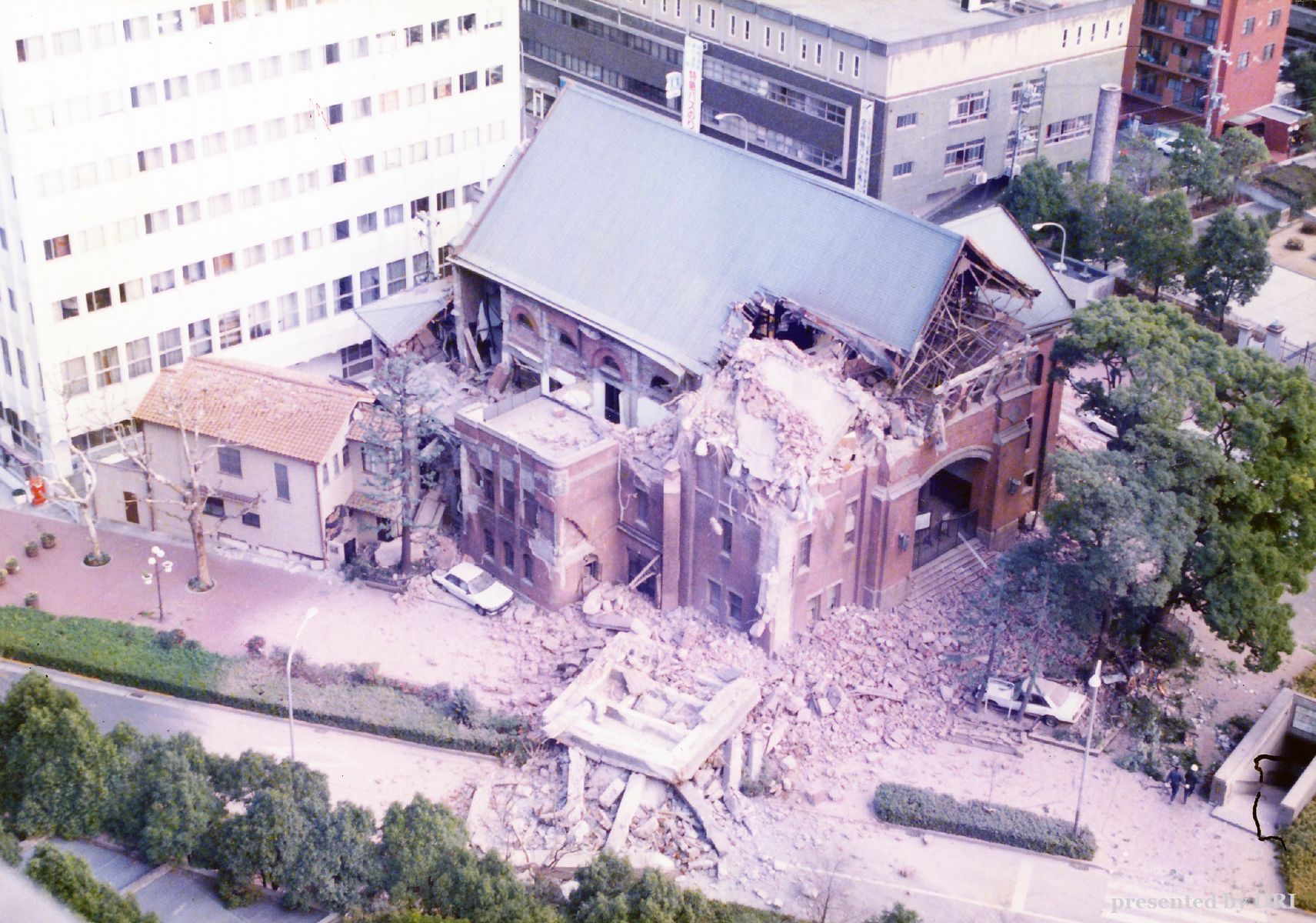
Collapsed gothic style cathedral.
Kobe City, Chuo Ward, 17 January 1995.
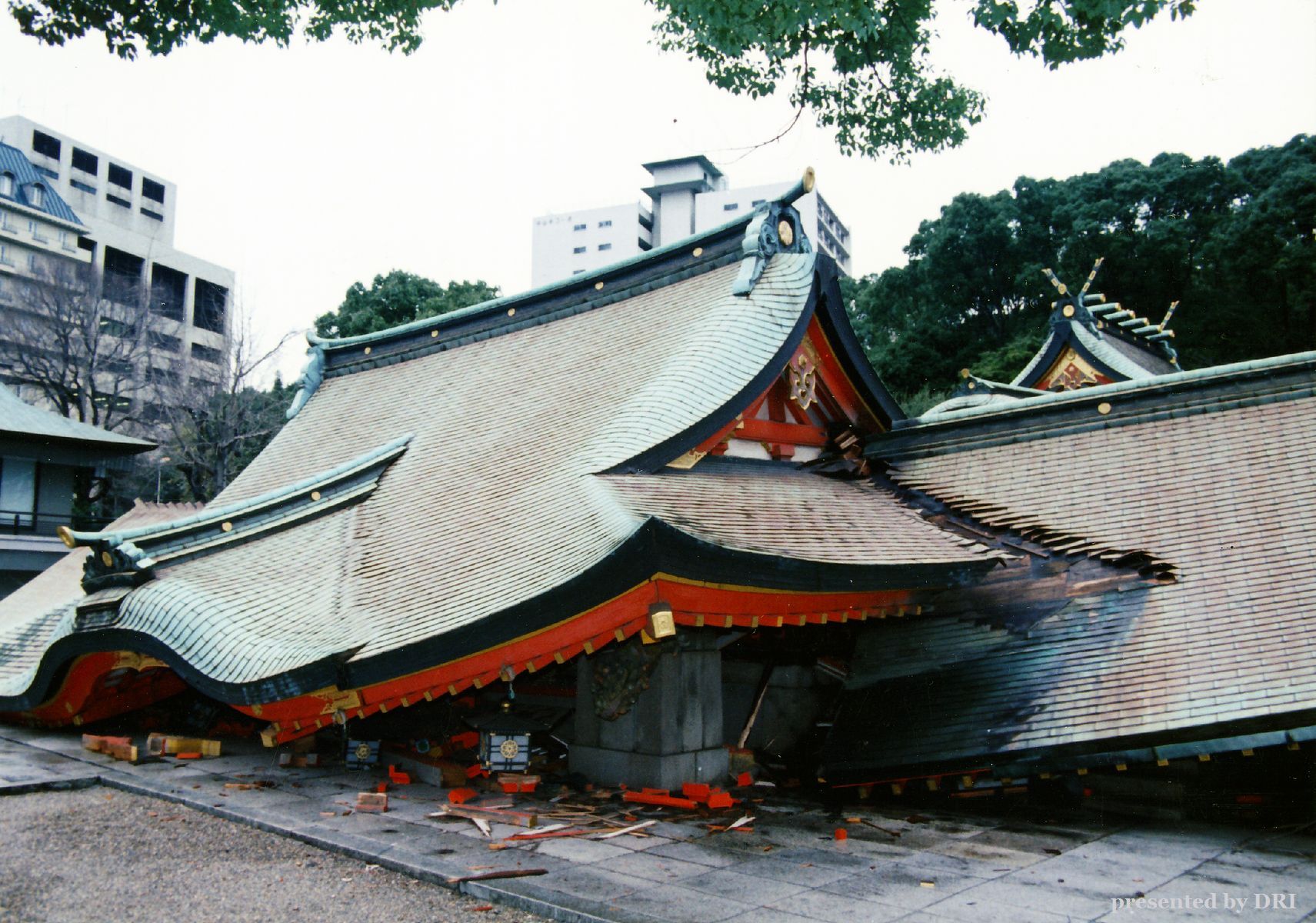
A Shinto shrine in central Kobe, also completely collapsed.
Kobe City, Chuo Ward, 23 January 1995.
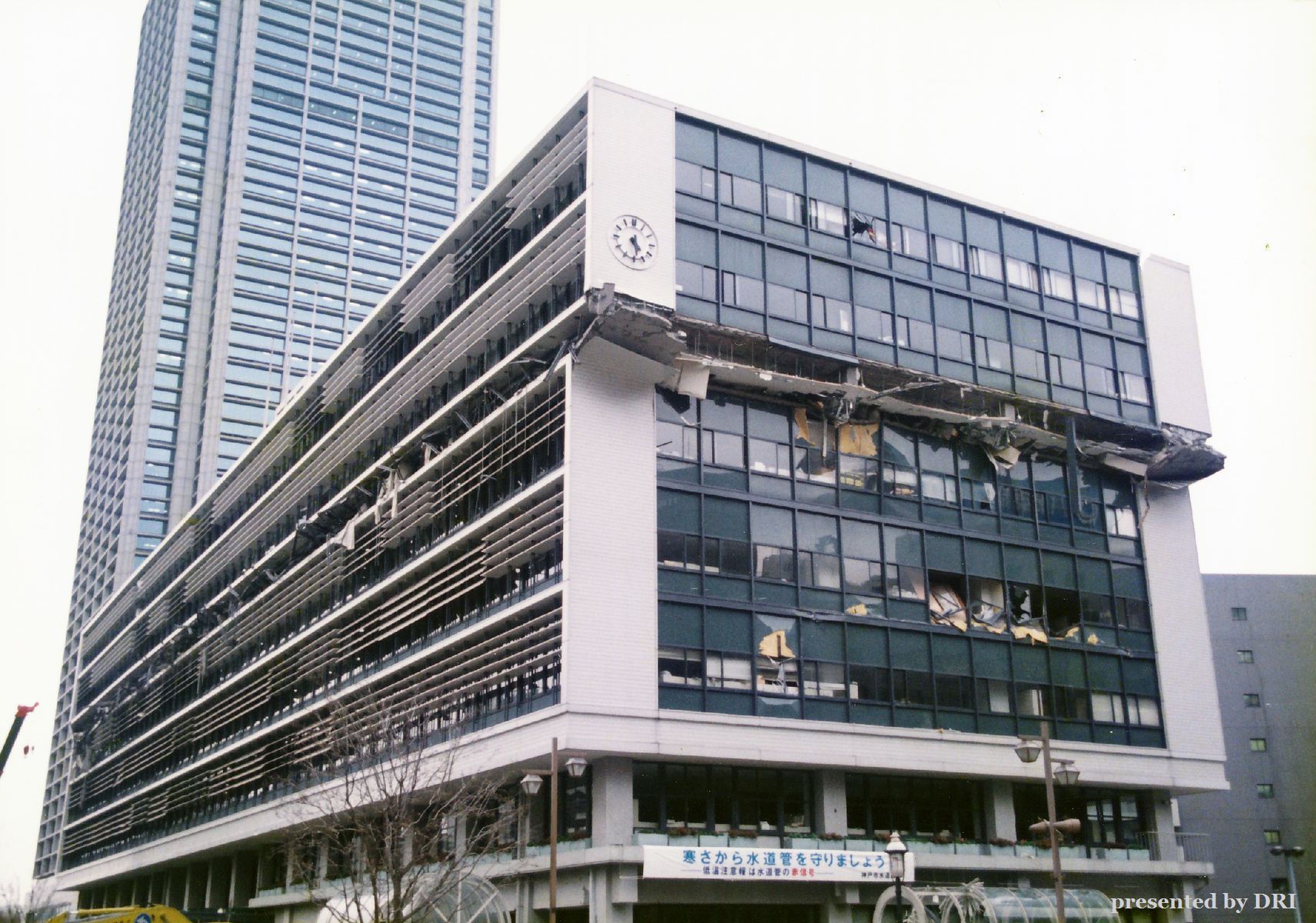
Kobe City No. 2 government office building. The sixth floor of the eight story building has collapsed. It has been reconstructed as a five storey building, with the upper floors removed.
Kobe City, Chuo Ward, 23 January 1995.
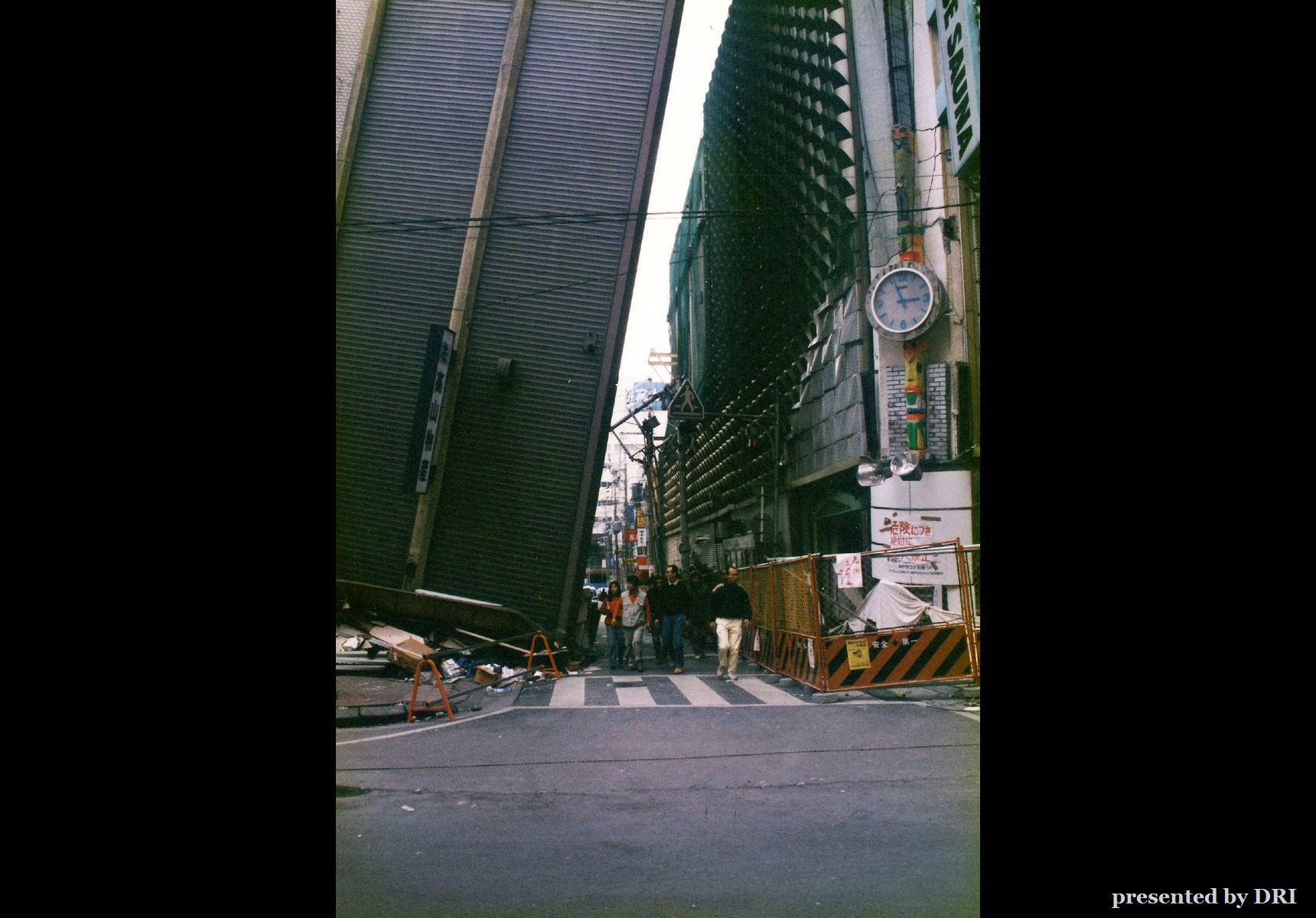
Tilted building. In some cases, buildings which were tilted by the earthquake later fell completely in strong aftershocks.
Kobe City, Chuo Ward, 23 January 1995.
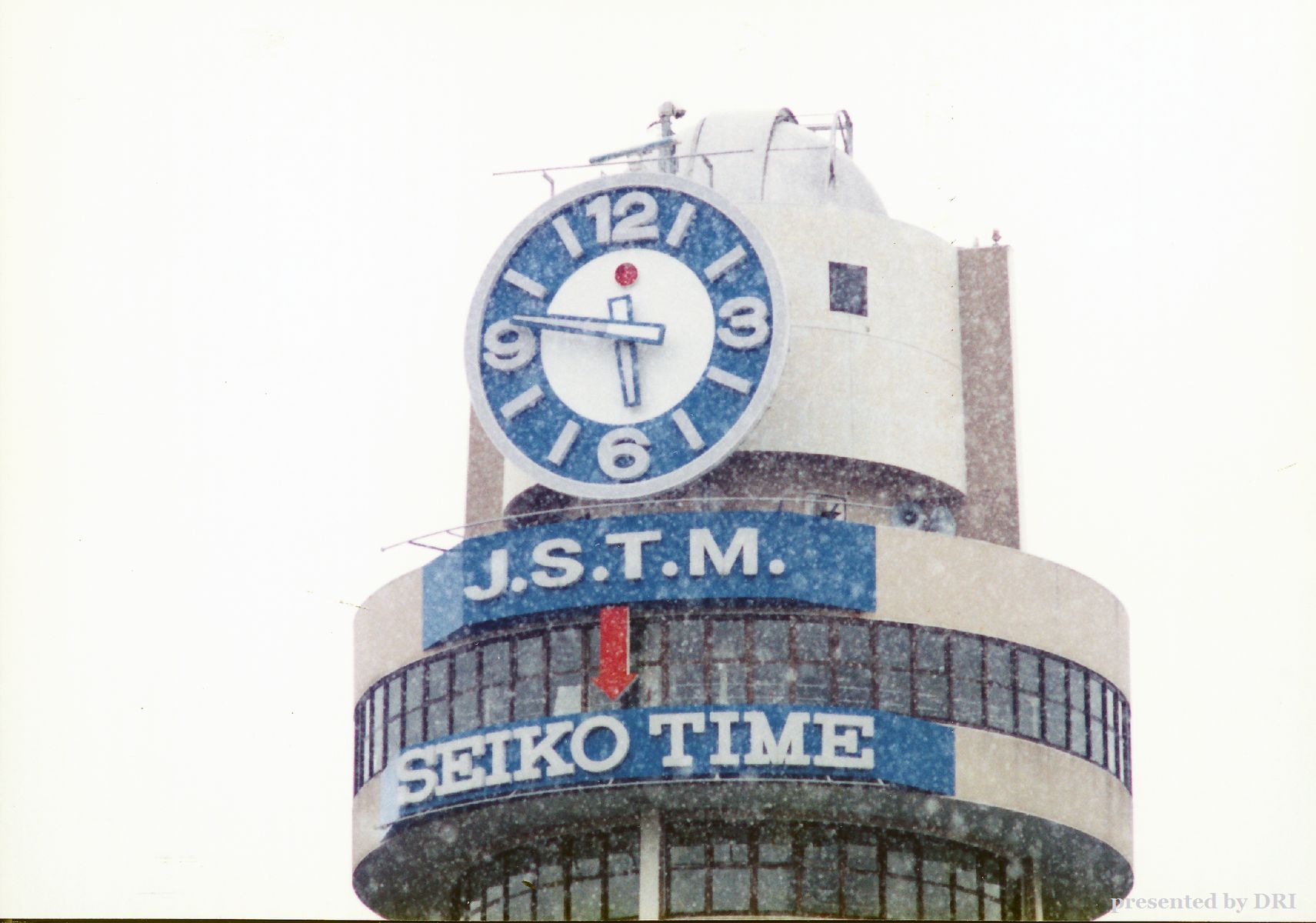
The clock on top of the Akashi Municipal Planetarium stopped at the time of the earthquake.
Akashi City, 16 February 1995.
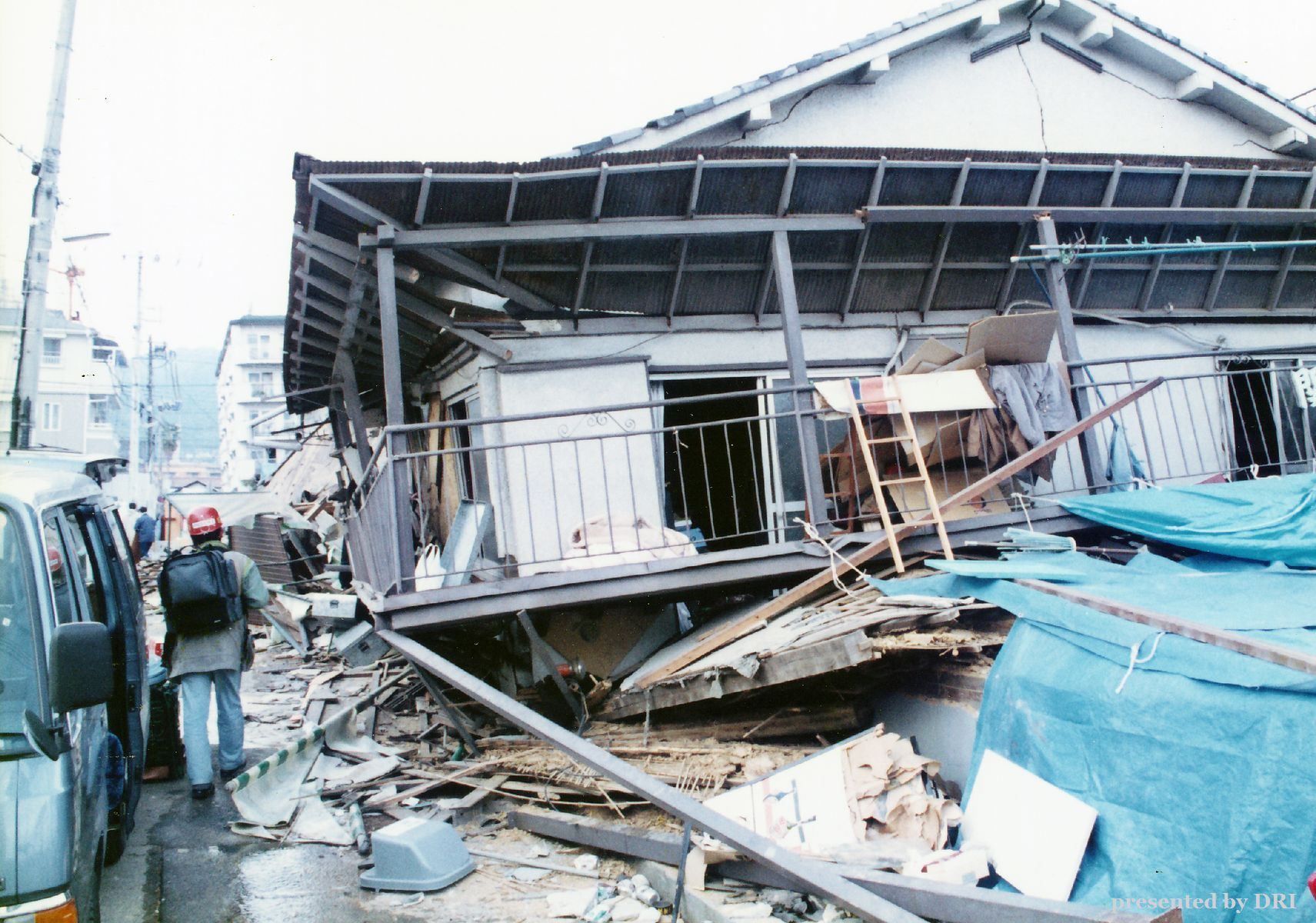
The ground floor of this house collapsed, and the second floor has come to the ground. One of the many people walking around with backpacks after the earthquake, also appears in this photograph.
Kobe City, Nada Ward, 21 February 1995.
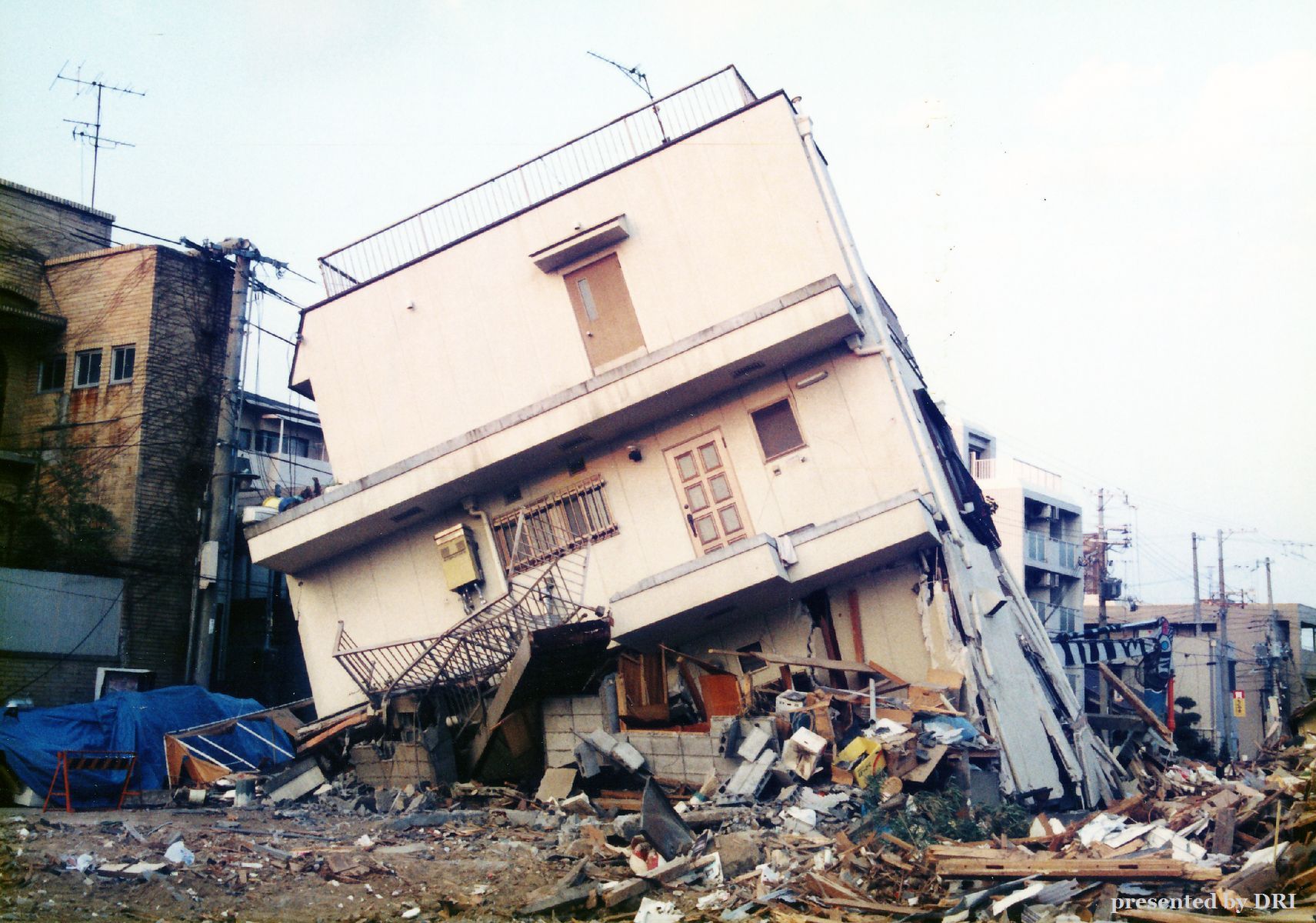
A broken support pillar on one side of the ground floor caused this three storey house to tilt severely.
Kobe City, Higashi Nada Ward, 26 February 1995.
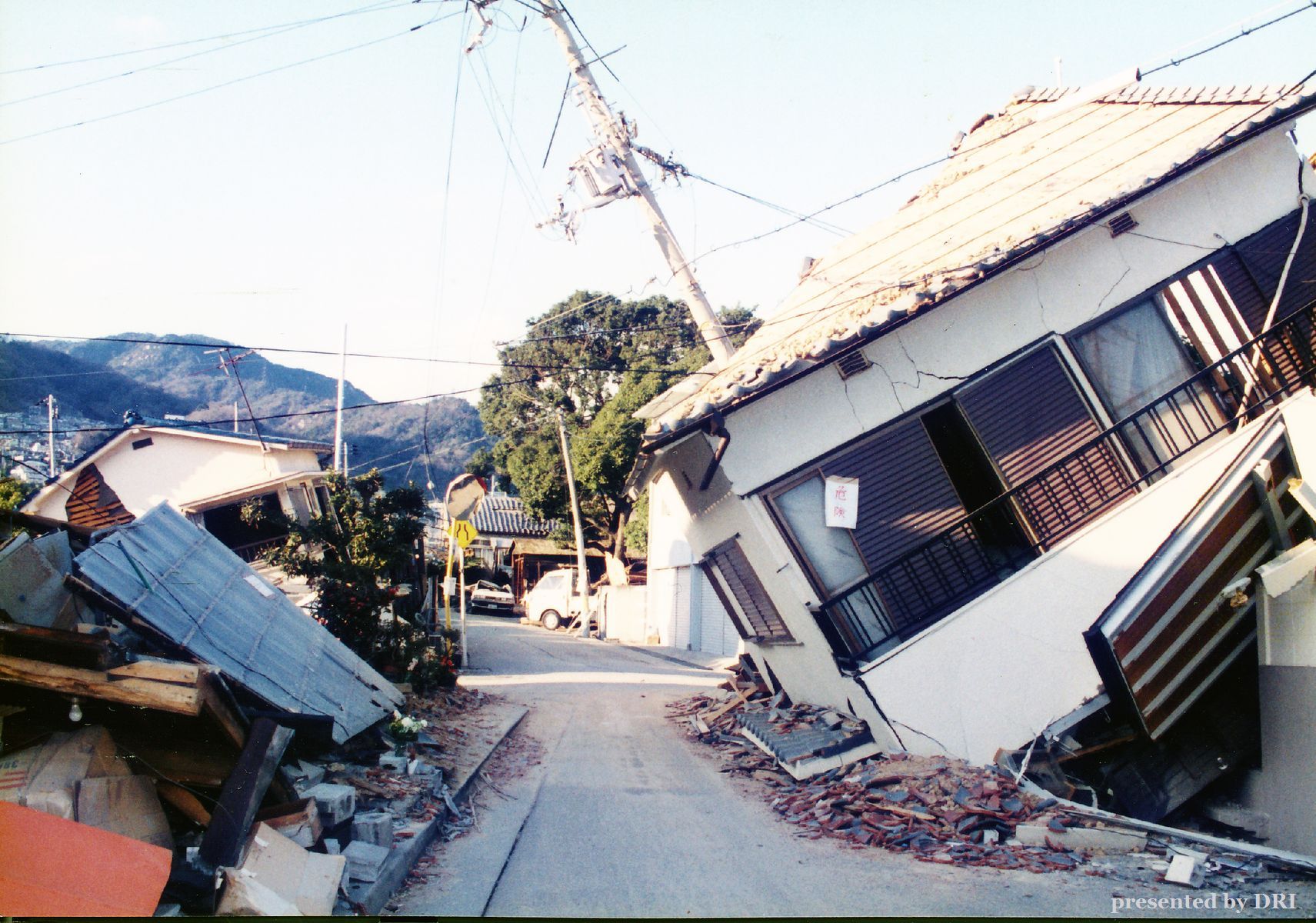
Part of the second floor of this house is touching the ground. An electricity pole and another house, also tilting in the same direction, can also be seen, showing the strength of the earthquake and the direction of its force.
Ashiya City, 2 February, 1995.
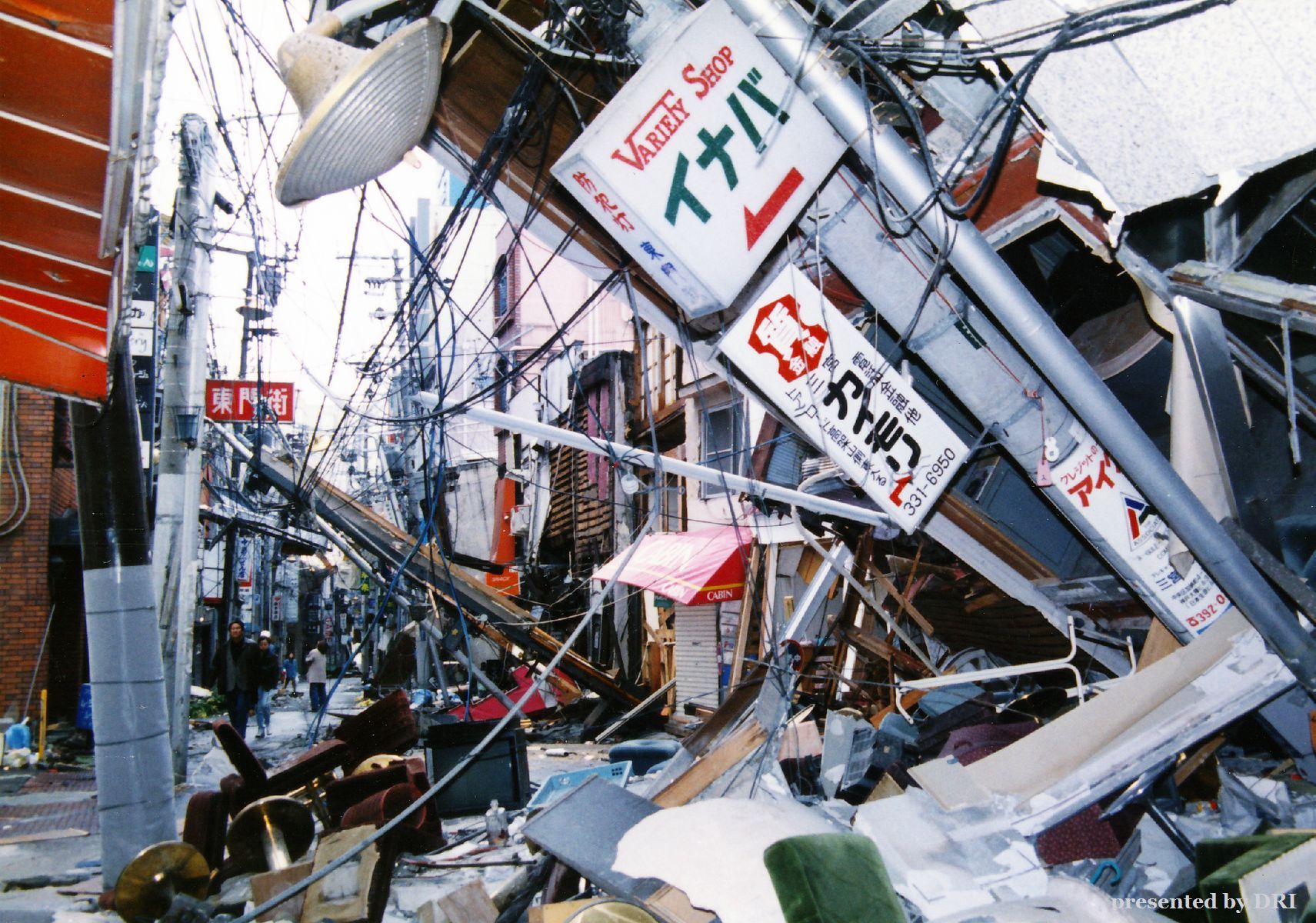
Damage to China Town in Sannomiya. Electricity poles have fallen and the shop interiors are spilling onto the street.
Kobe City, Chuo Ward, 23 January 1995.
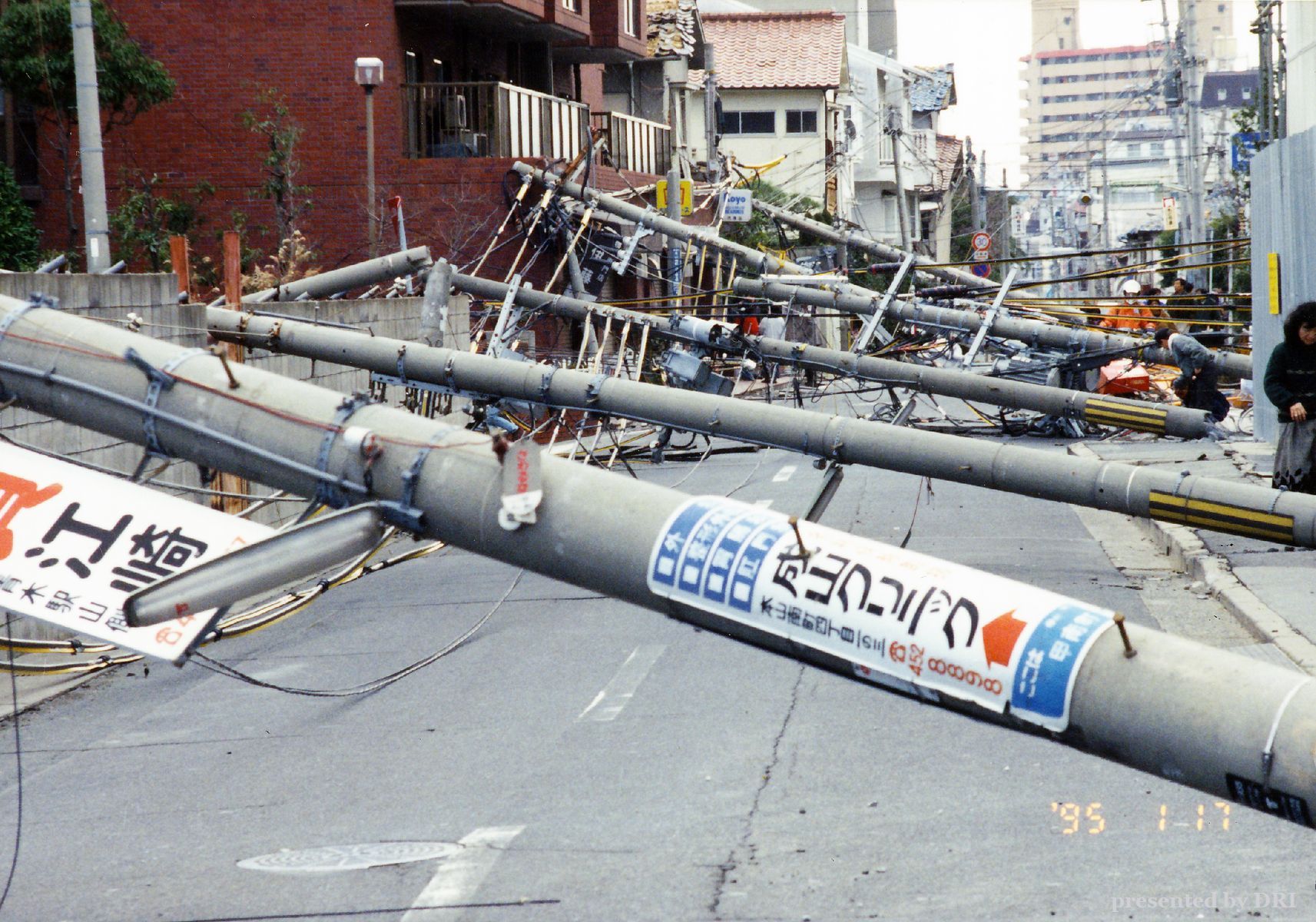
Electricity poles have fallen almost to a horizontal position, blocking the roads.
Kobe City, Higashi Nada Ward, 17 February 1995.
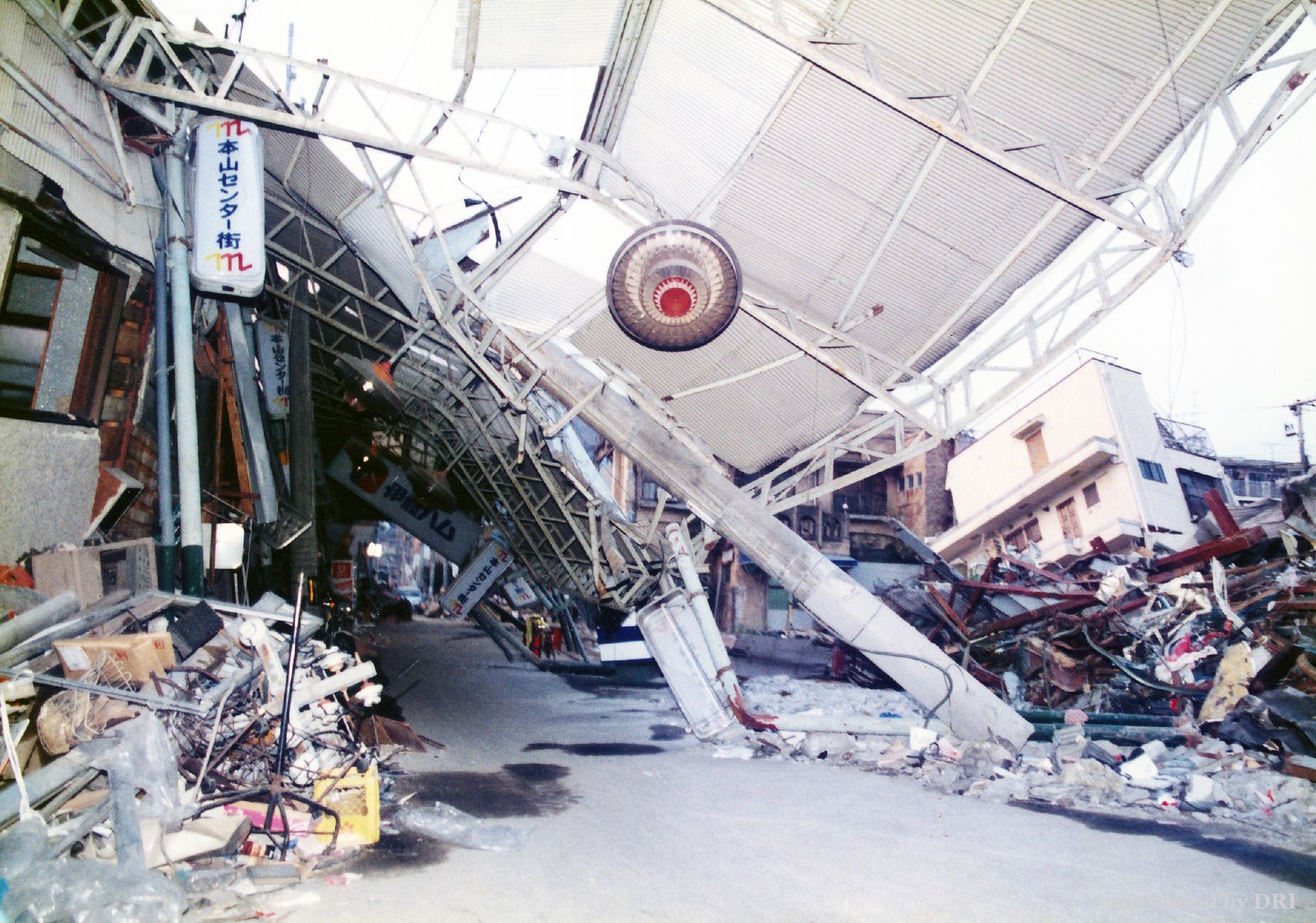
Shopping arcade. One side of the arcade is tilting so severely it looks as though it may collapse to the ground.
Kobe City, Higashi Nada Ward, 26 February 1995.
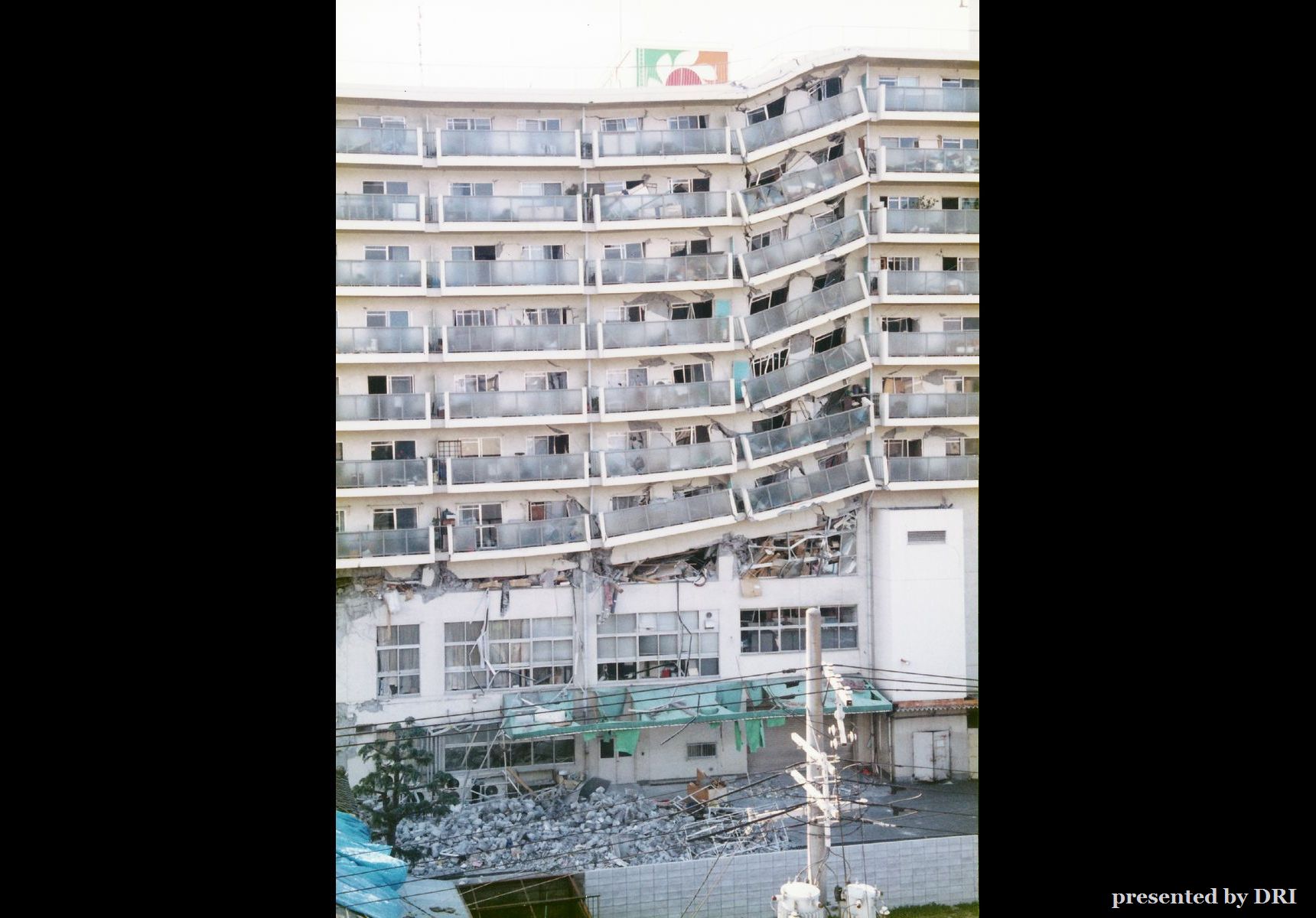
Damaged high rise apartment block. Lower level floors have collapsed, distorting the building structure.
Nishinomiya City, 26 February 1995.
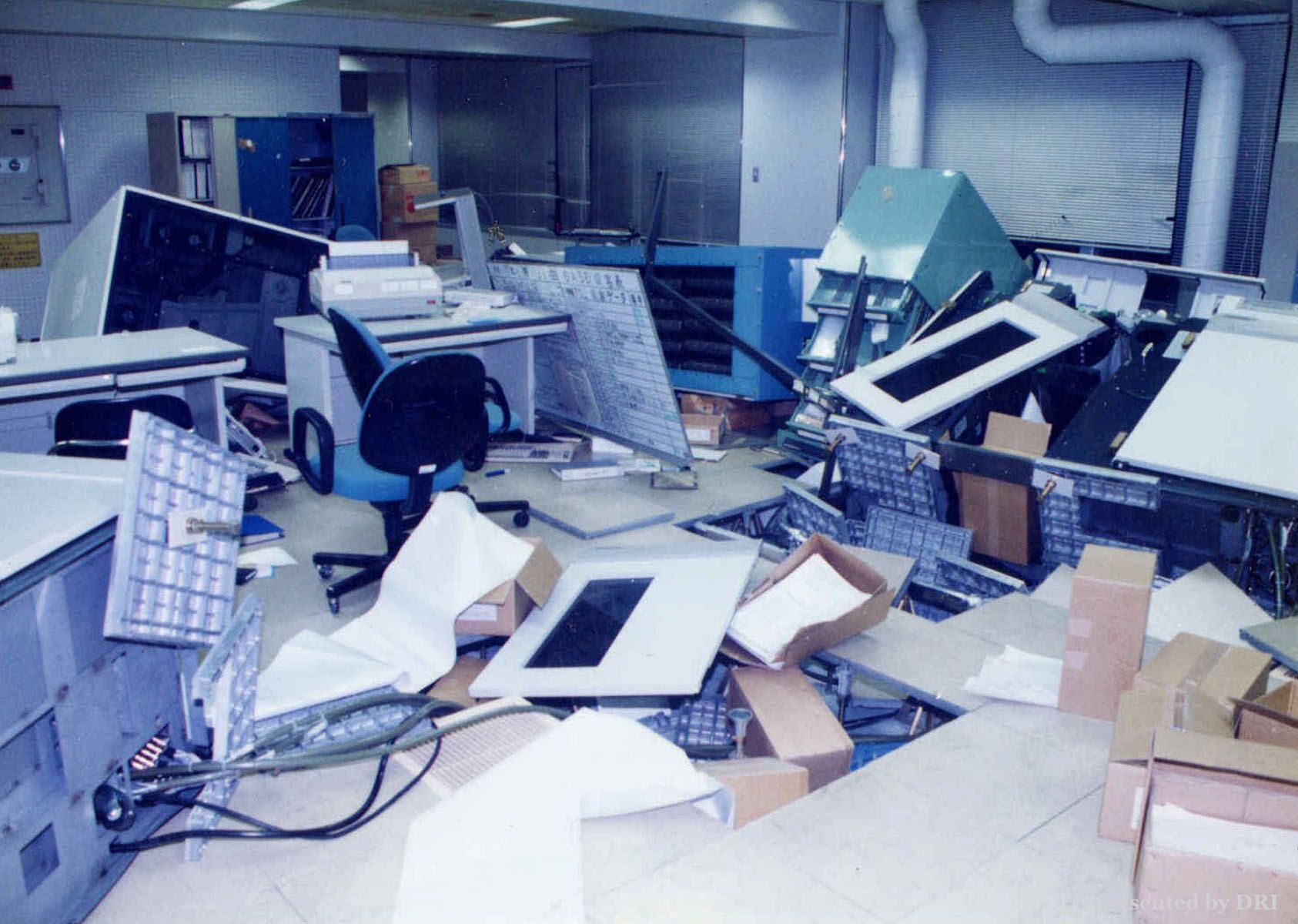
Inside Hyogo Prefectural office. Computer racks and stationary have fallen and are scattered violently.
Kobe City, Chuo Ward, 17 January 1995.
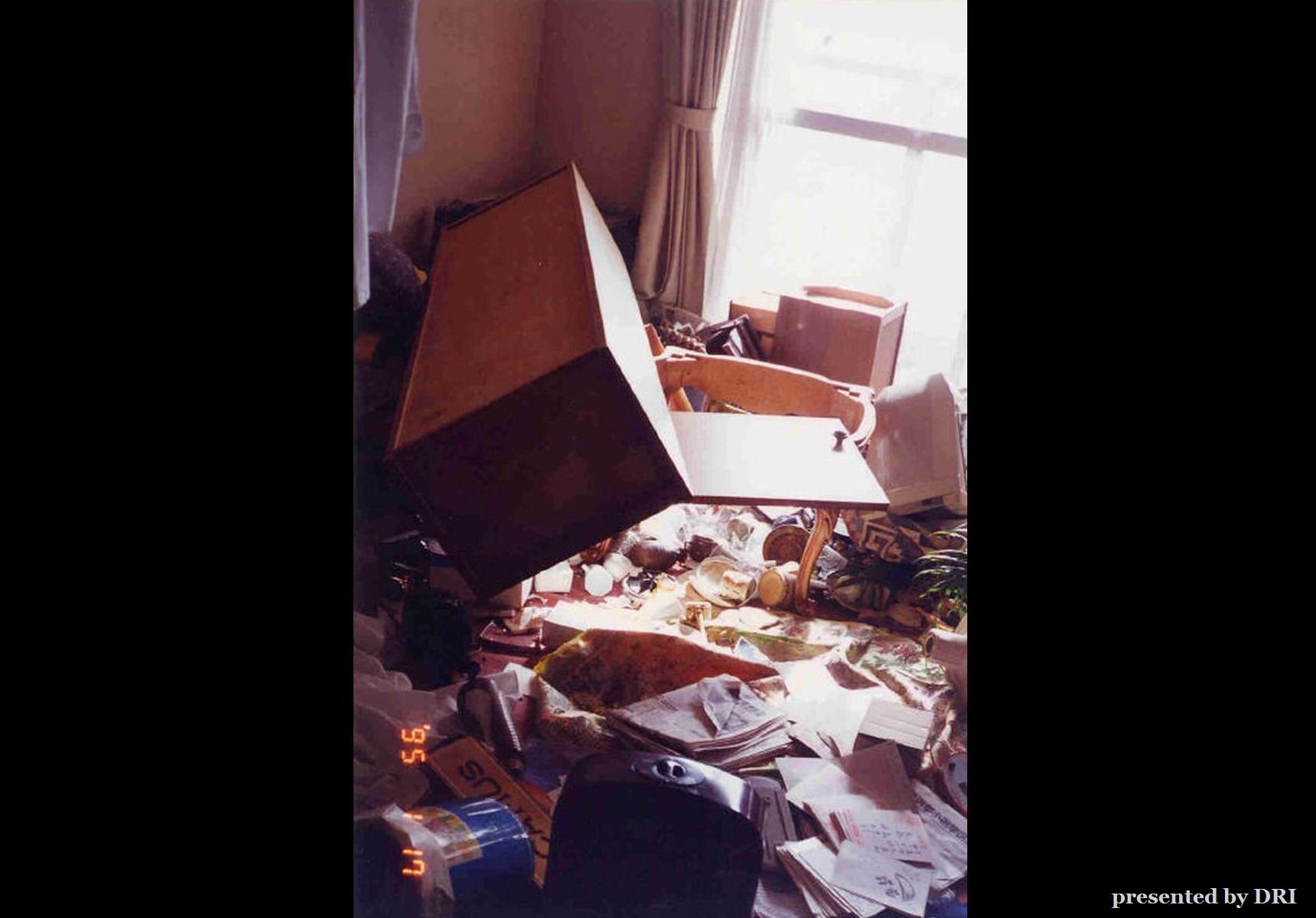
Inside a house. Shelves have fallen and things are scattered everywhere. There's nowhere to put your feet. 17 January 1995.
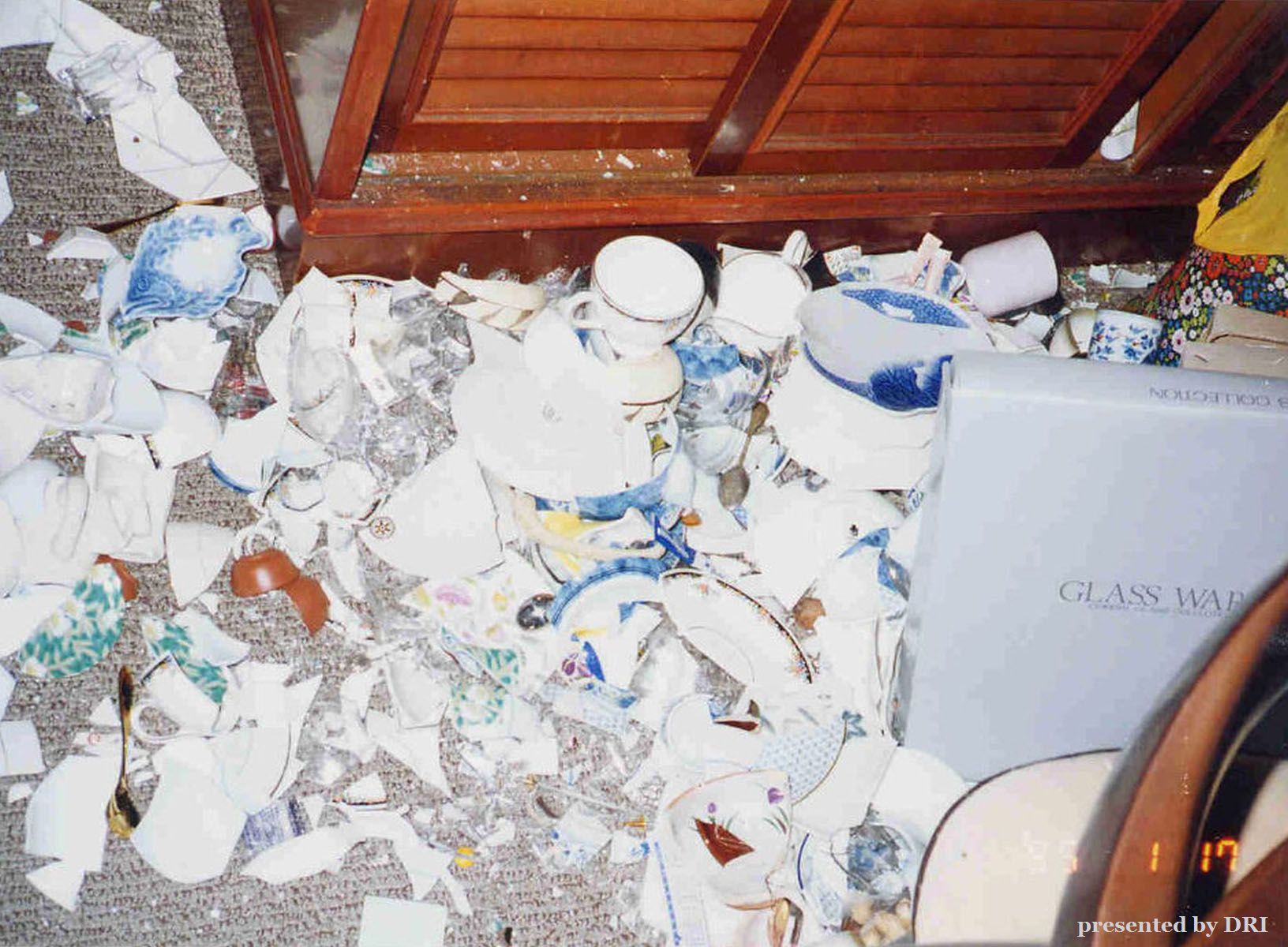
Inside a house. Dishes are all in pieces and scattered everywhere.
17 January 1995.
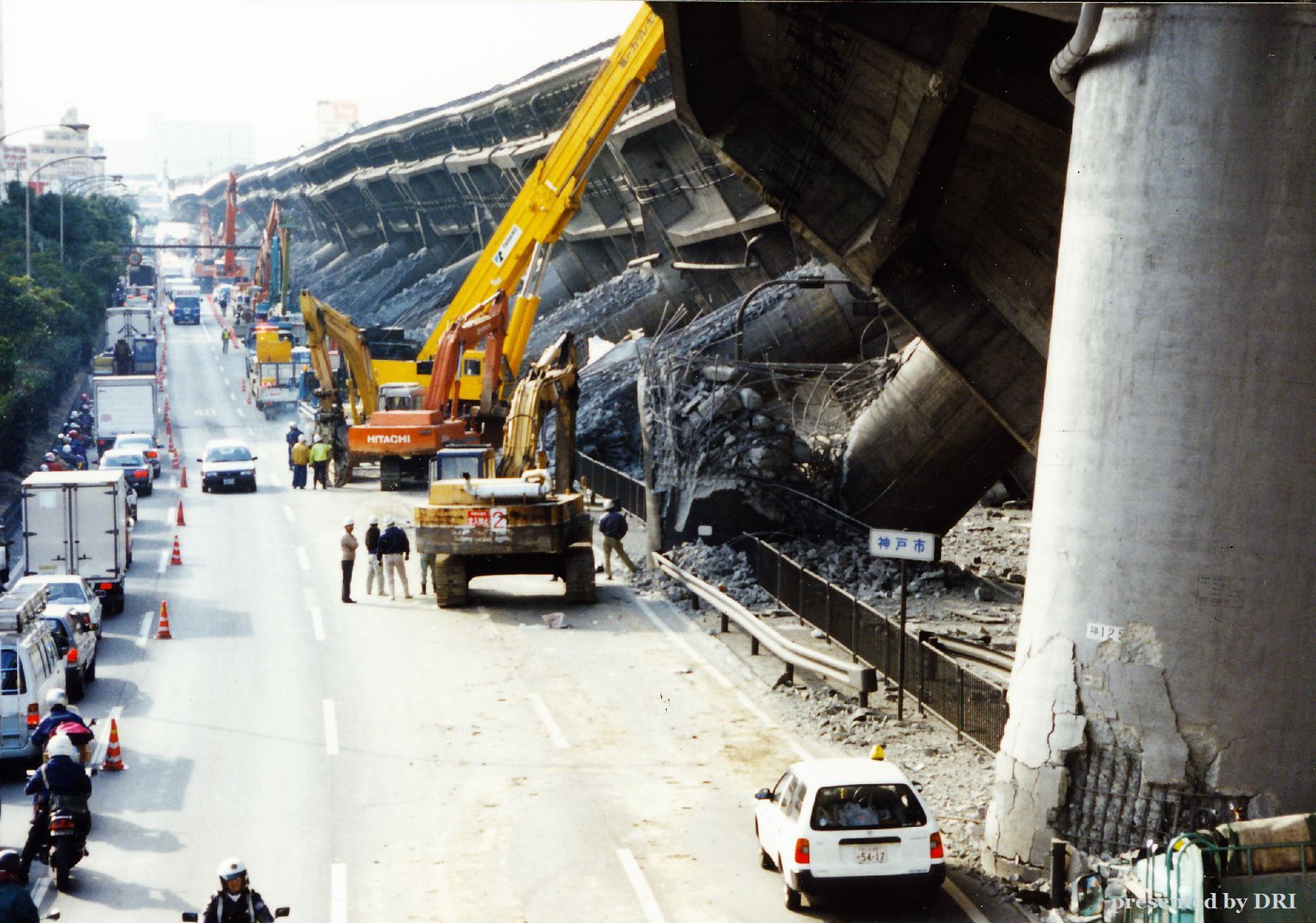
This collapsed elevated highway became an iconic scene showing the enormity of damage caused by the earthquake. Reconstruction began 2 days after the quake.
Kobe City, Higashi Nada Ward, 19 January 1995.
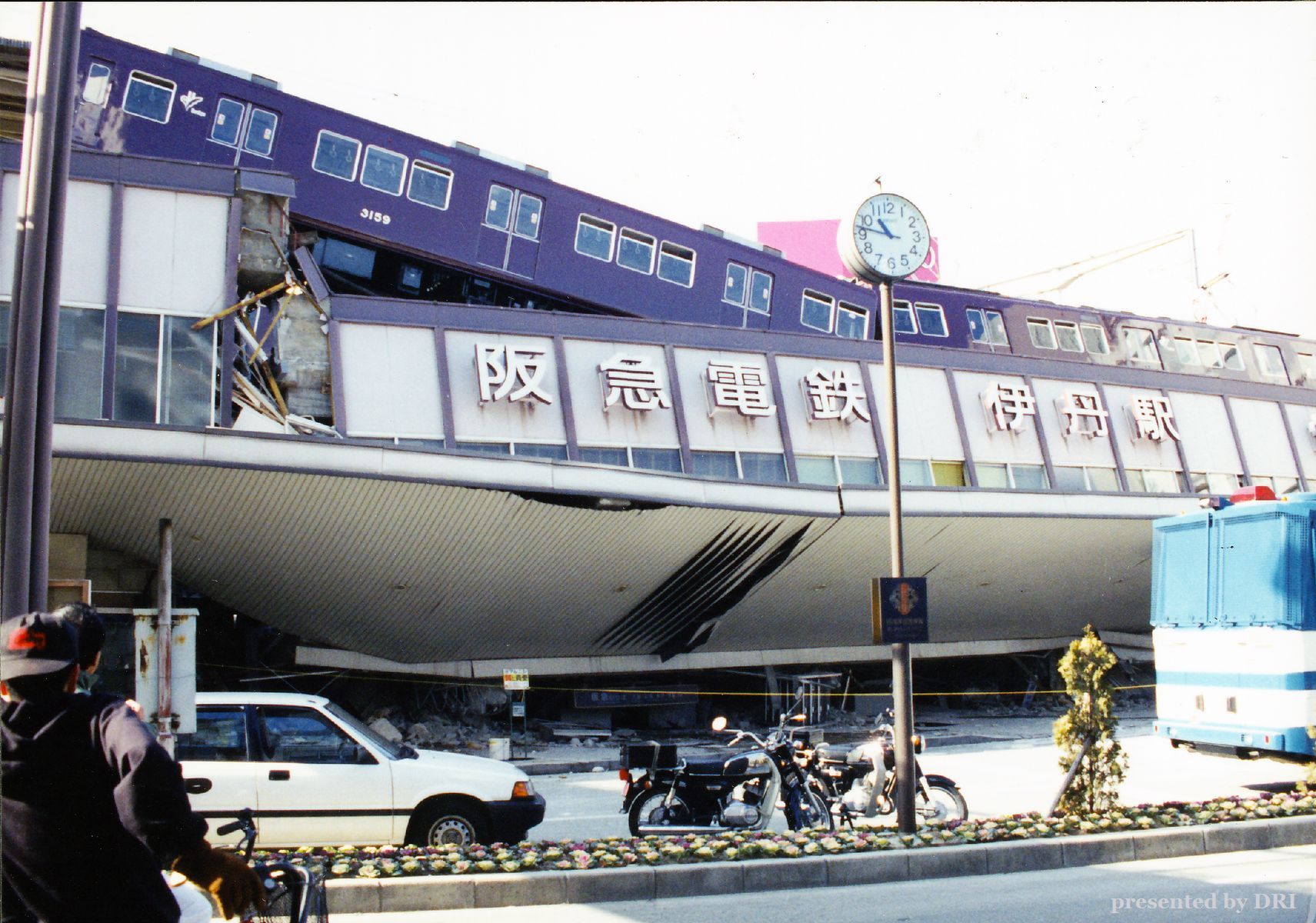
Itami Station on the Hankyu Line. The ground floor entrance has collapsed.
Itami City, 17 January 1995.
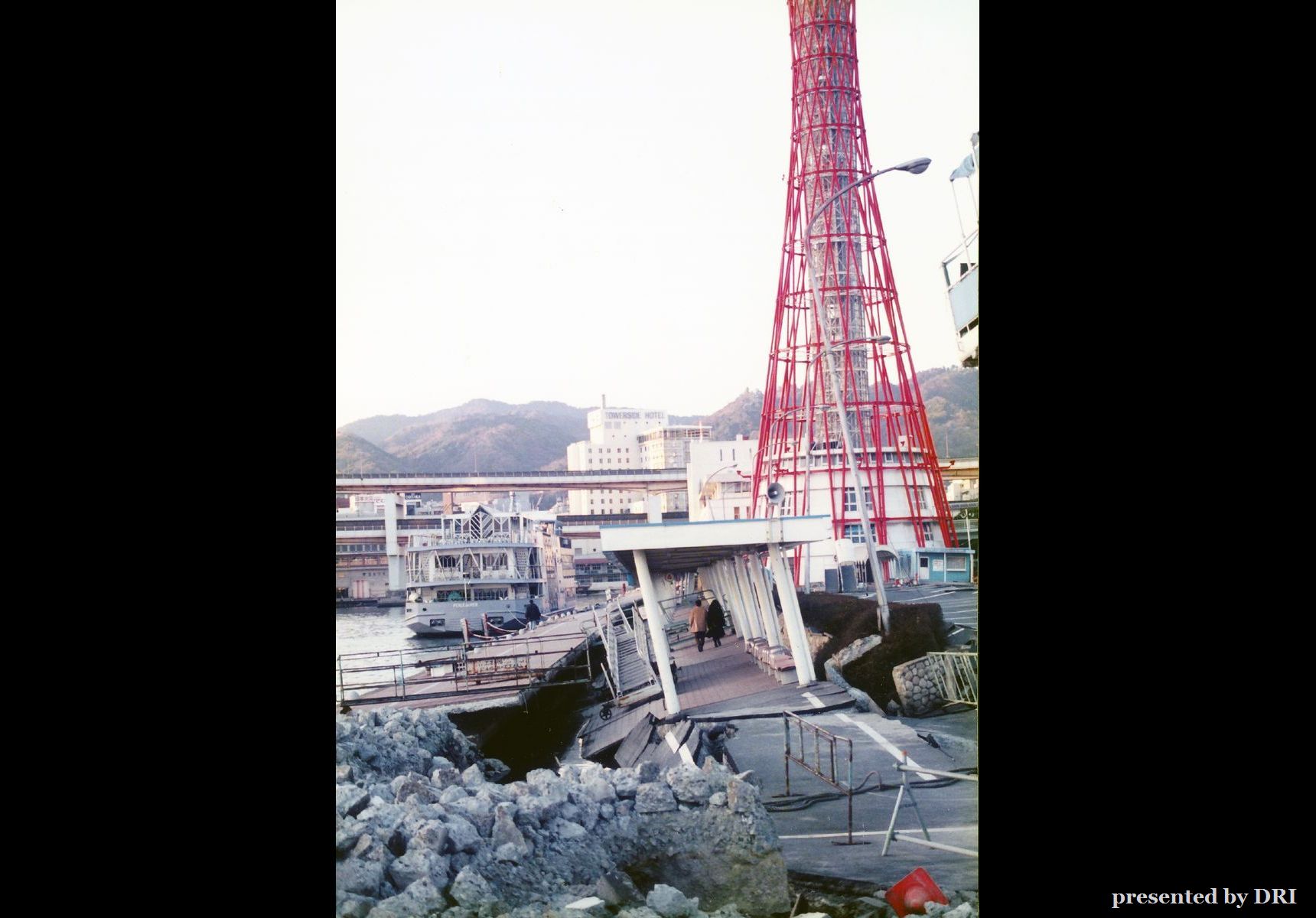
Damage in the Nakatotte area around Kobe Port. Docks have collapsed.
Kobe City, Chuo Ward, 19 February 1995.
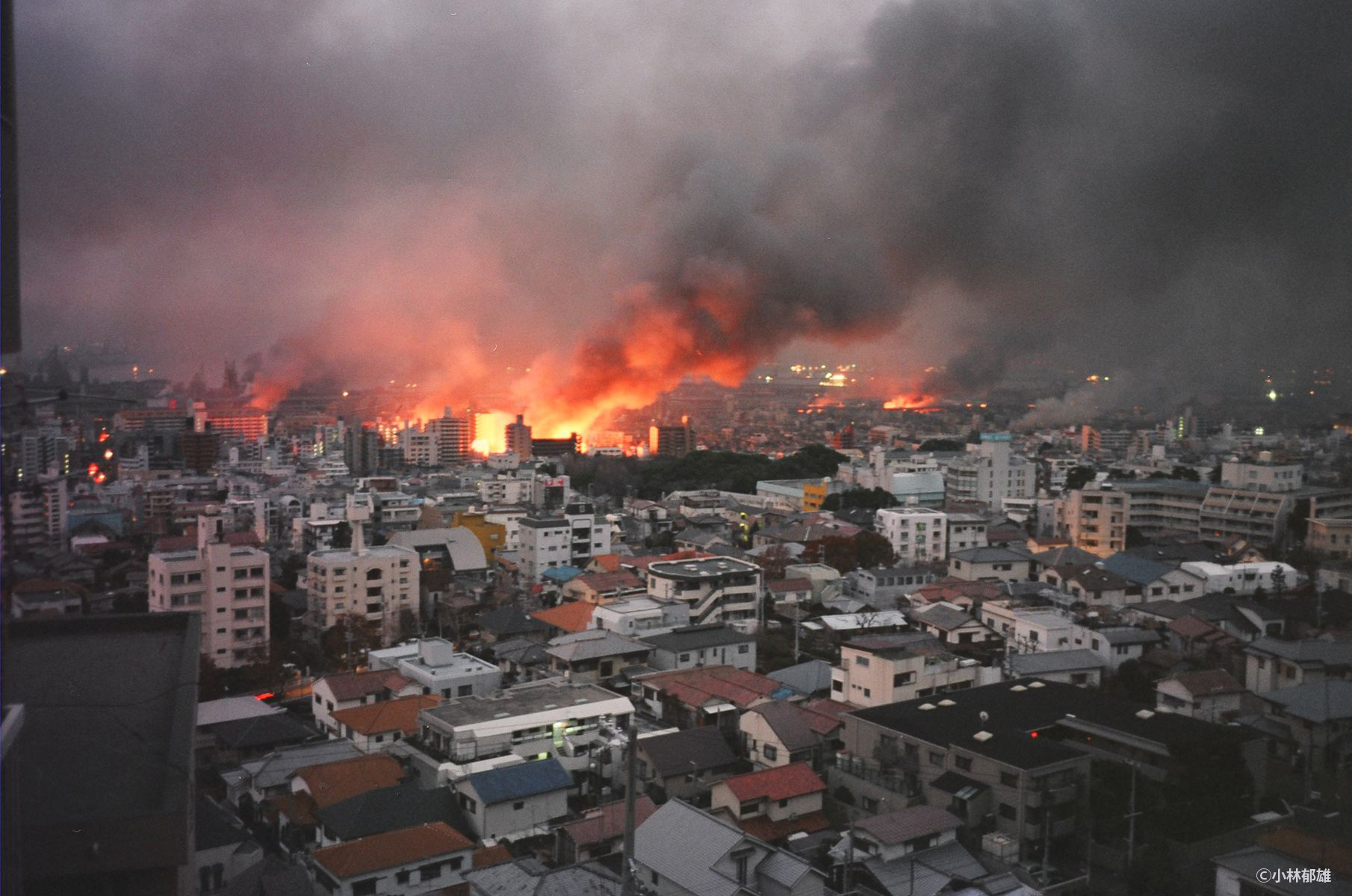
Fires broke out in many places after the earthquake.
17 January 1995, around 7.00 am
(Photograph supplied by Ikuo Kobayashi, DRI senior researcher)
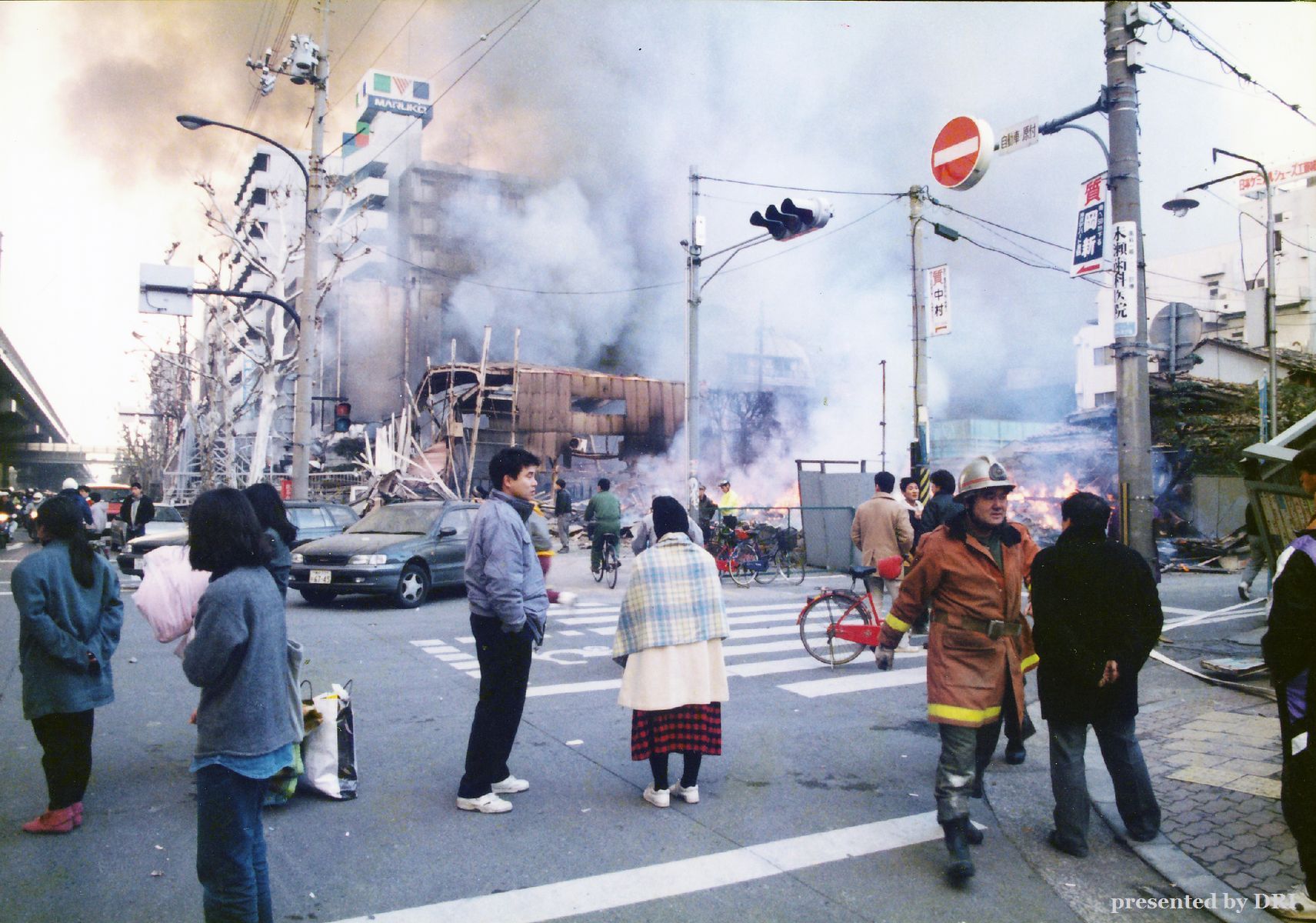
Area damaged by fire. Heavy fire damage occurred in the area around Nagata Ward in Kobe City, which has a high concentration of wooden houses.
Kobe City, Nagata Ward, 17 January 1995.
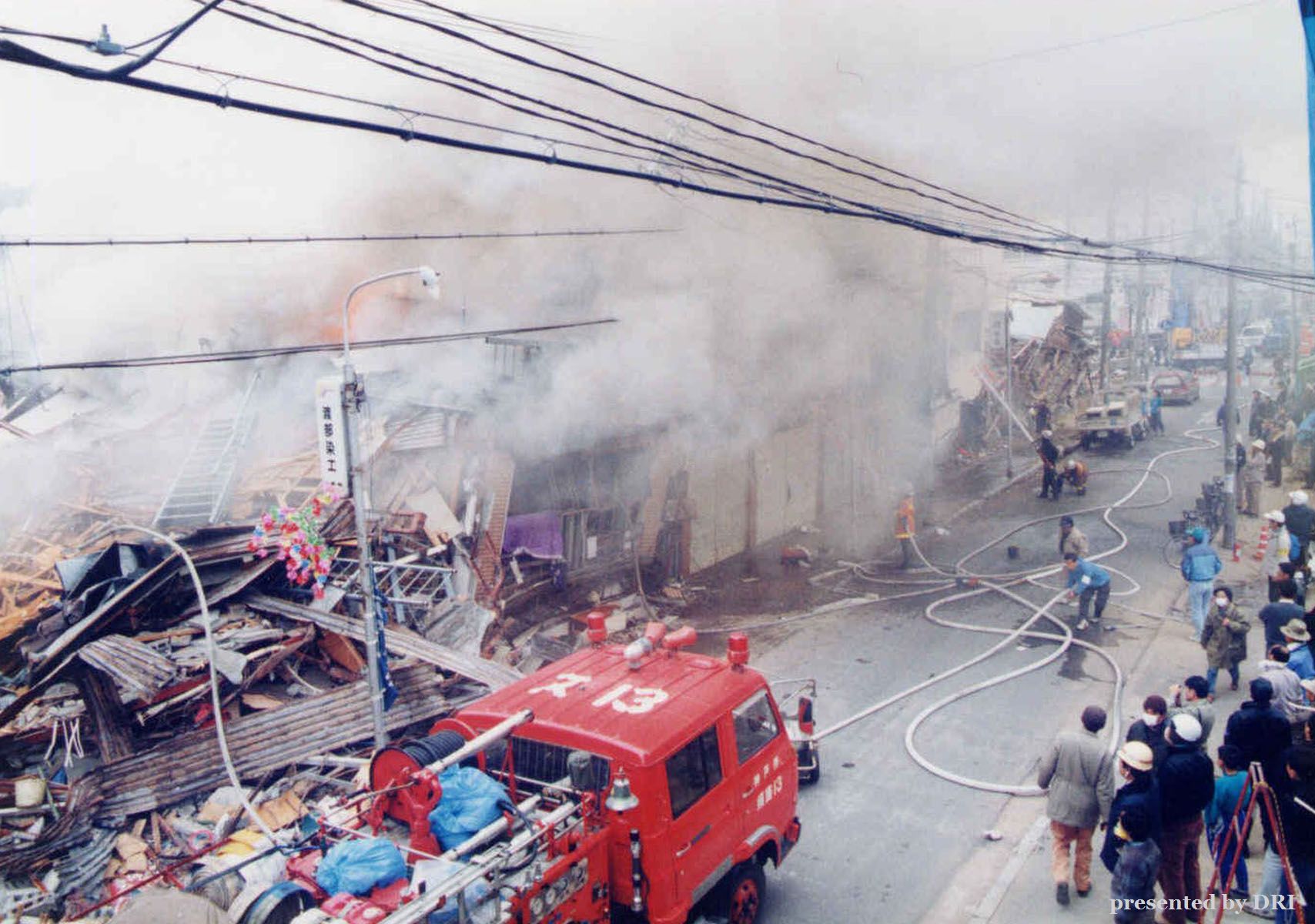
Extinguishing fires. Broken water pipes, multiple fires and fallen buildings blocking roads prevented adequate firefighting in many cases.
Kobe City, Nagata Ward, 17 January 1995.
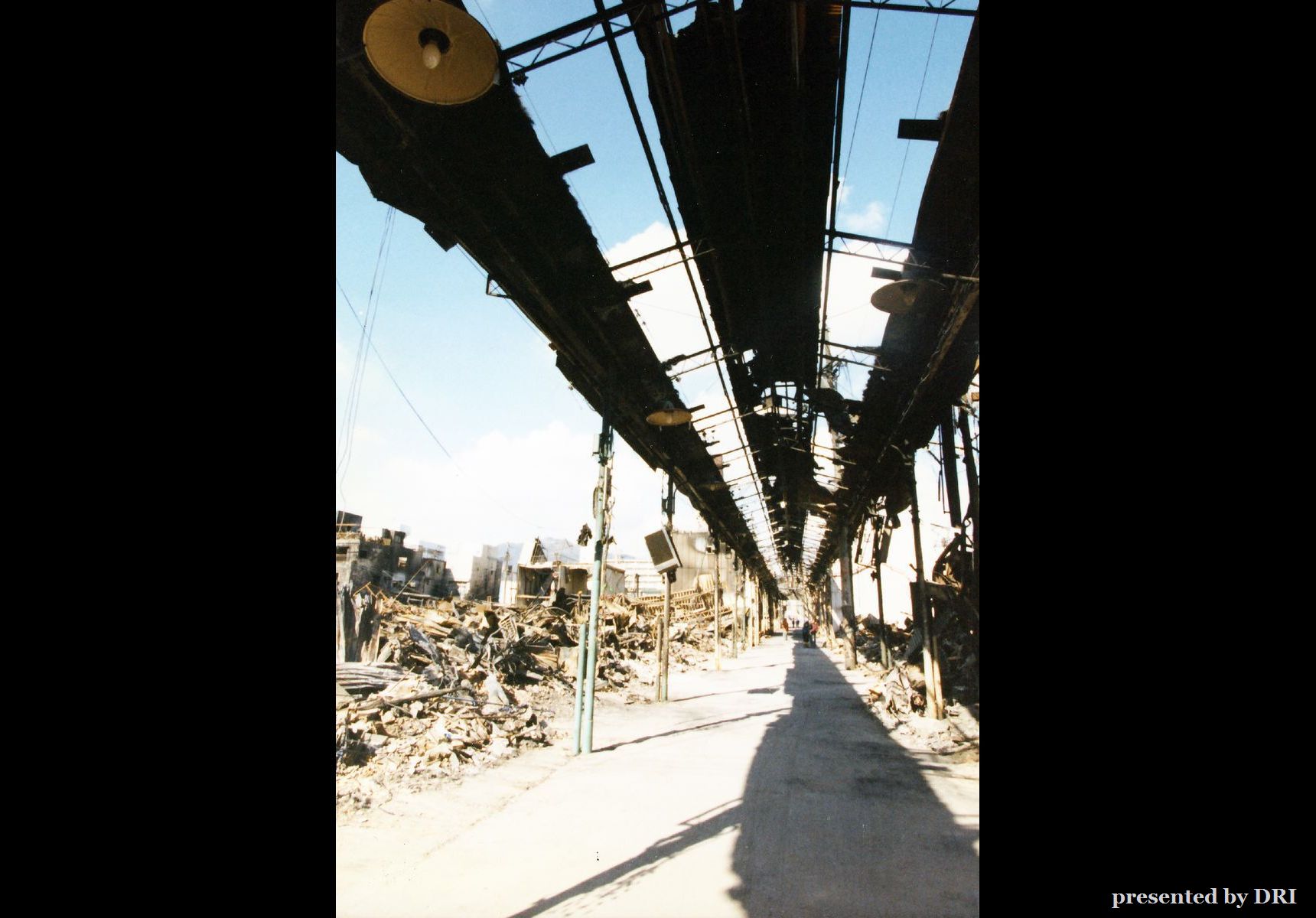
Fire damaged shopping arcade. The sky is visible through what is left of the roof.
Kobe City, Suma Ward, 17 January 1995.
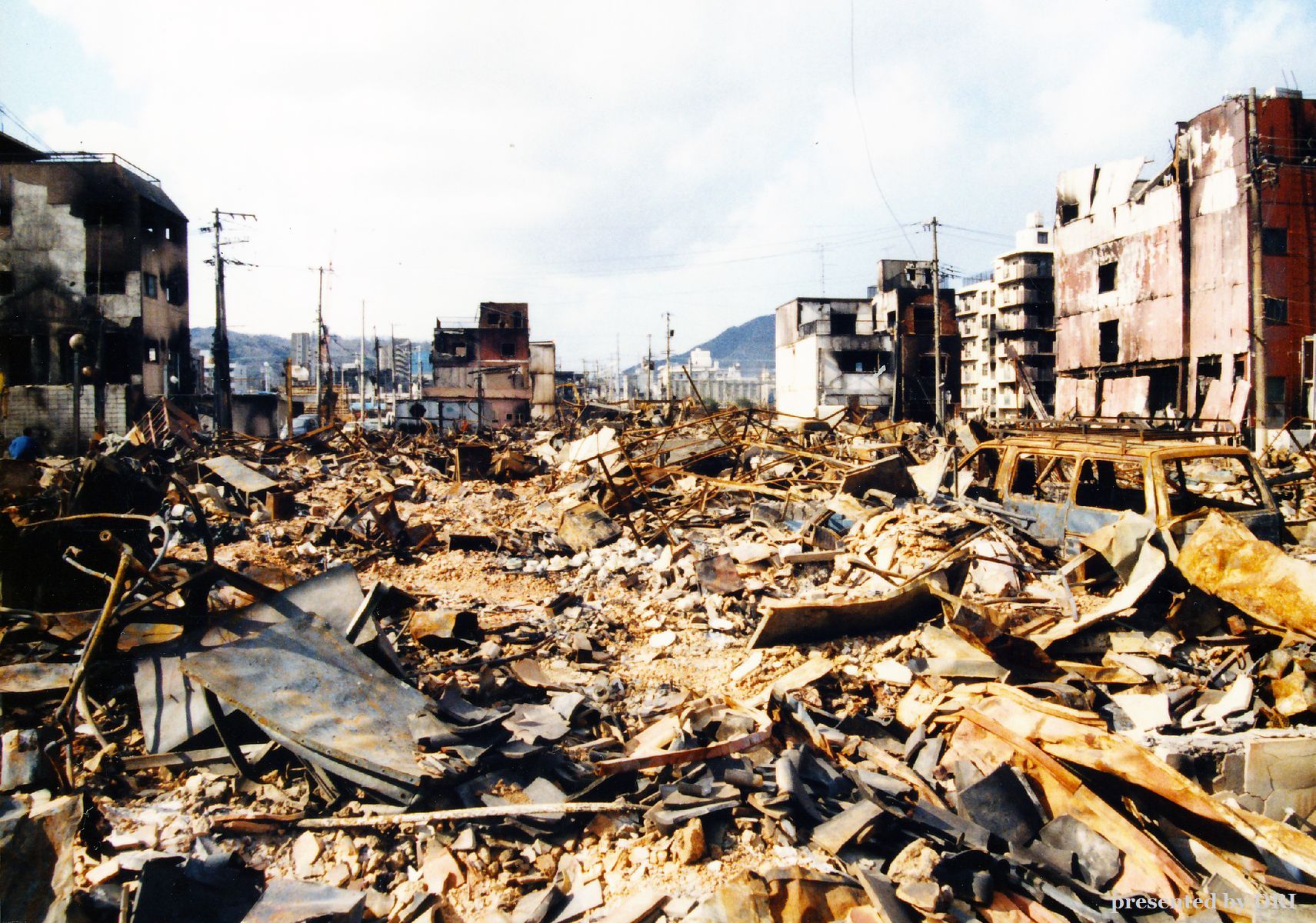
Fire damage in Nagata Ward one month after the earthquake. Damage is so severe that it is difficult to distinguish between buildings and roads.
Kobe City, Nagata Ward, 21 February 1995.
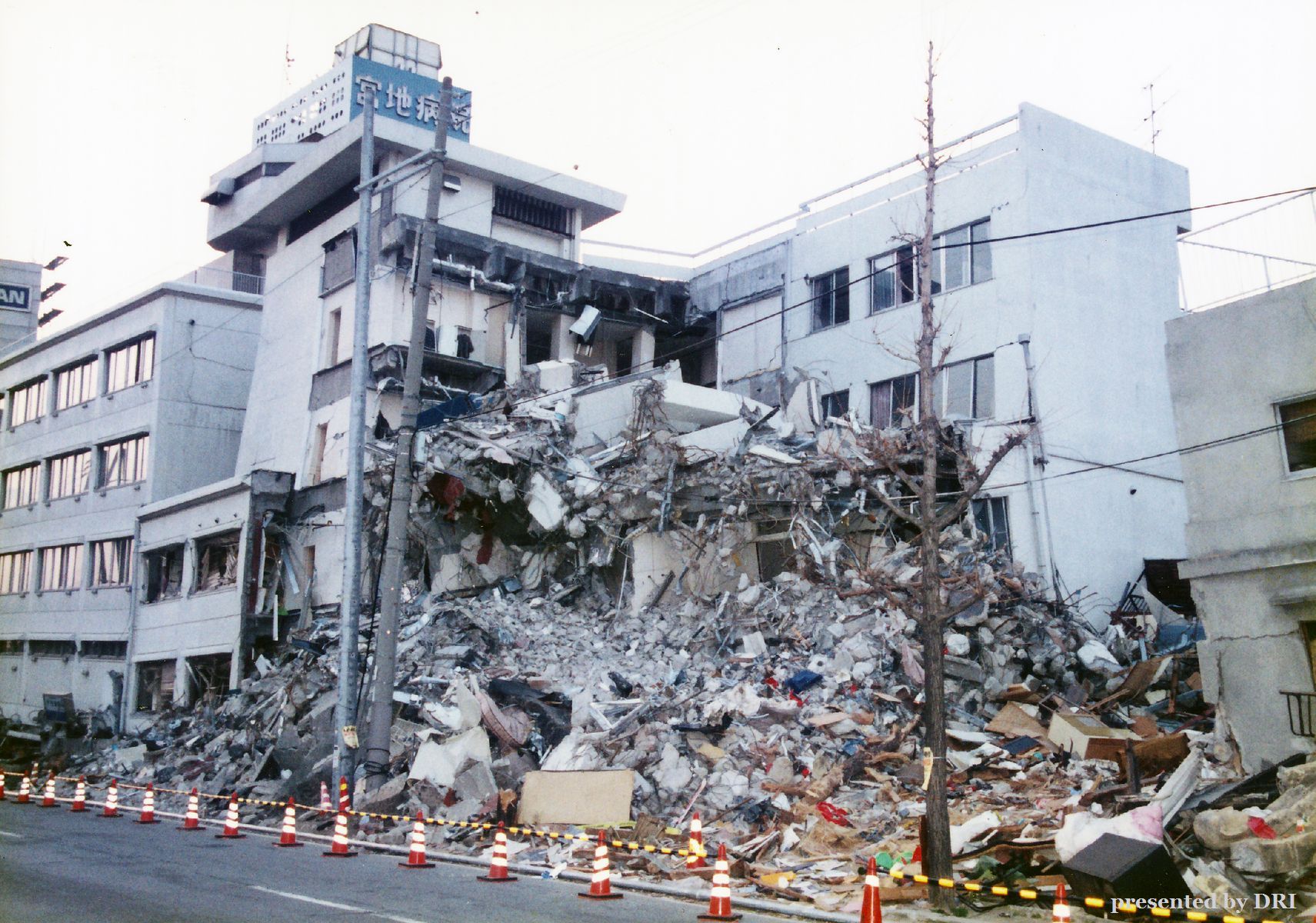
Collapsed hospital. Even if hospitals had not collapsed, electricity and water supply was cut off, so in some cases, patients who had been brought to the hospital could not be treated adequately.
Kobe City, Higashi Nada Ward, 2 February 1995.
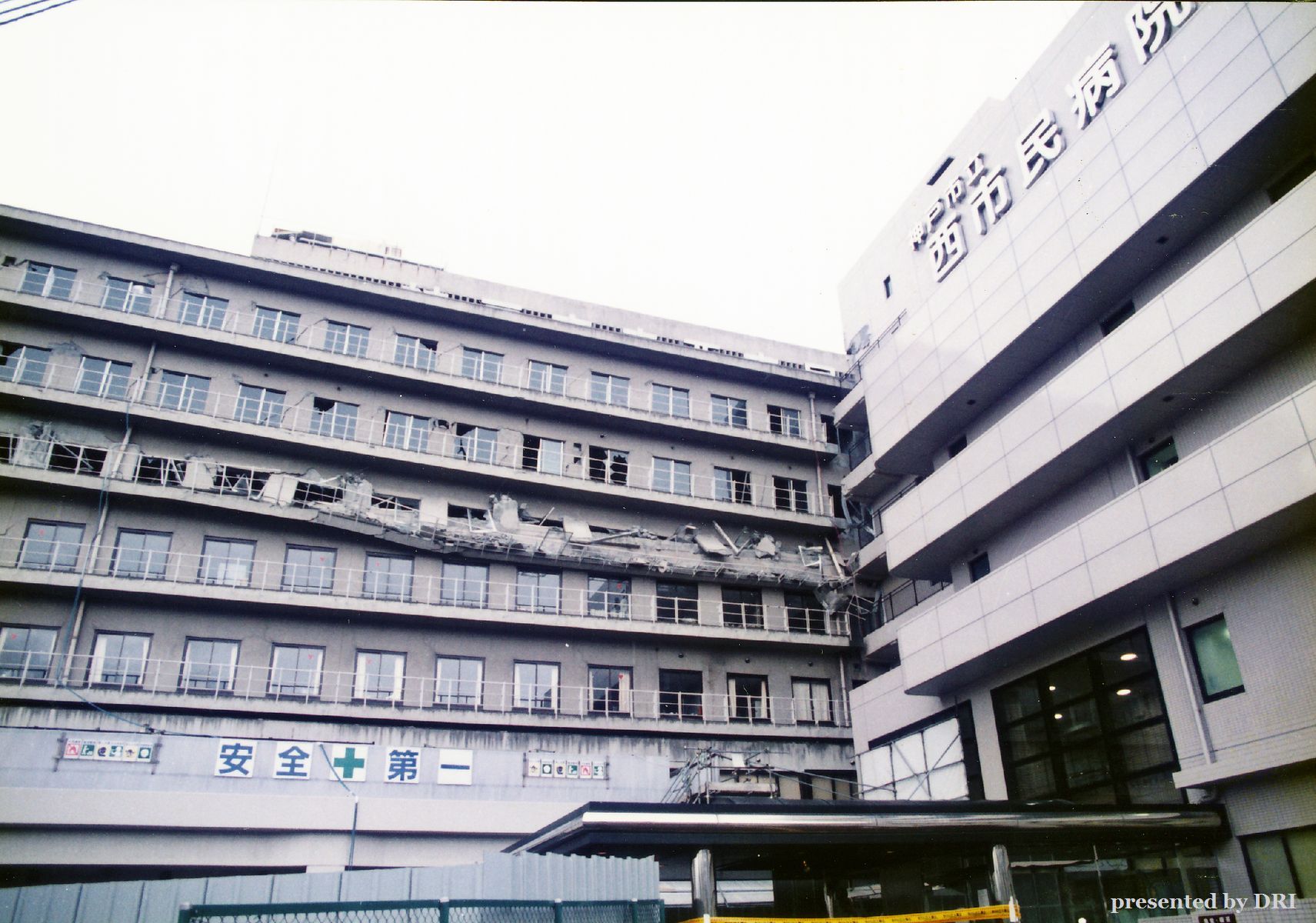
Destroyed main building of West Kobe Hospital. Patients were transferred to other hospitals.
Kobe City, Nagata Ward, 23 February 1995.
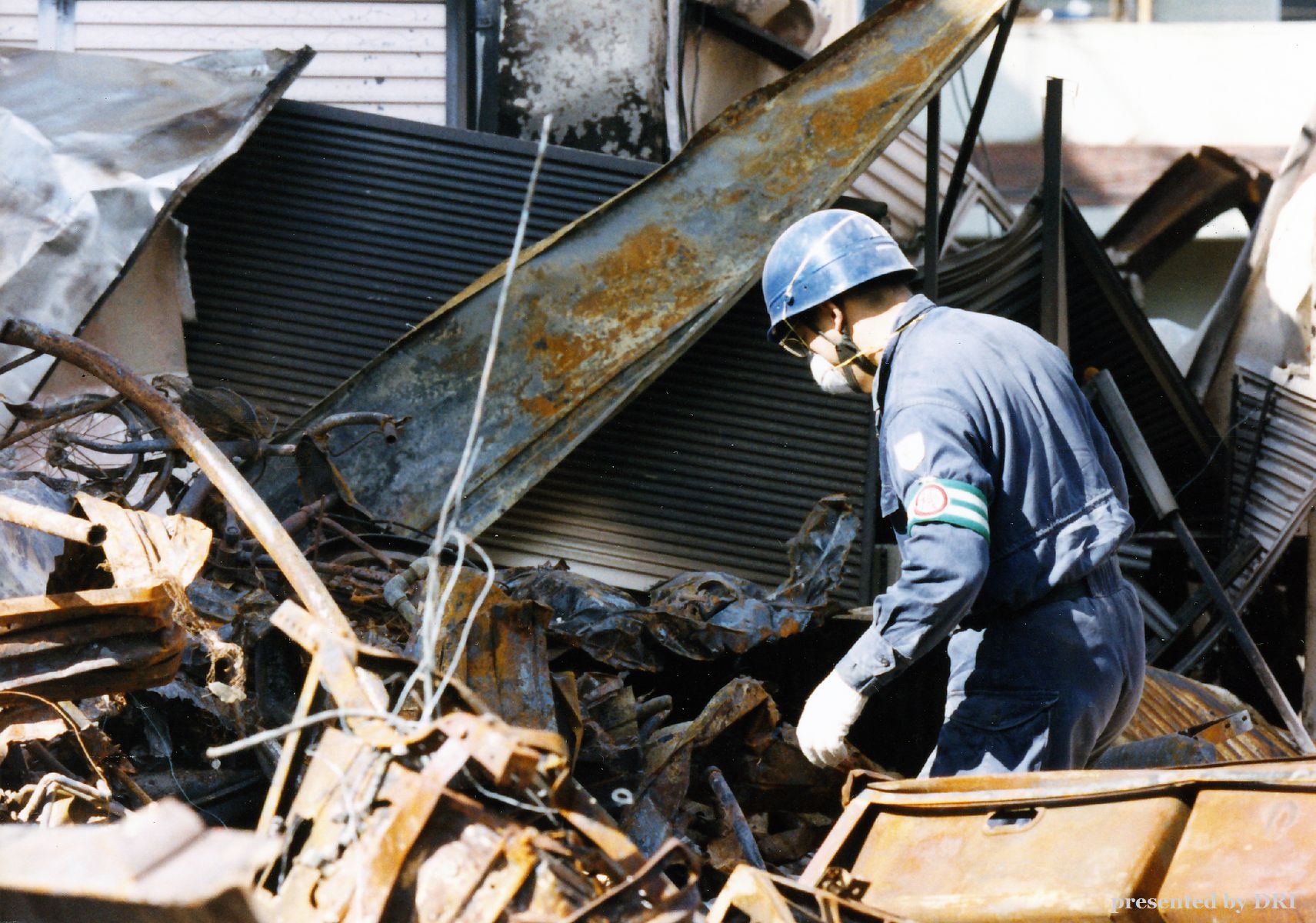
Hyogo Police Force special squad member searching through fire damaged rubble.
Kobe City, Hyogo Ward, 27 January 1995.
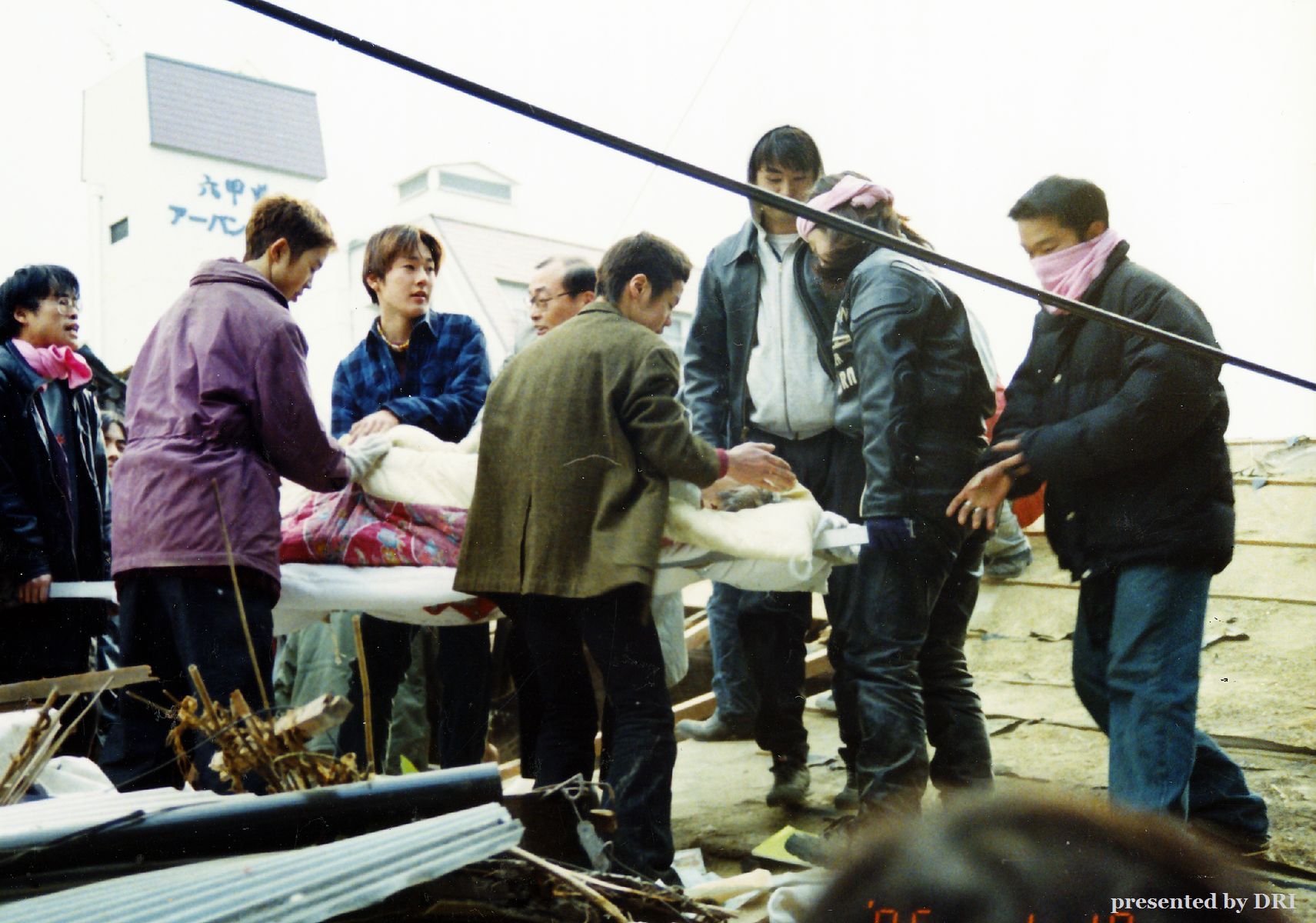
Rescue operations for those who had been buried in collapsed houses. Many of the people pulled from the rubble were rescused by neighbors.
Kobe City, Nada Ward, 17 January 1995.
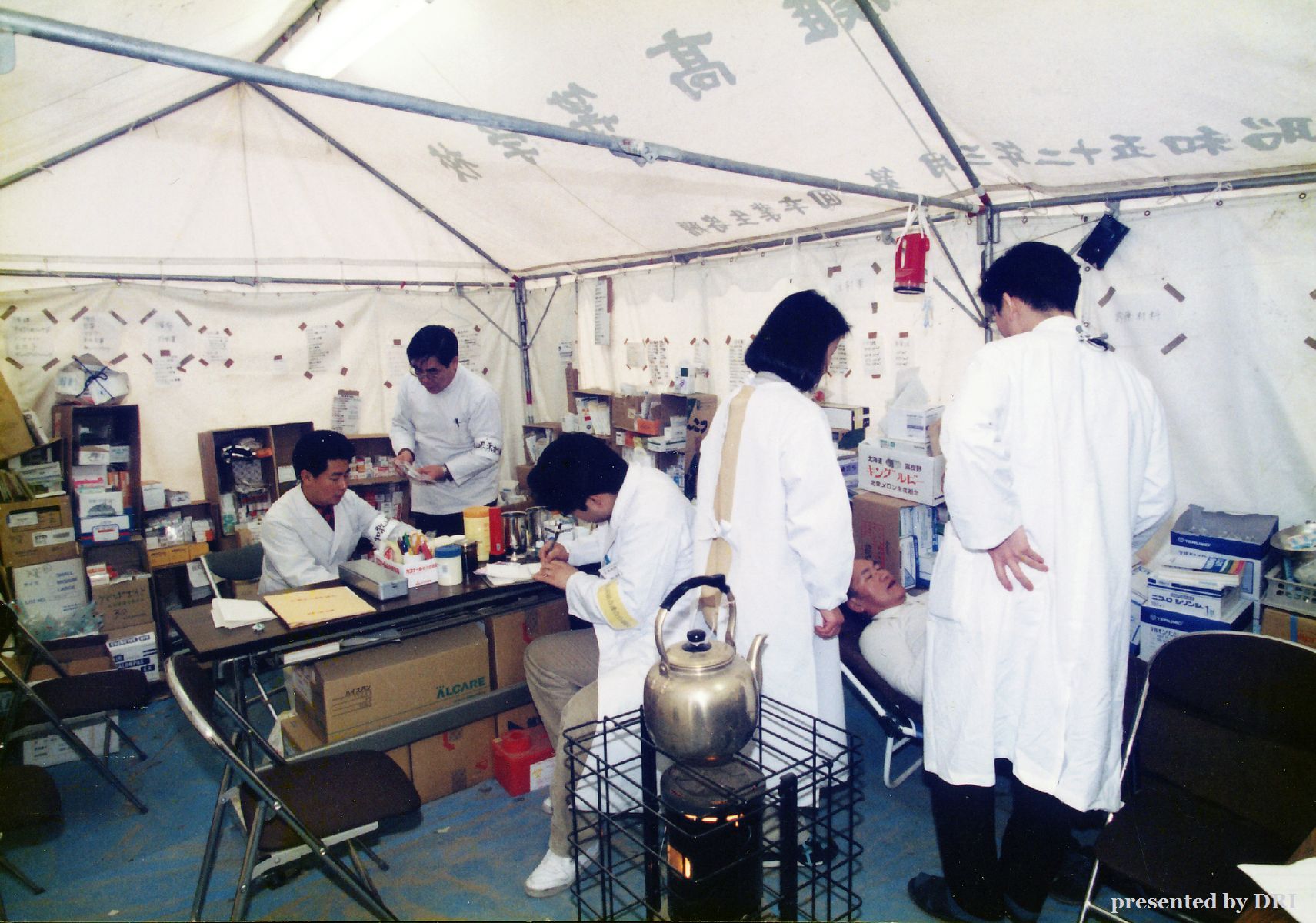
Medical relief in tents set up for disaster victims.
Kobe City, Higashi Nada Ward, 9 February 1995.
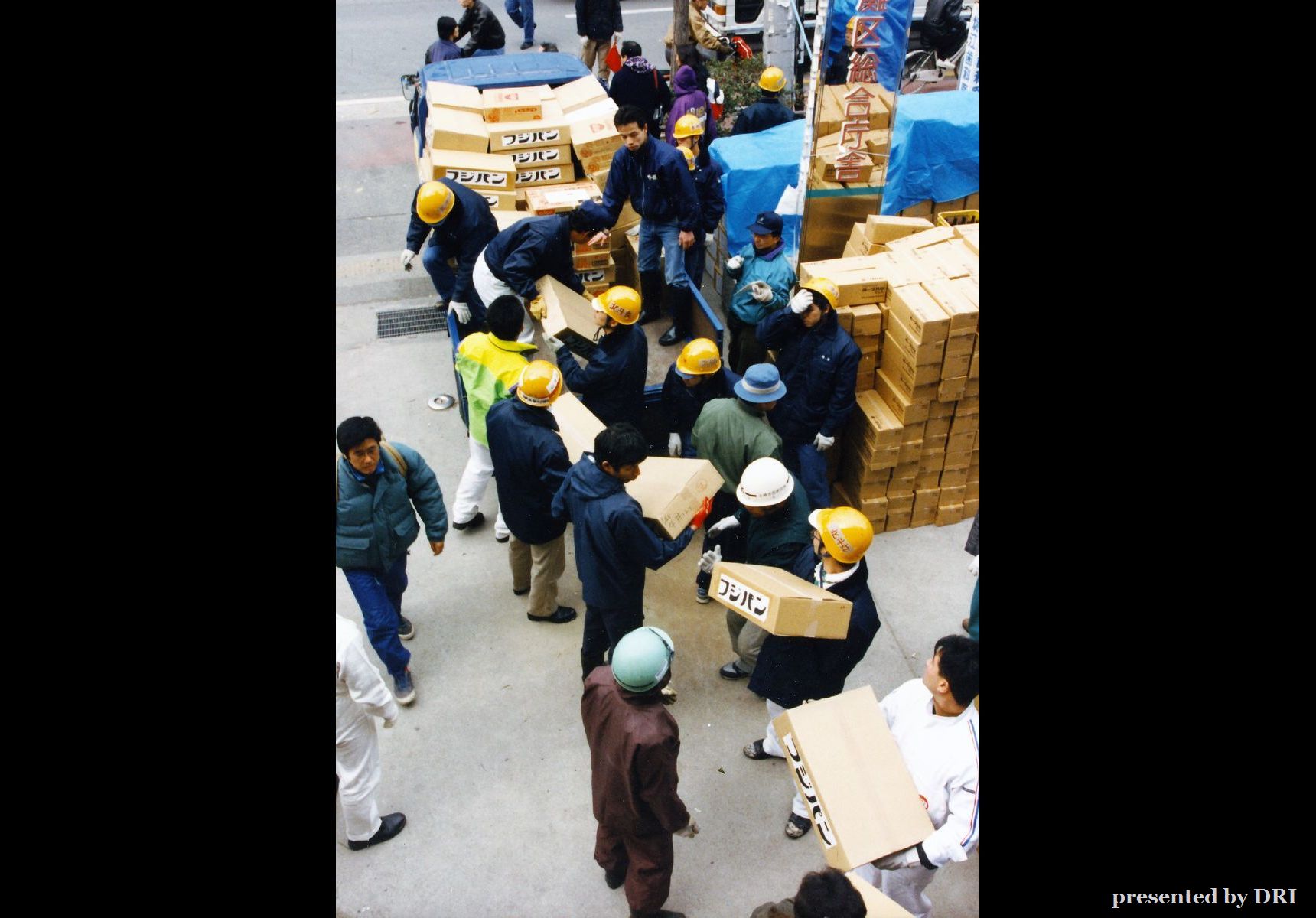
Loading trucks with relief goods at the City Hall.
Kobe City, Higashi Nada Ward. 26 January 1995.
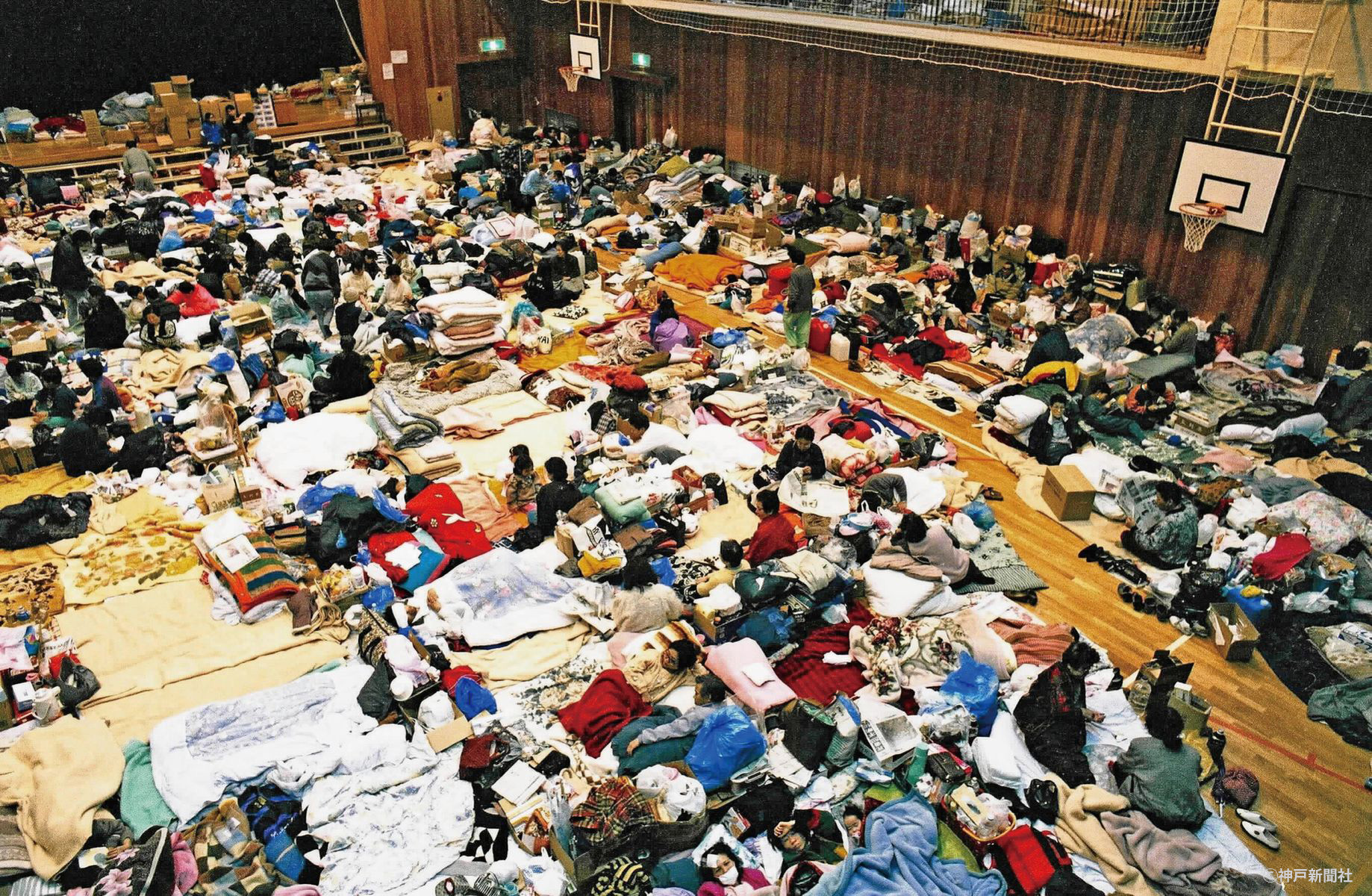
A gymnasium filled with evacuees.
(Photograph supplied by Kobe Shinbun)
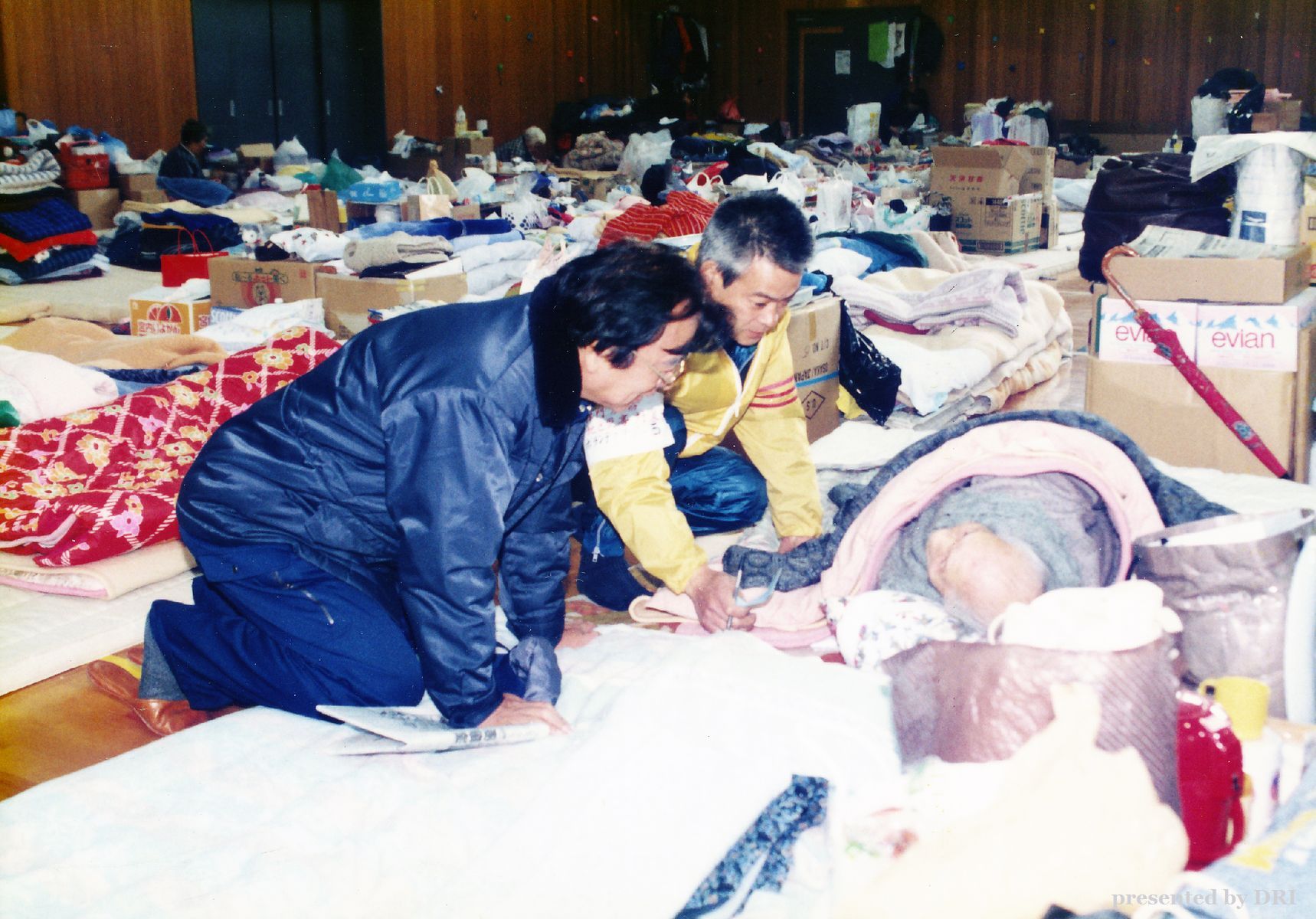
Visiting evacuation centers. Volunteer support for evacuees also expanded.
Nishinomiya City, 17 February 1995.
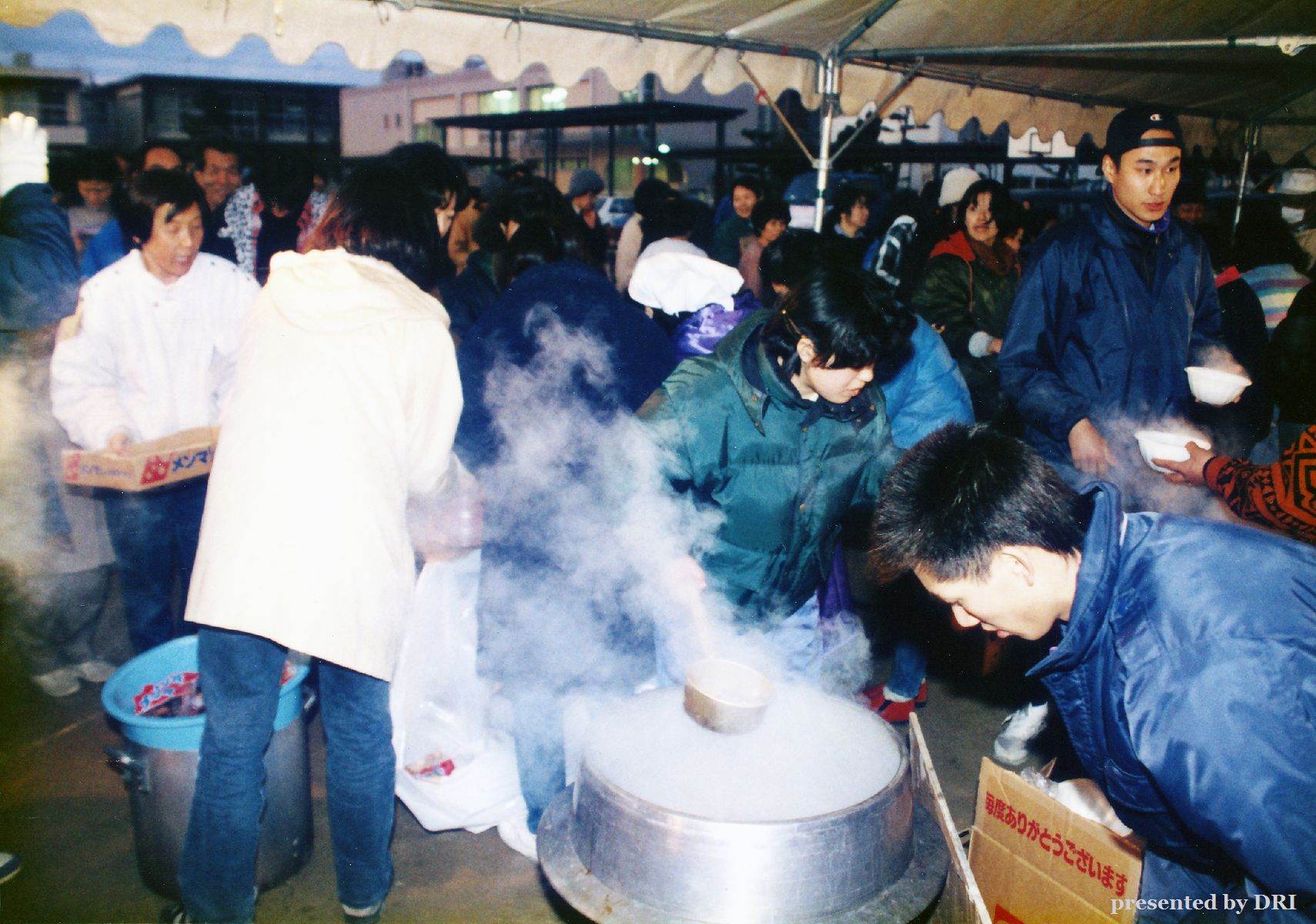
Preparing and distributing warm soup. One month after the earthquake.
Nishinomiya City, 17 February 1995.
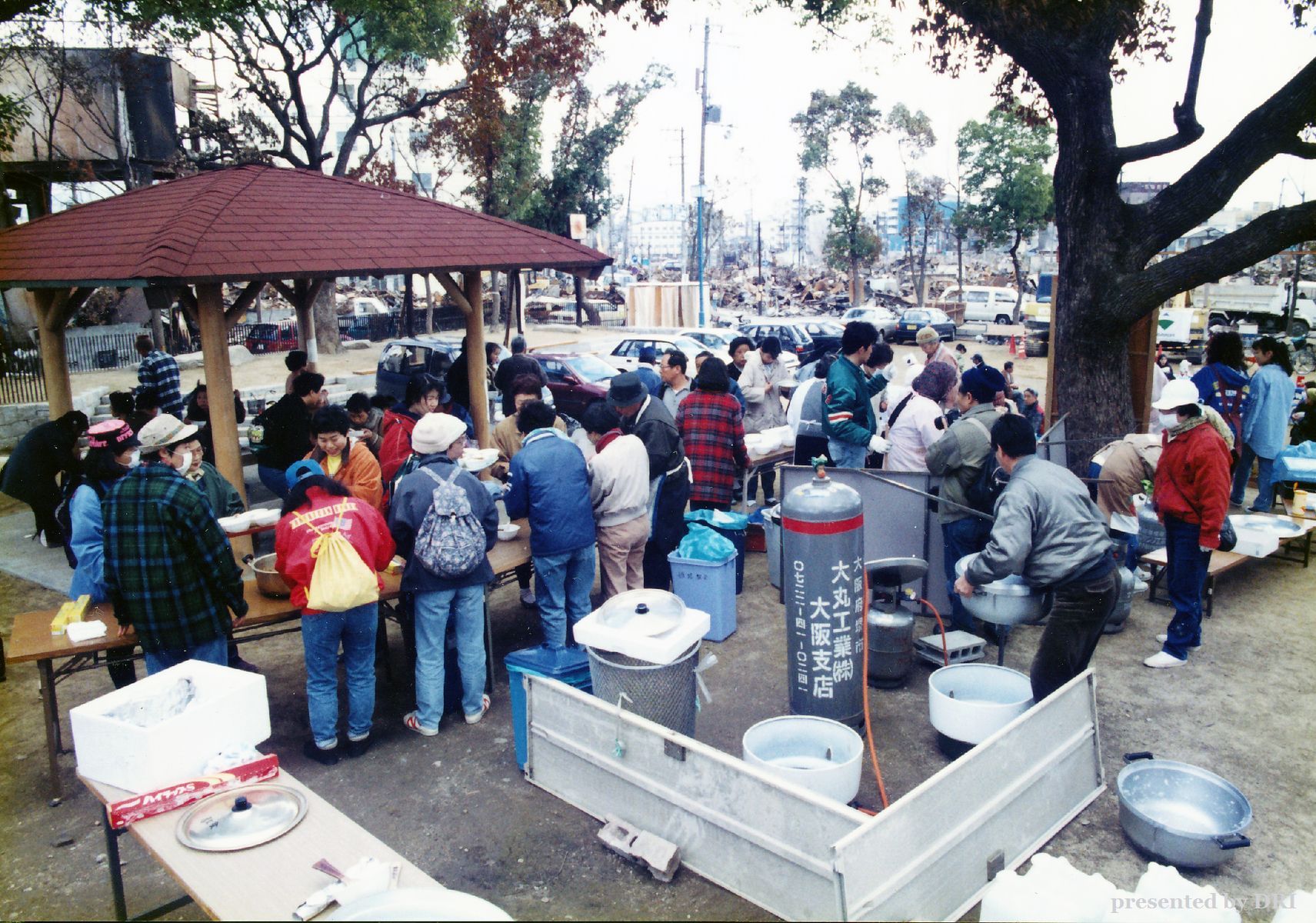
Preparing food in a park which became an evacuation center. In the background you can see the tragic state of the surrounding city.
Kobe City, Nagata Ward, 26 January 1995.
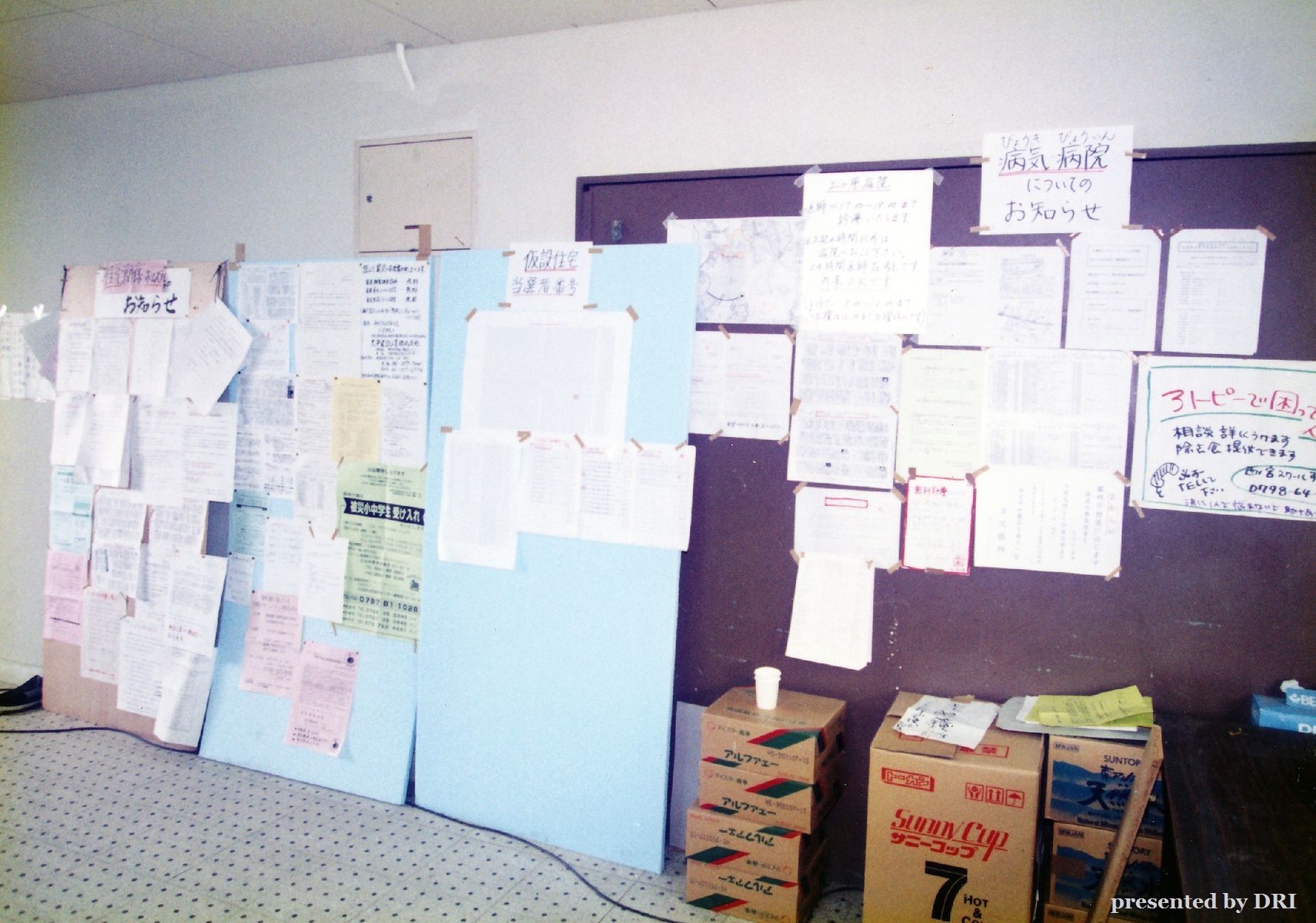
Information and notices in the evacuation center. The numbers drawn in the lottery for temporary housing are also pinned up.
Kobe City, Higashi Nada Ward, 9 February 1995.
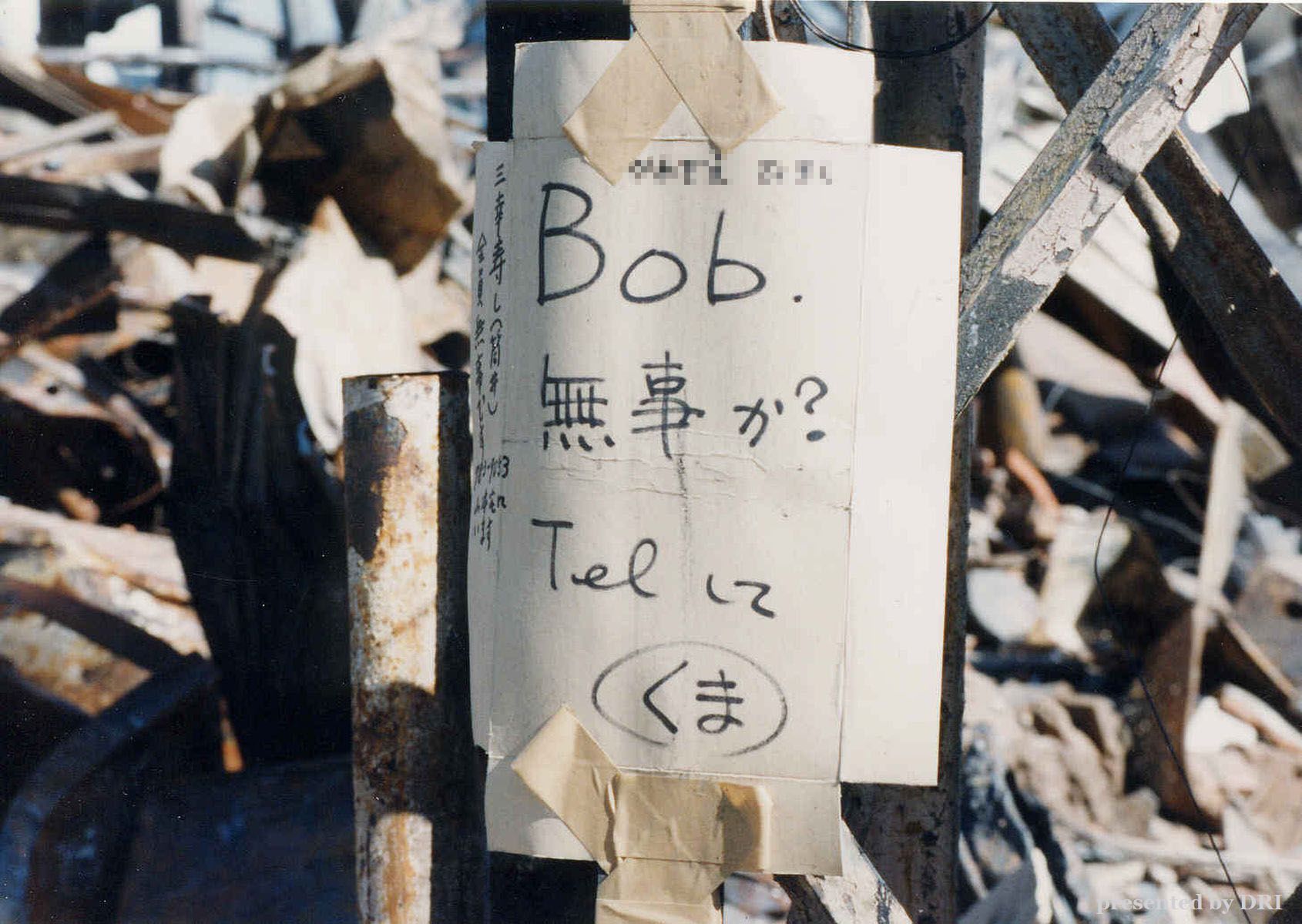
Notice board, in the burnt-out ruins, displaying information about survivors.
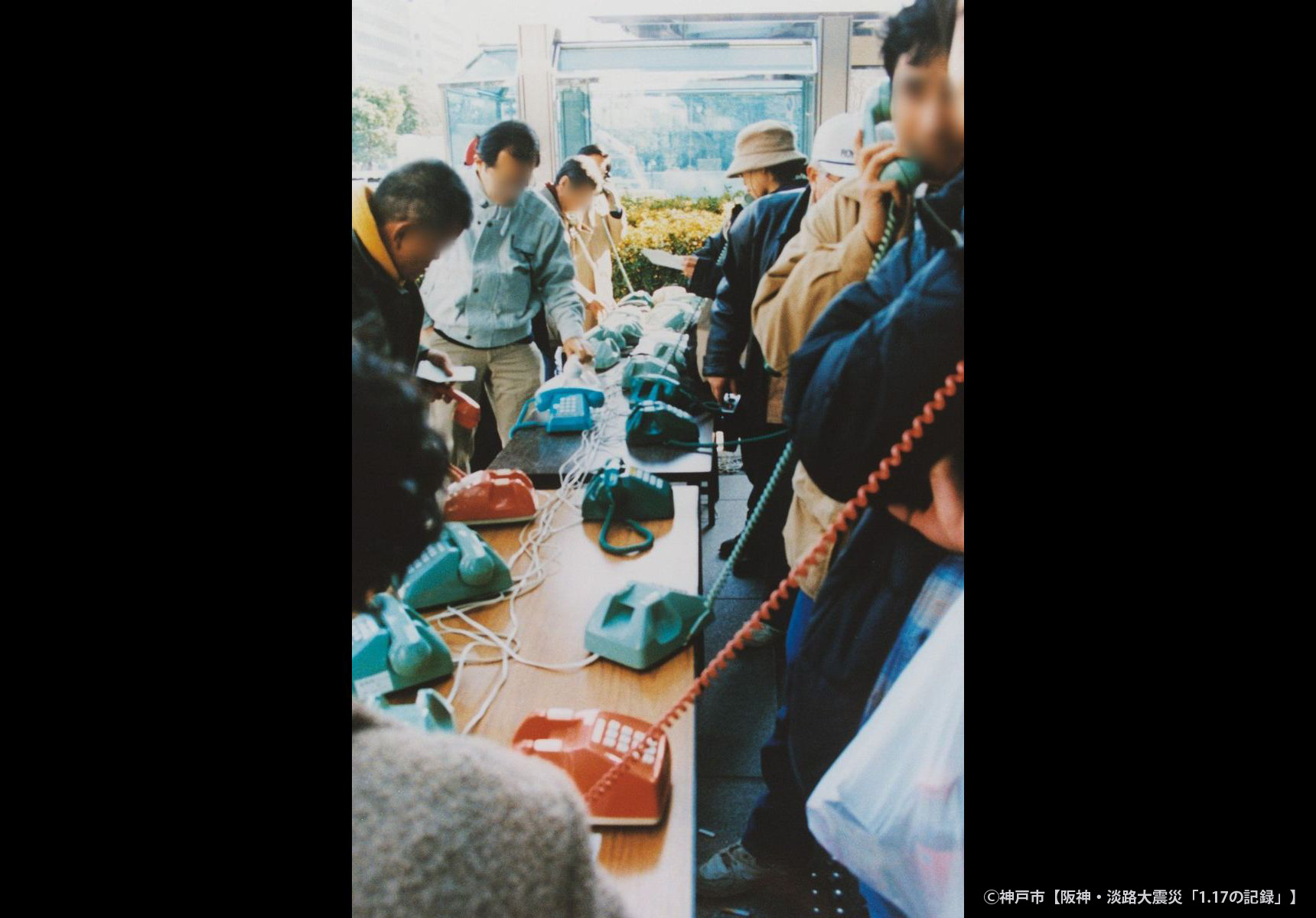
Home telephones were not connecting, and long lines formed at the temporary phones which were set up.
(Photograph supplied by Kobe City "The Great Hanshin Awaji Earthquake 1.17 Archives."
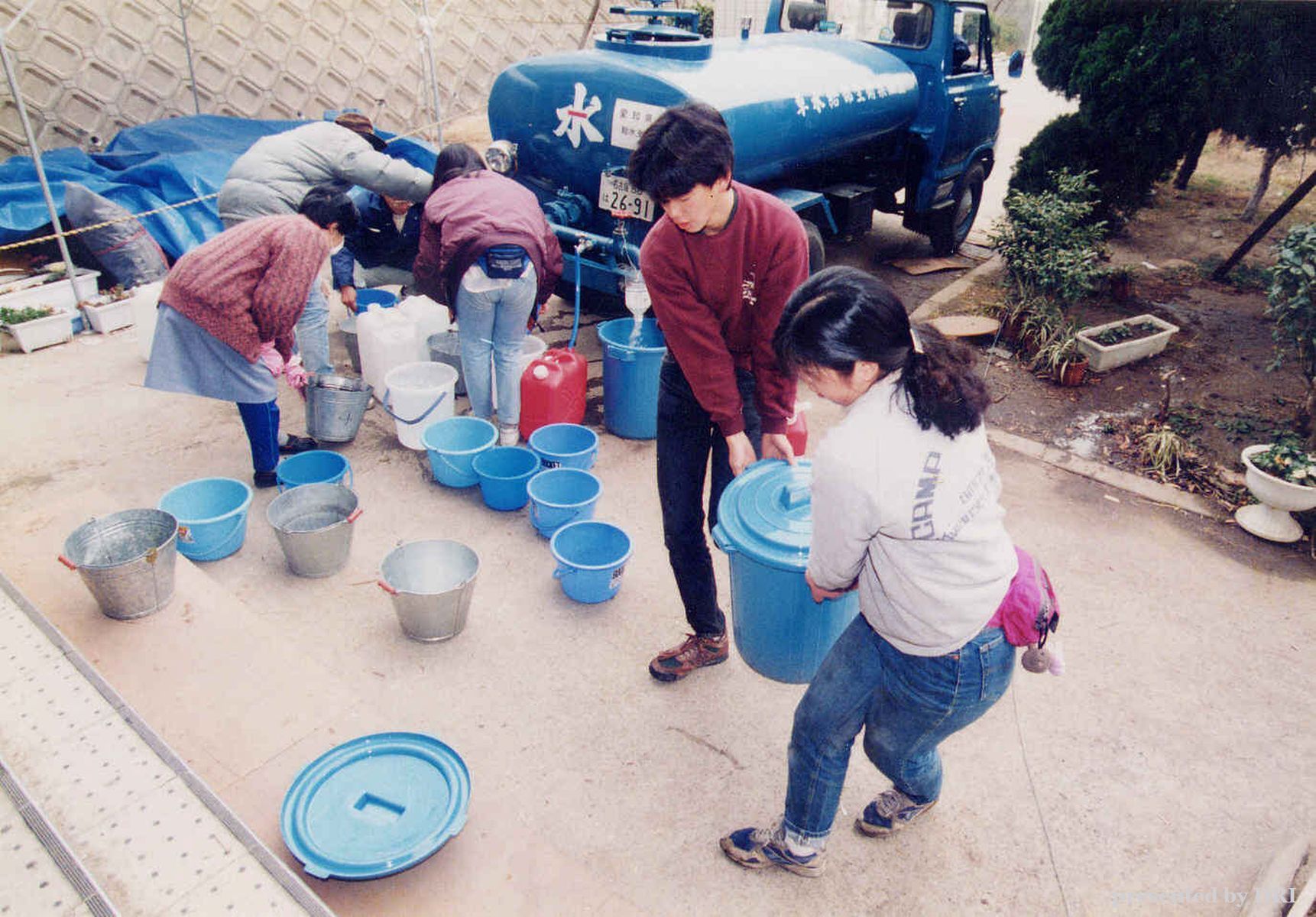
People cooperating to carry the water delivered by water tankers, as the water pipes were broken.
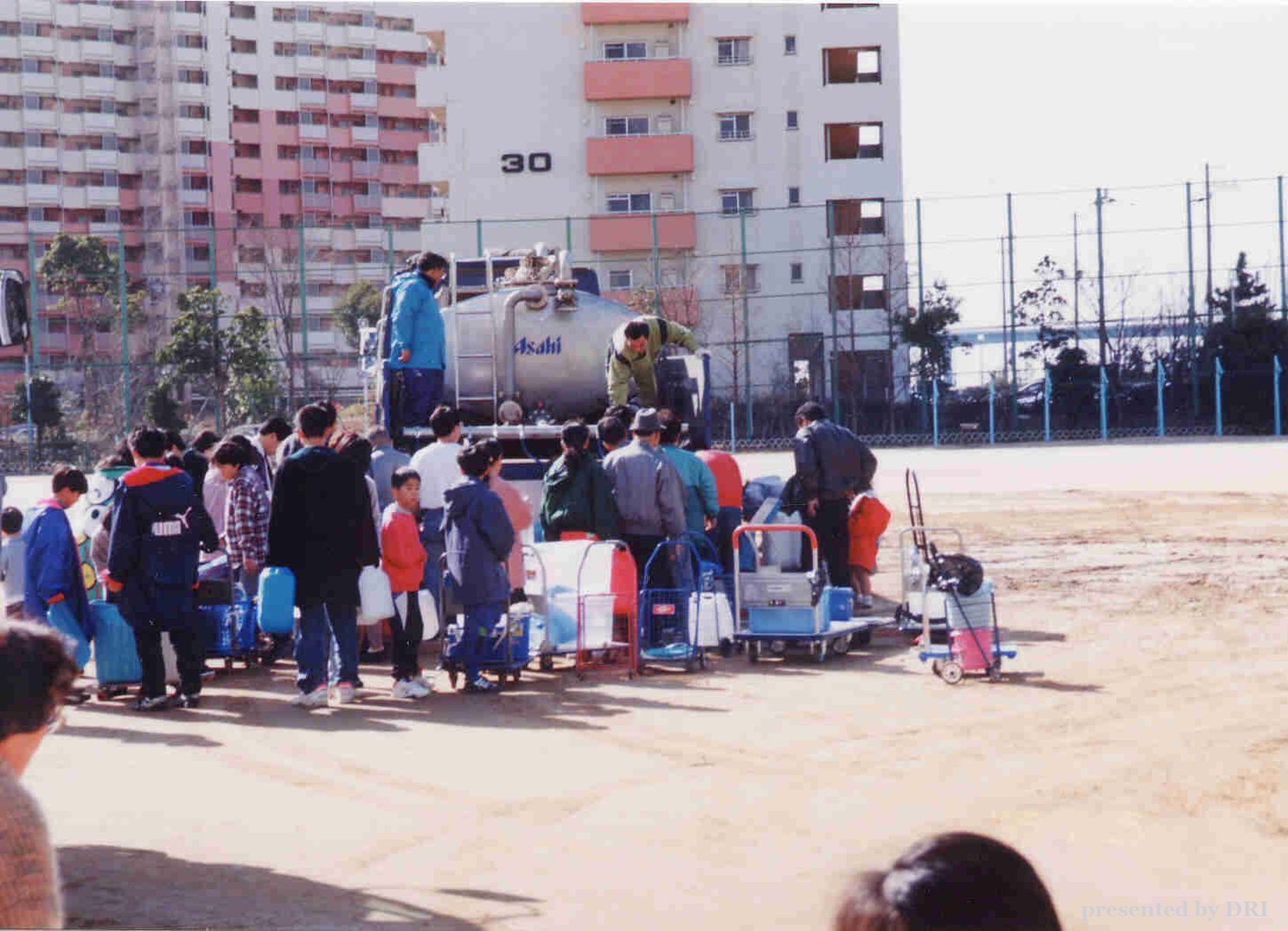
Delivering water to a primary school which had become an evacuation center.
Kobe City, Nada Ward, 25 January 1995.
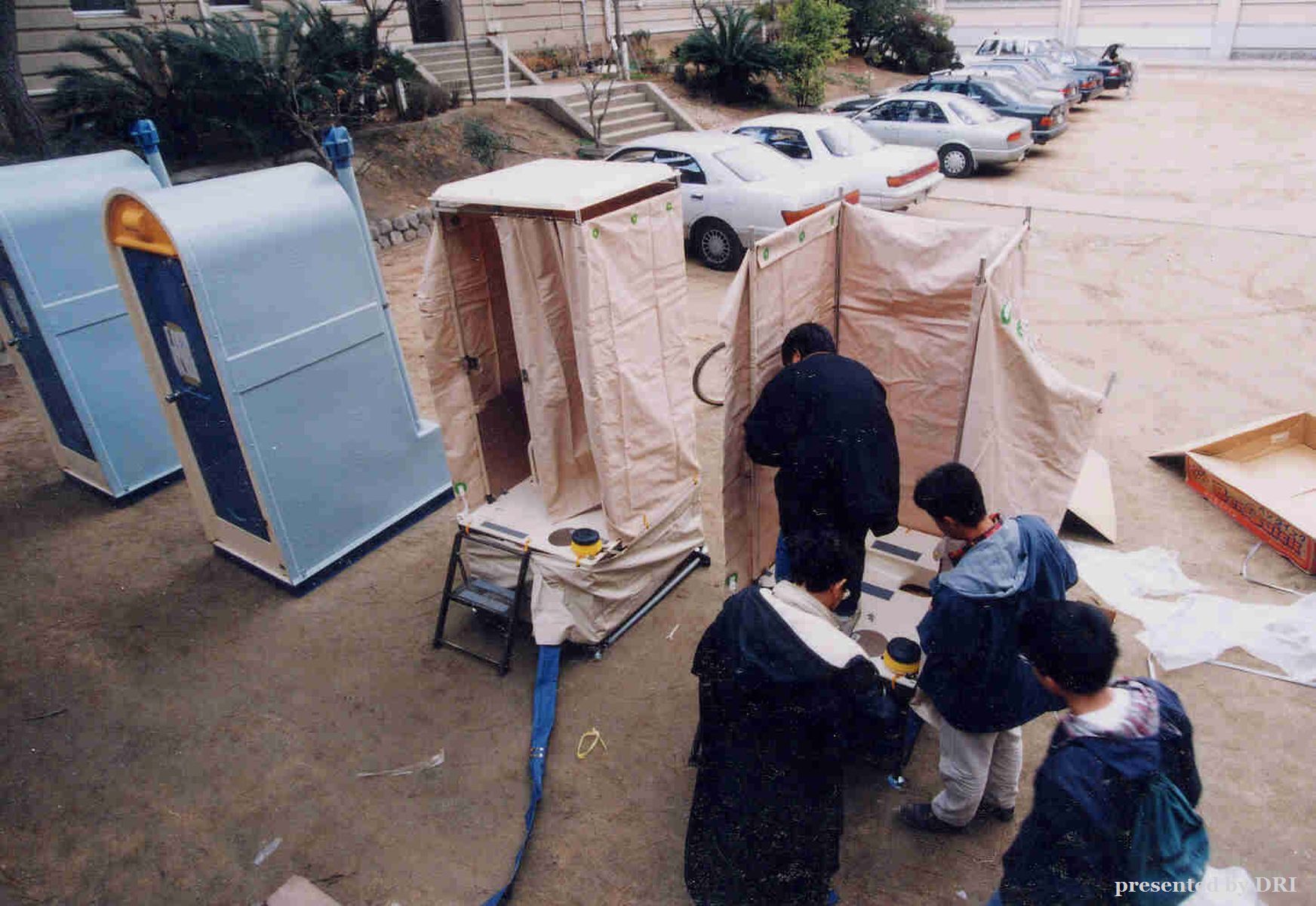
Emergency toilets set up in a school which had become an evacuation center. Not being able to use flush toilets was a big problem for a long time.
Kobe City, Nada Ward, January 1995.

A temporary bath set up by the Self Defense Force (SDF) in the grounds of a junior high school.
Nishinomiya City, 3 March 1995.
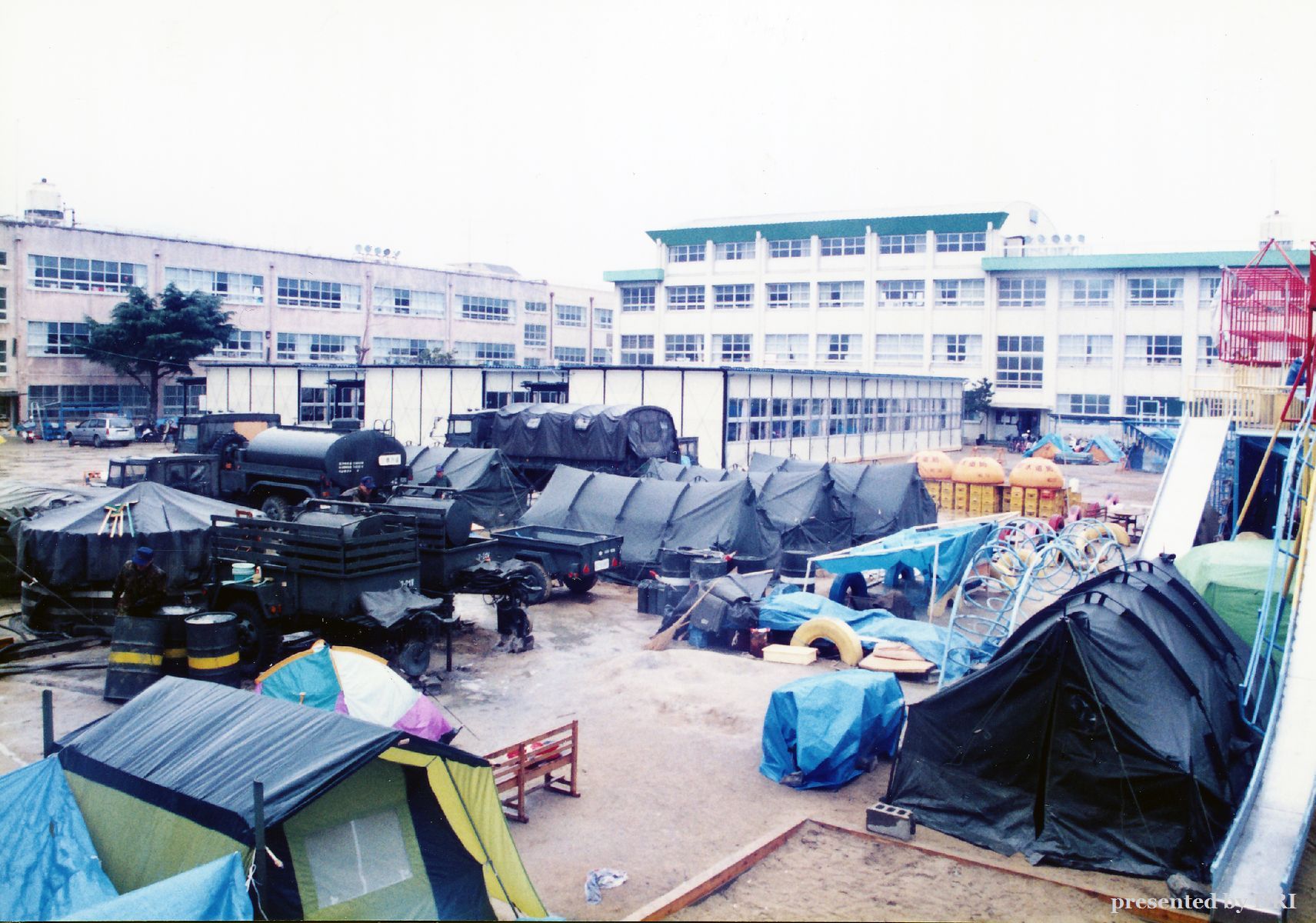
Pre-fab classrroms, SDF equipment and tents are brought to the school grounds.
Kobe City, Higashi Nada Ward, 10 March 1995.
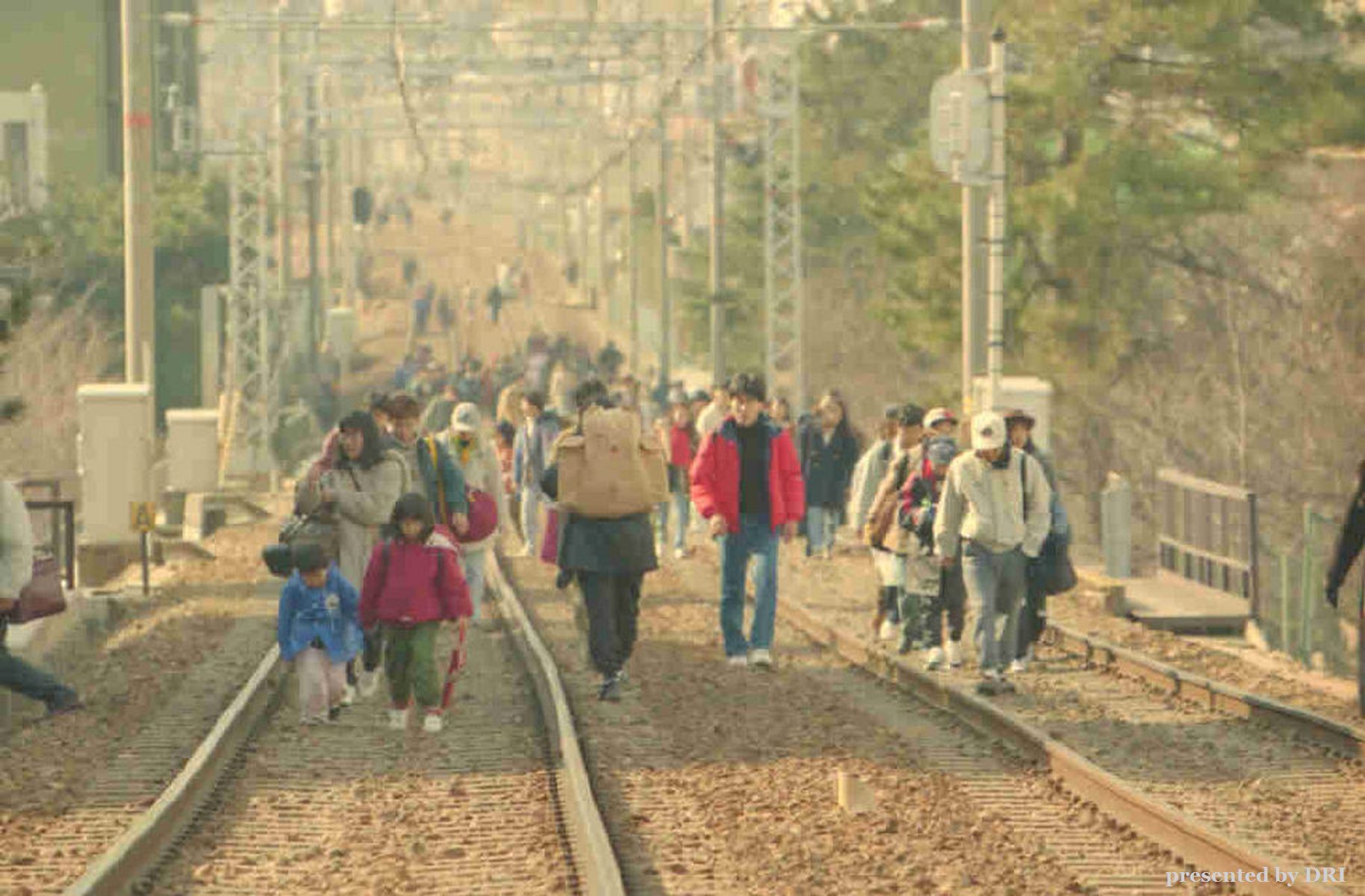
People with backpacks walking on the train lines became one of the iconic images of the disaster affected area.
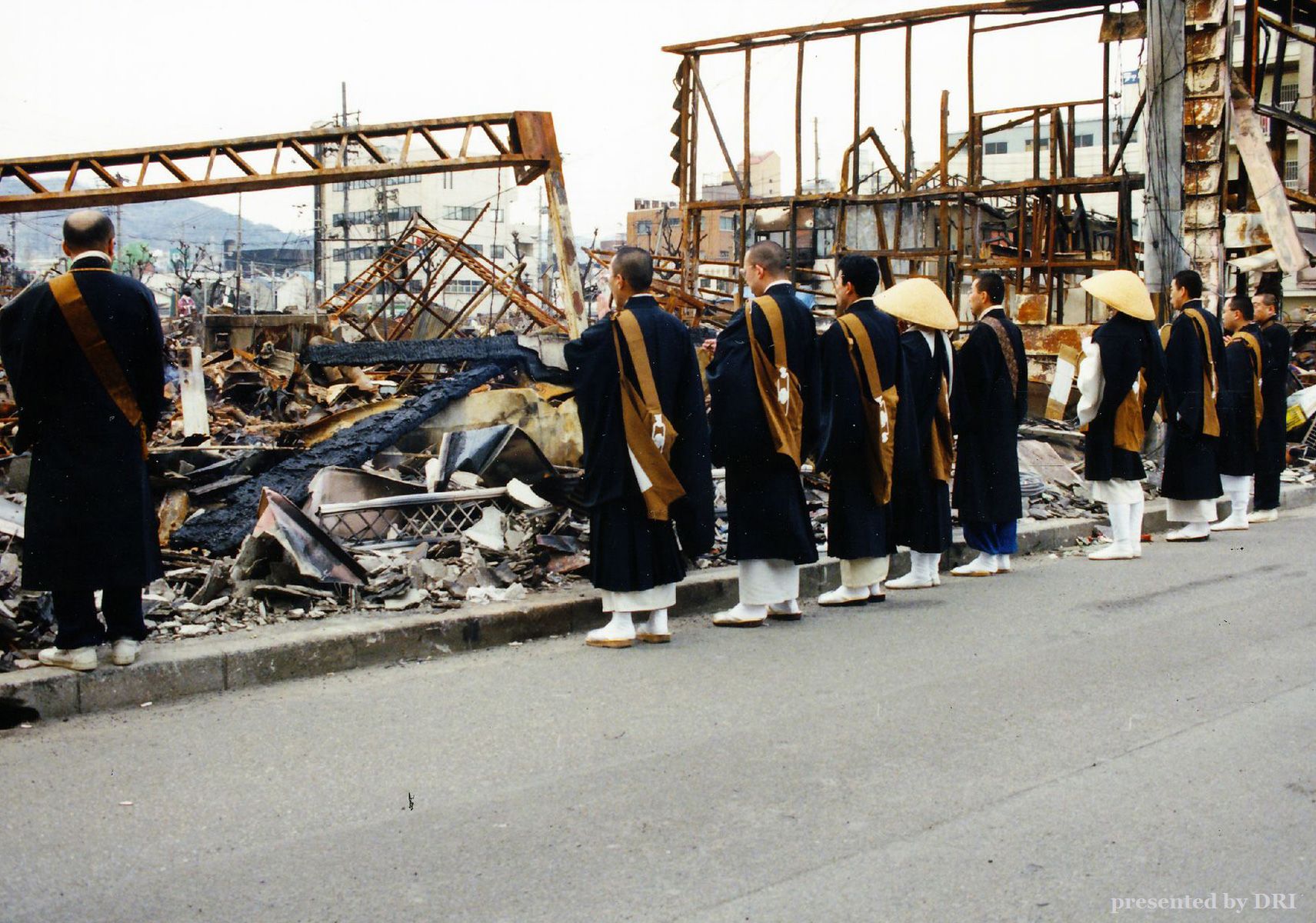
Buddhist service in the burnt ruins. One month after the earthquake.
Kobe City, Nagata Ward, 17 February 1995.
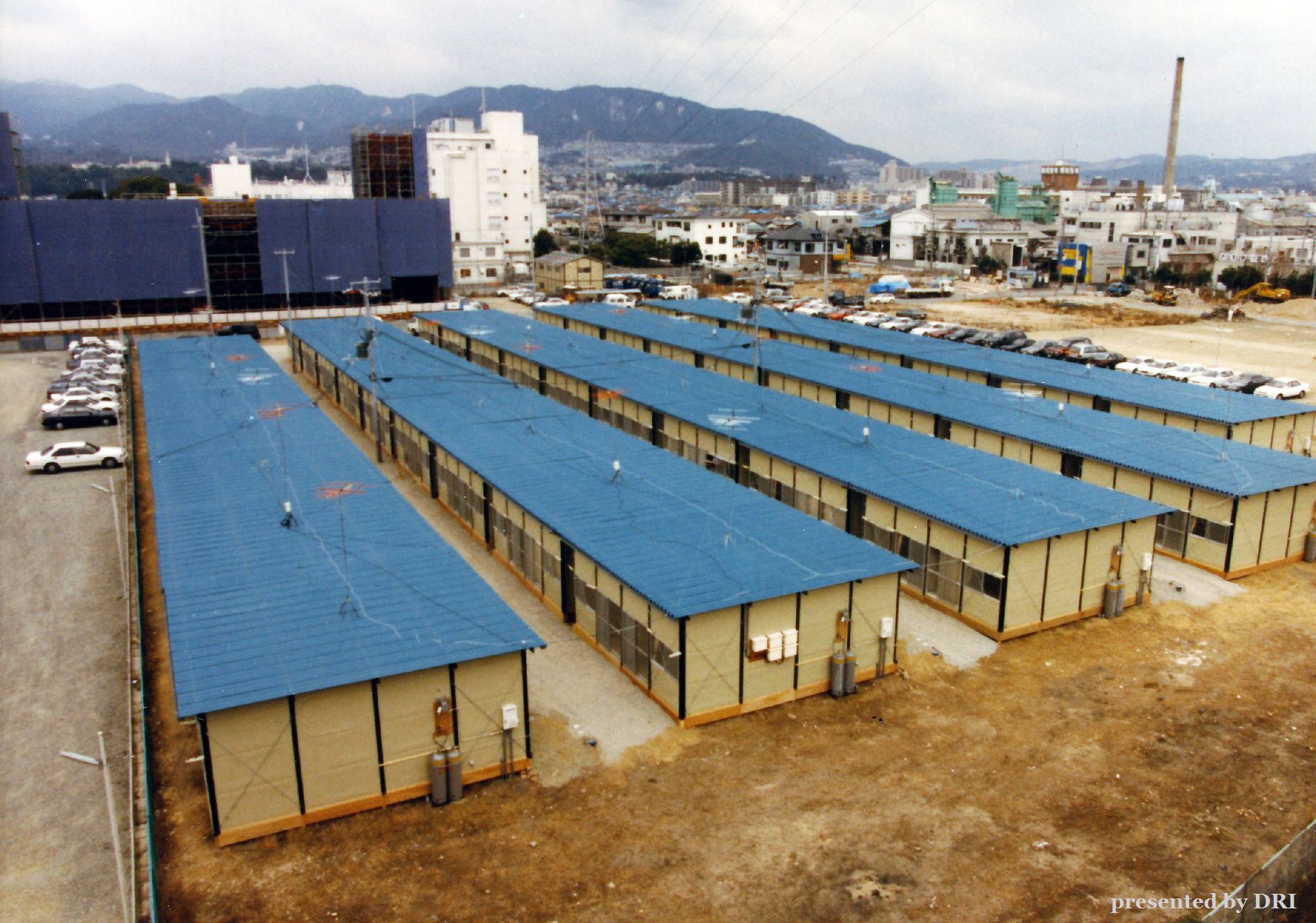
Lines of temporary housing.
Takarazuka City, 7 February 1995.
After being dismantled, temporary housing that could be reused was sent to Turkey after the major earthquake there.
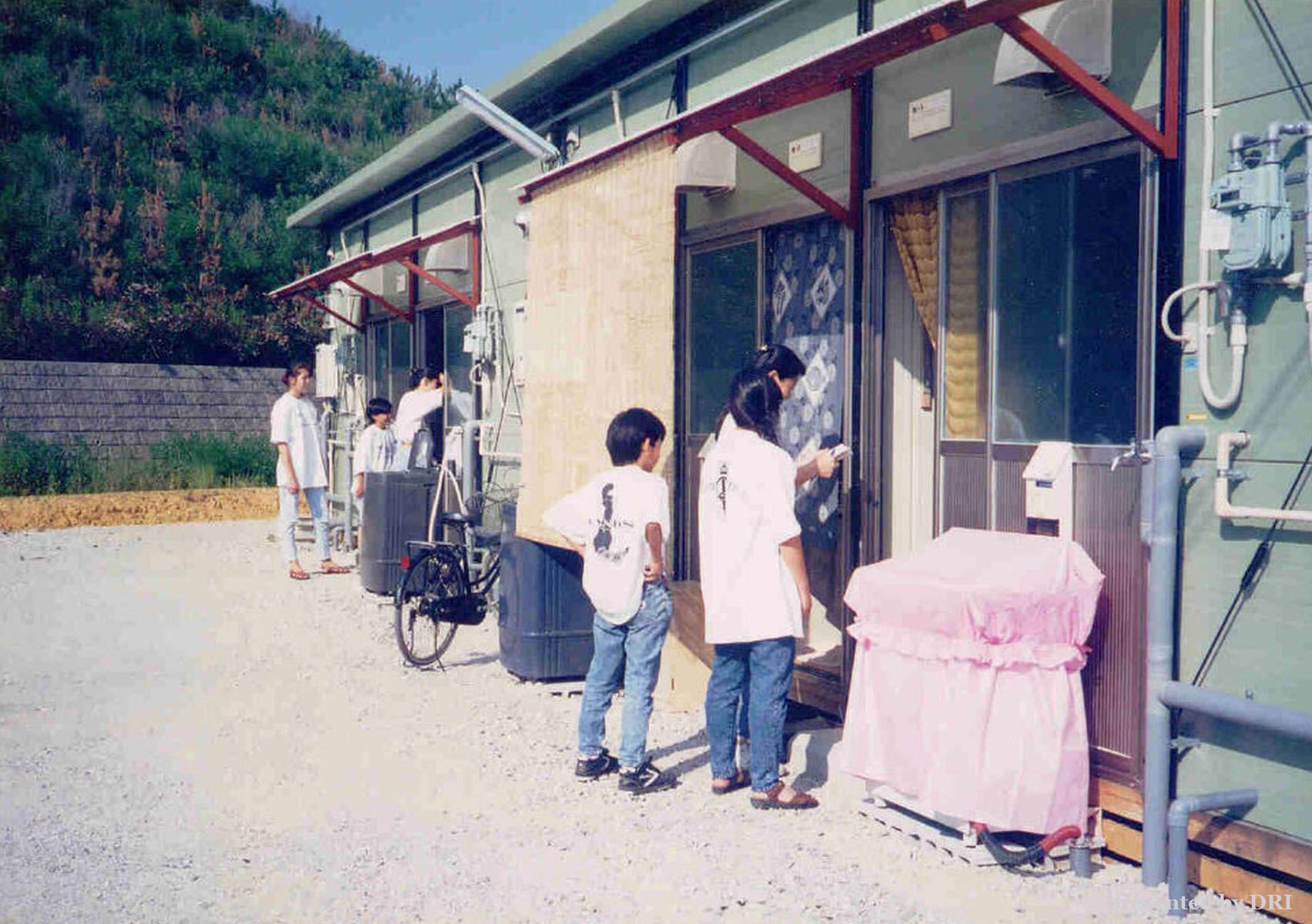
Temporary housing reached its peak at over 40,000 households. Support services for residents, such as visiting each household, checking on the physical and mental condition of residents, preventing alcoholism etc. was also carried out.
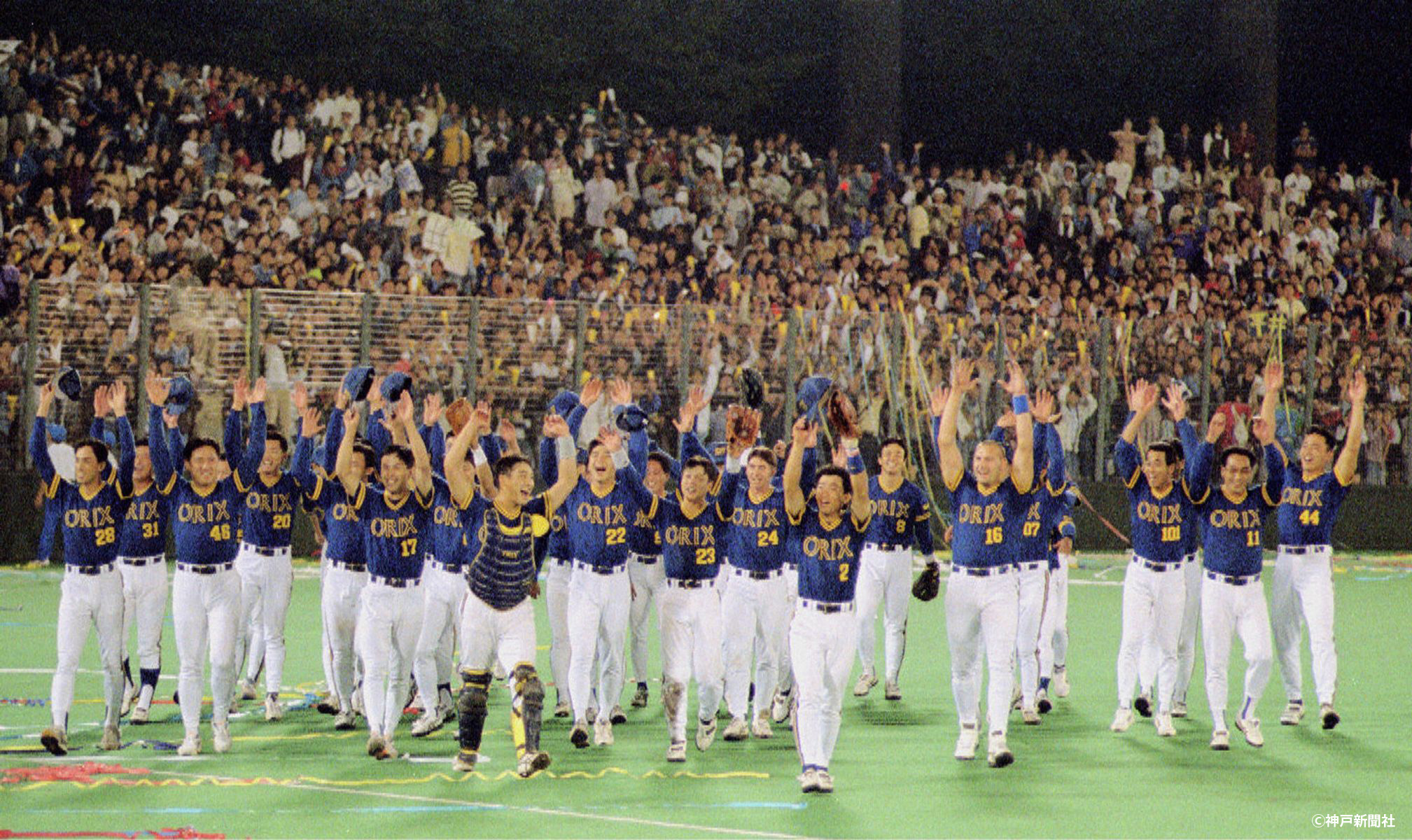
19 September 1995. The pro baseball team Orix, with the slogan "Ganbaro KOBE"expressing hope for a speedy recovery and encouragement for disaster victimes, won the baseball championship for the first time.
(Photograph supplied by Kobe Shinbun)
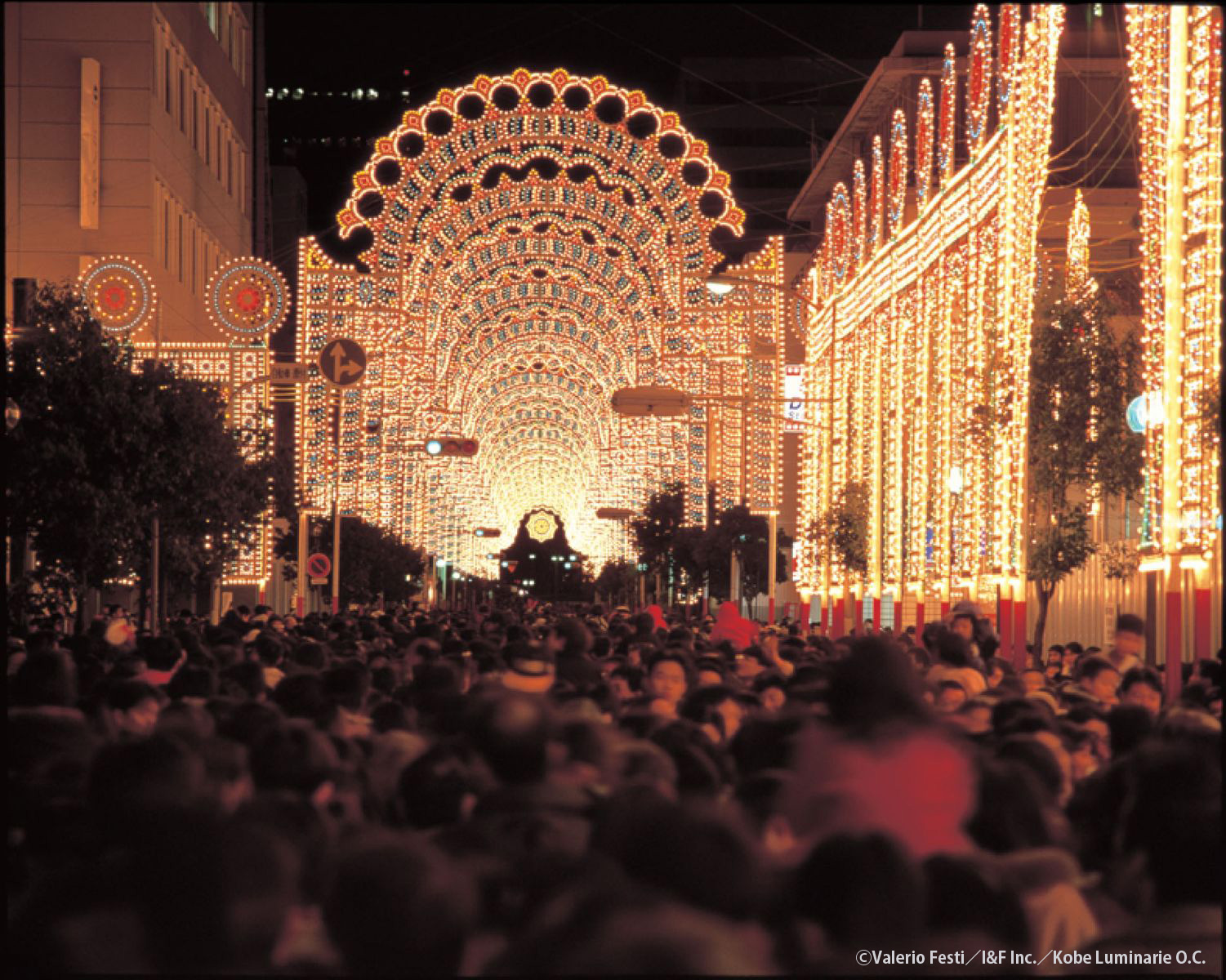
15 December 1995. The first Kobe Luminarie. This event passes on the legacy of the earthquake and expresses the hopes and dreams of the people of Kobe. It has been held every December since 1995.
©Valerio Festi / I&F Inc. / Kobe Luminarie O.C.
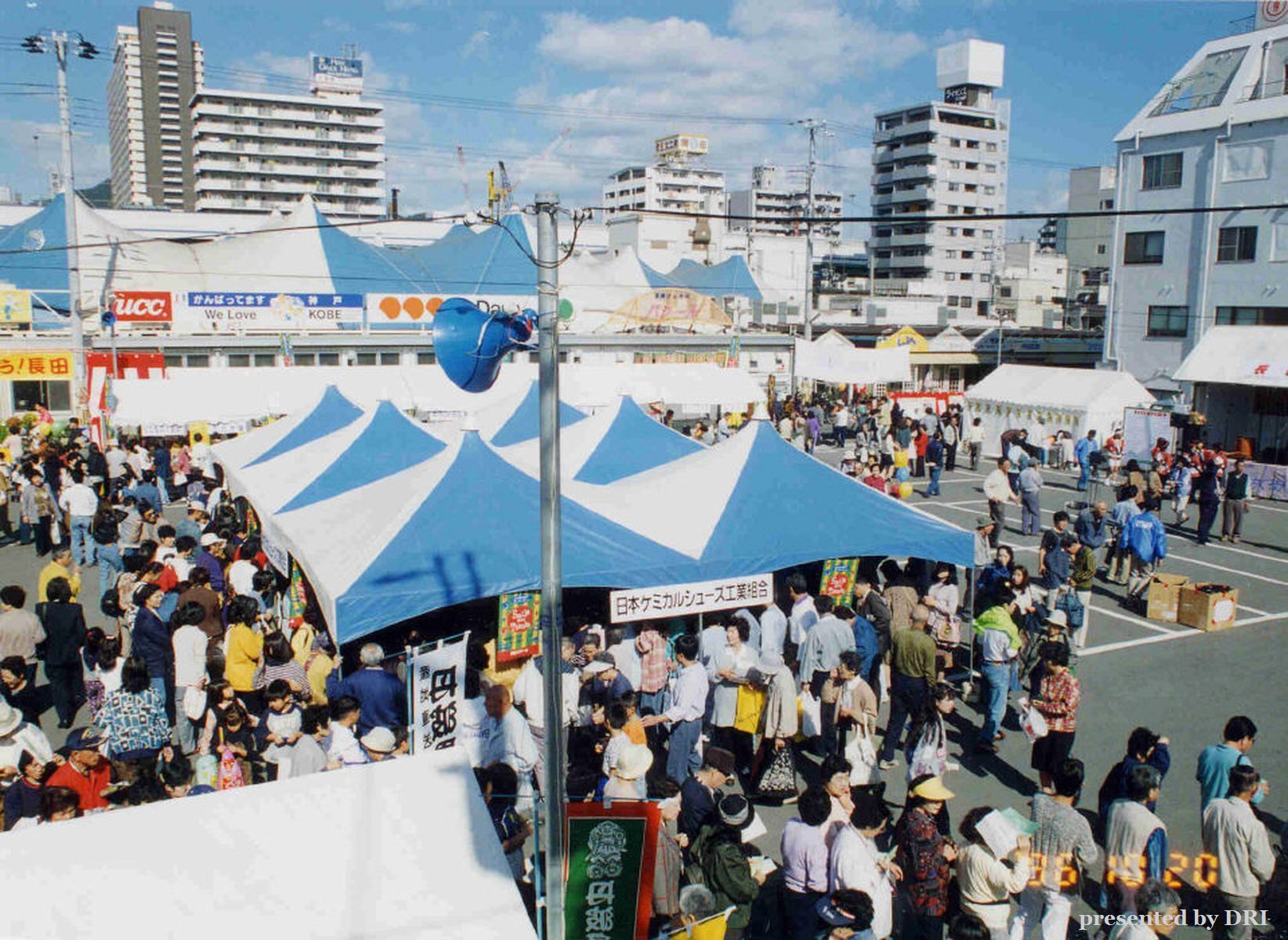
Temporary shops and shopping streets. Until shops could be reopened properly, tent and pre-fab shopping villages sprung up and contributed to the recovery of the city.
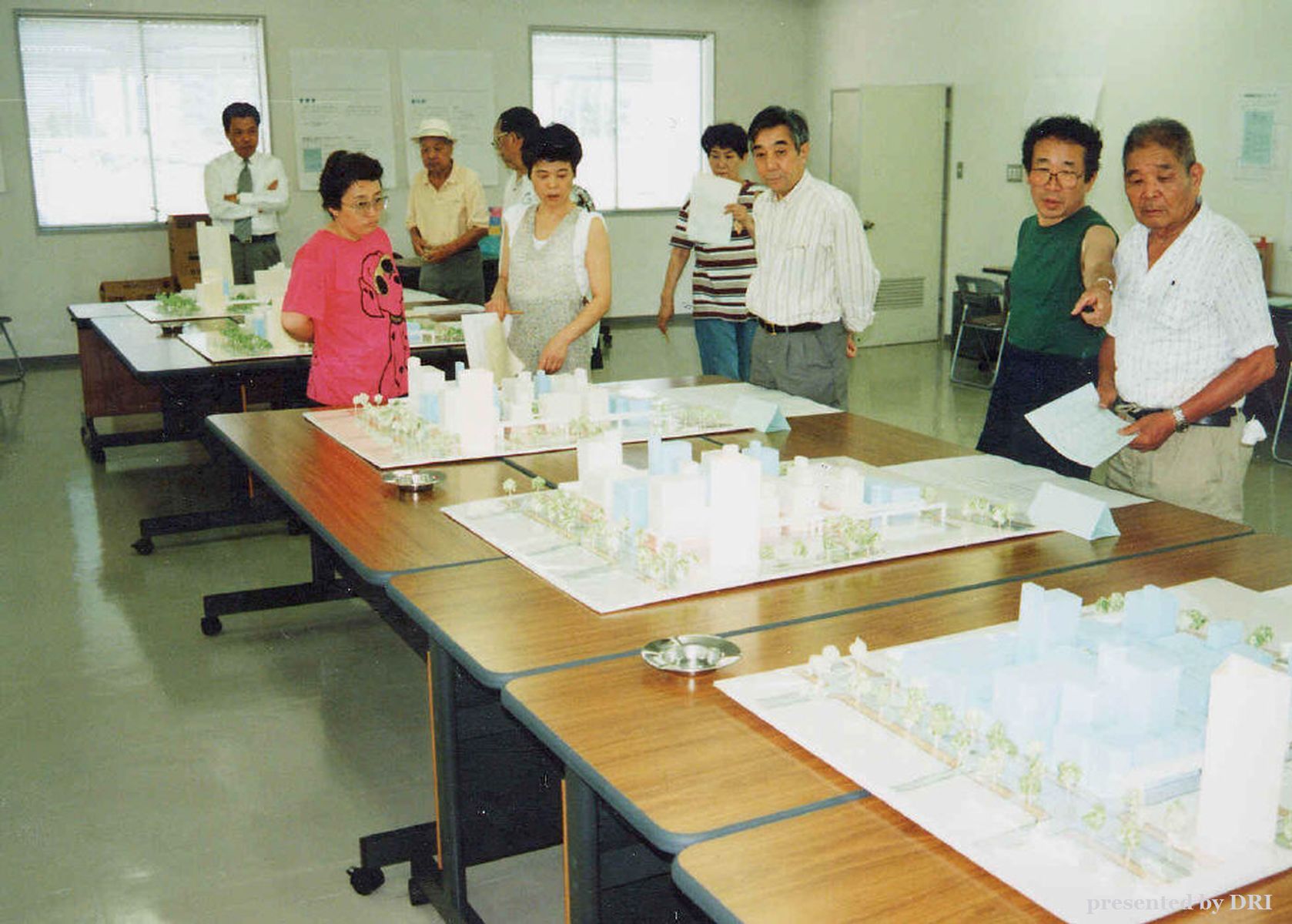
Government plans were conveyed to local residents and discussions held based on the needs of landowners. Compiling recovery plans took much time and effort and local town planning councils made a strong contribution to recovery in each district.
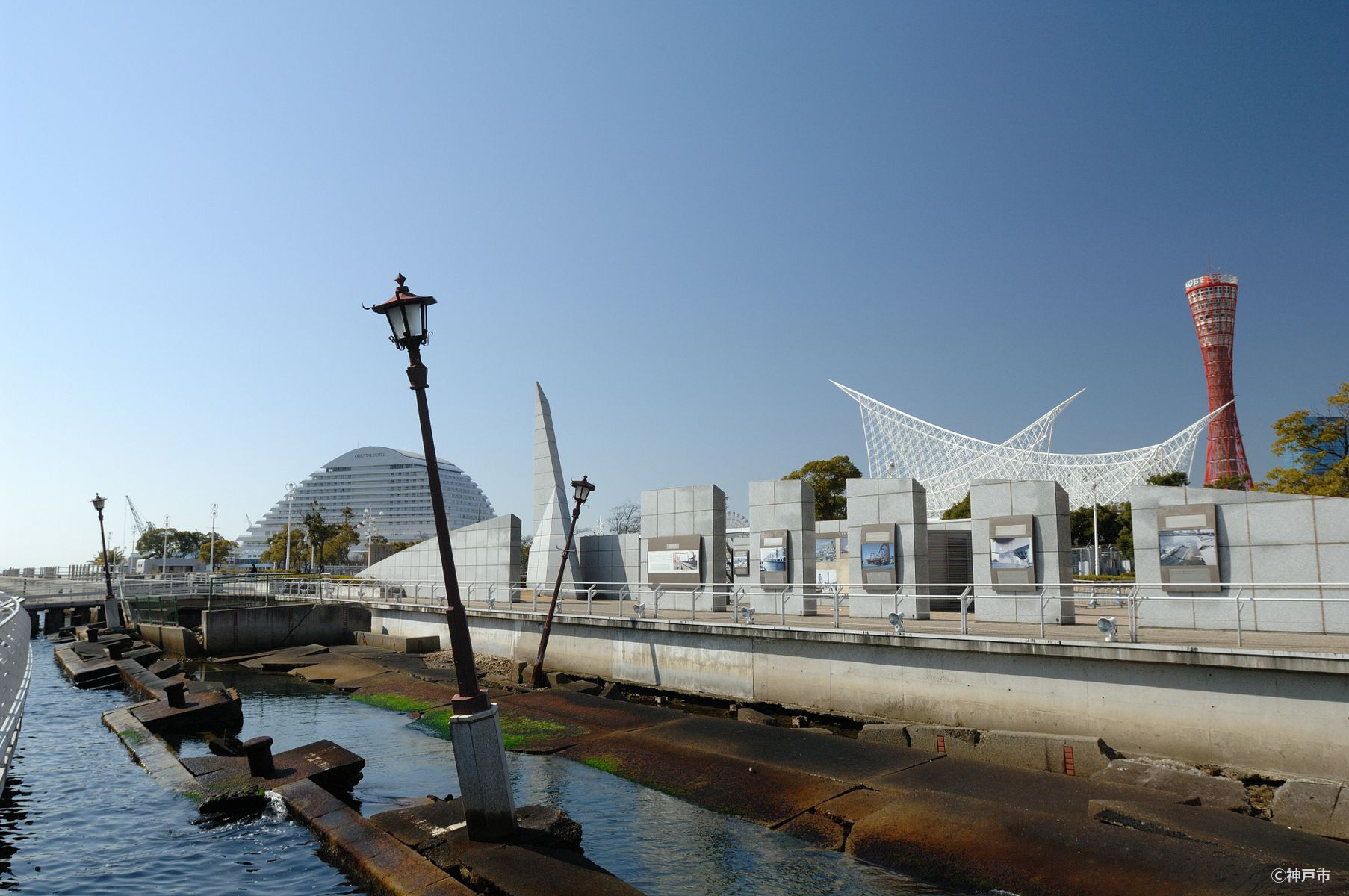
19 May 1995. Kobe Port Recovery Declaration. In July construction began on a memorial park, preserving a section of the damaged Meriken Wharf.
(Photograph supplied by Kobe City)
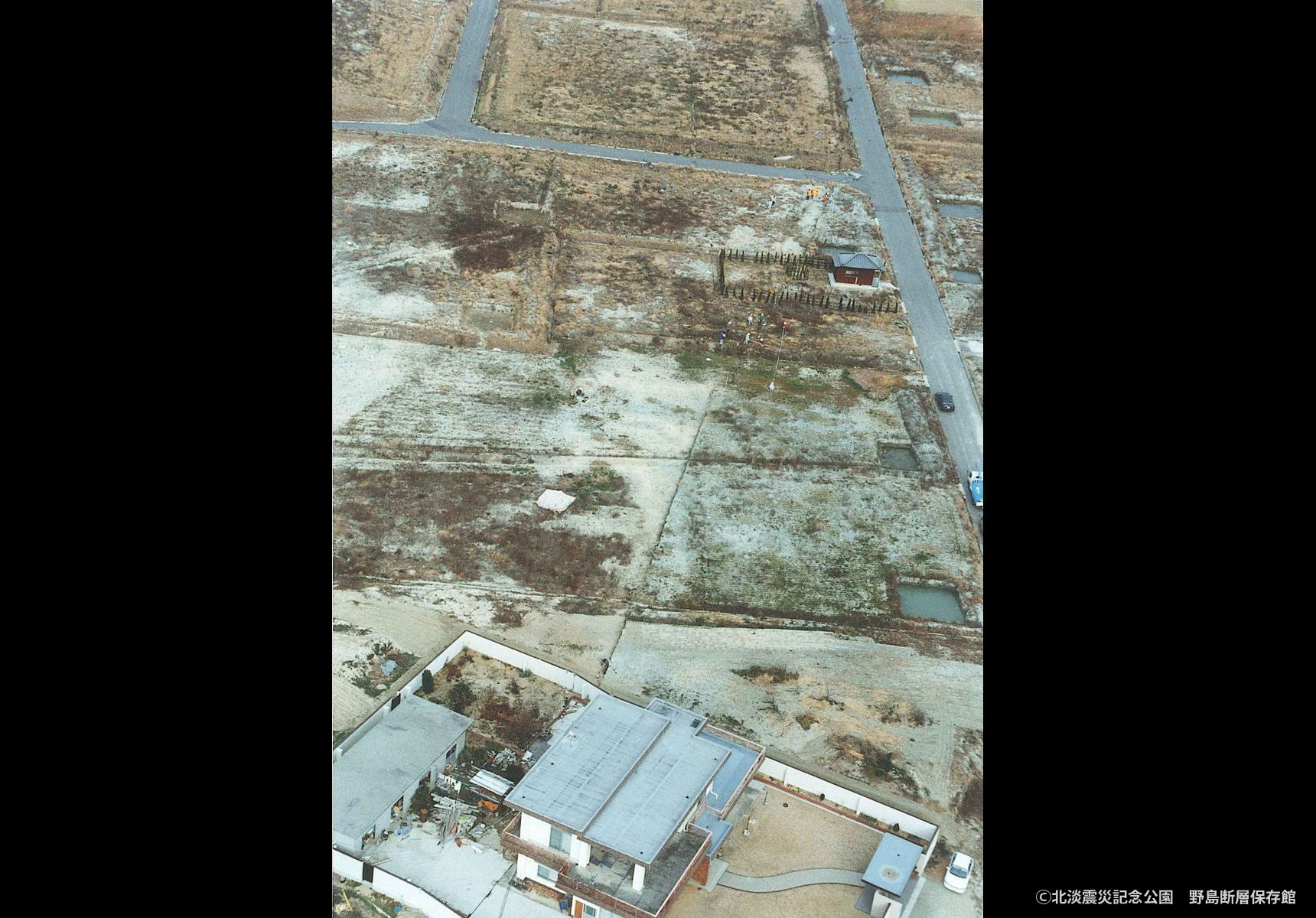
The Nojima Faultline, in northern Awajishima, left the ground exposed.
(Photograph supplied by Hokudan Earthquake Memorial Park, Nojima Faultline Museum.)
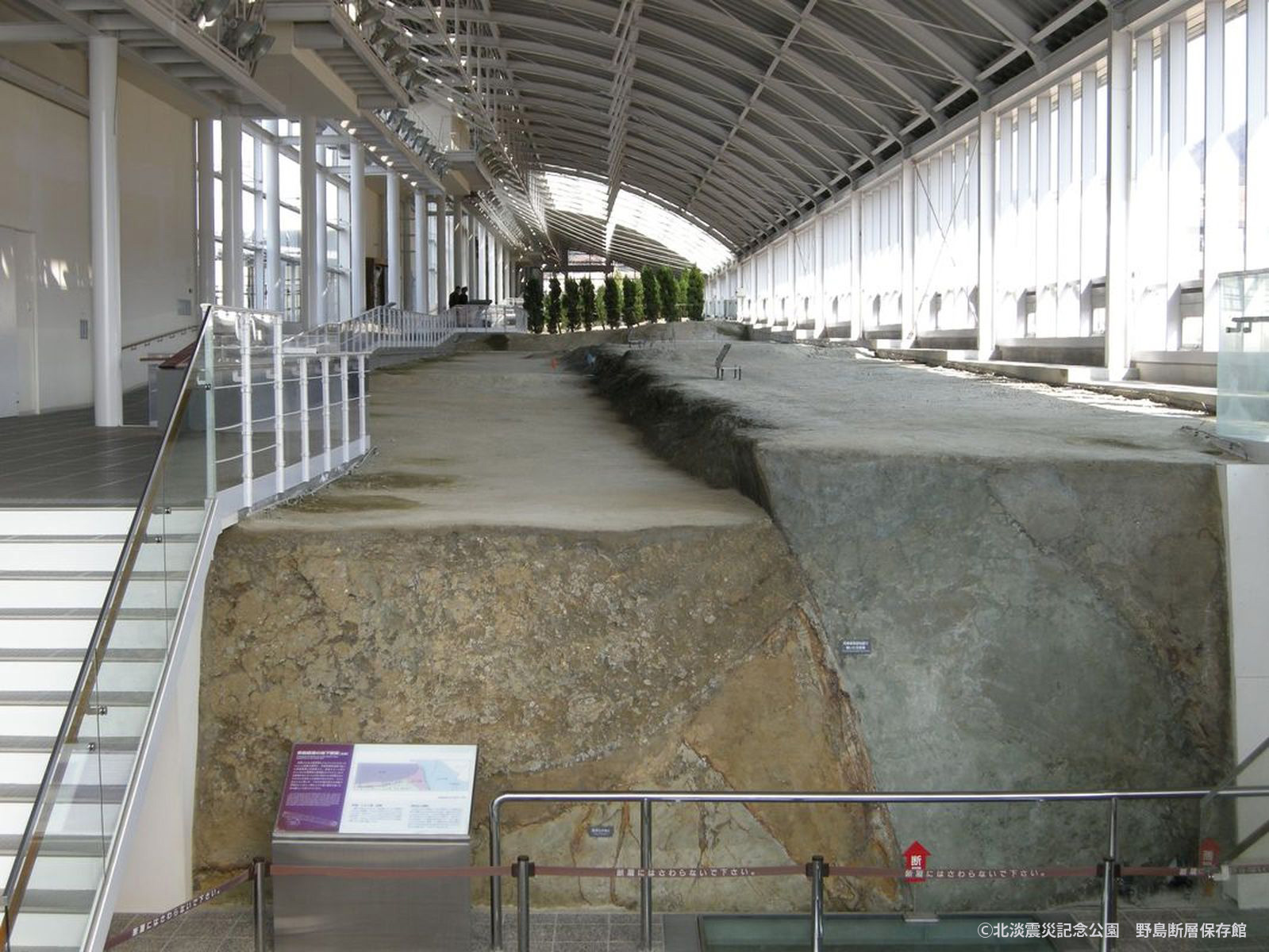
2 April 1998. Opening of Hokudan Earthquake Memorial Park, displaying the Nojima Faultline.
(Photograph supplied by Kita-awa Earthquake Memorial Park, Nojima Faultline Museum.)
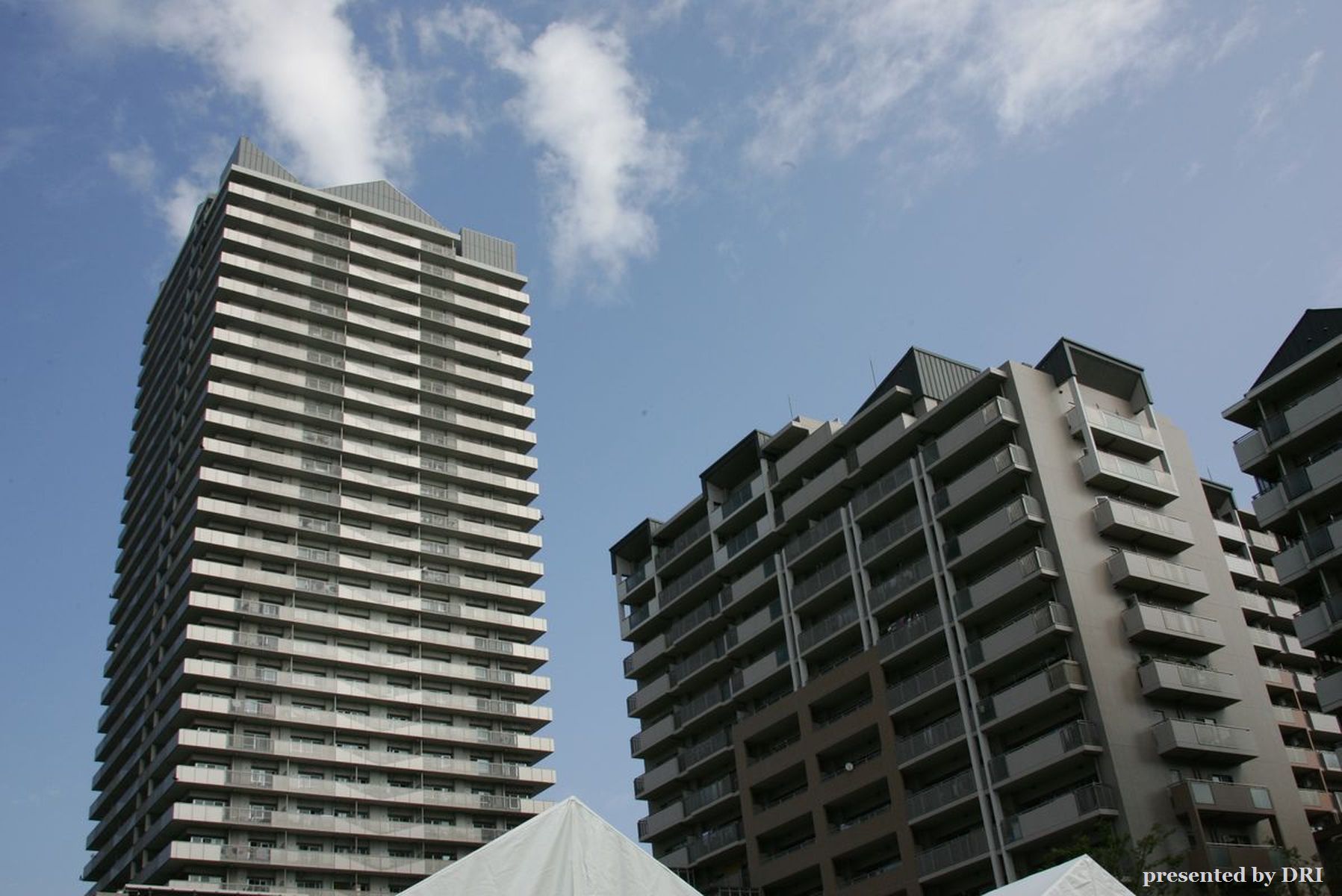
11 May 1995. Public housing for recovery in Hyogo Prefecture completed.
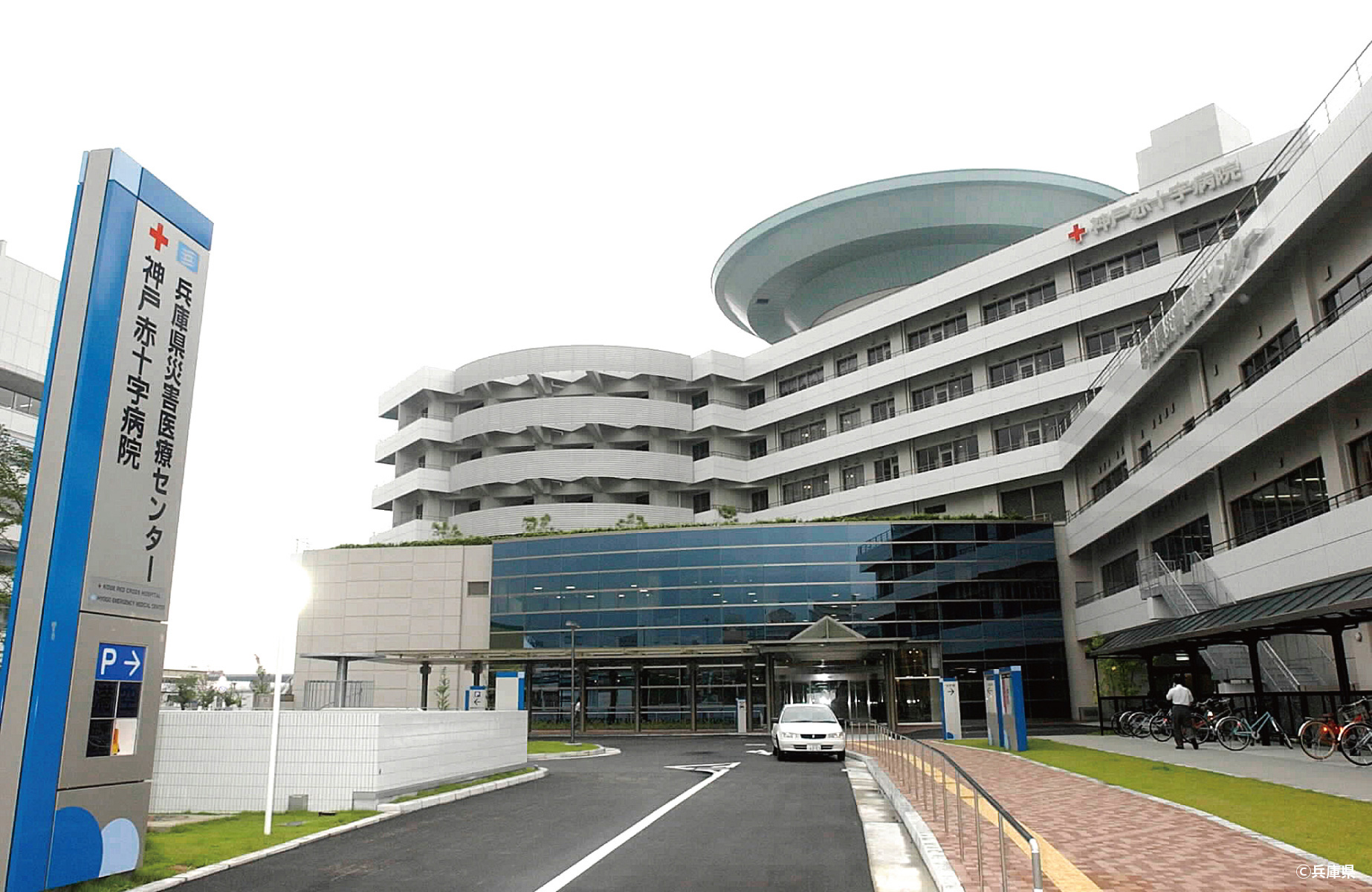
Main Hyogo Prefecture disaster prevention projects:
August 2003, opened the "Disaster Medical Center"
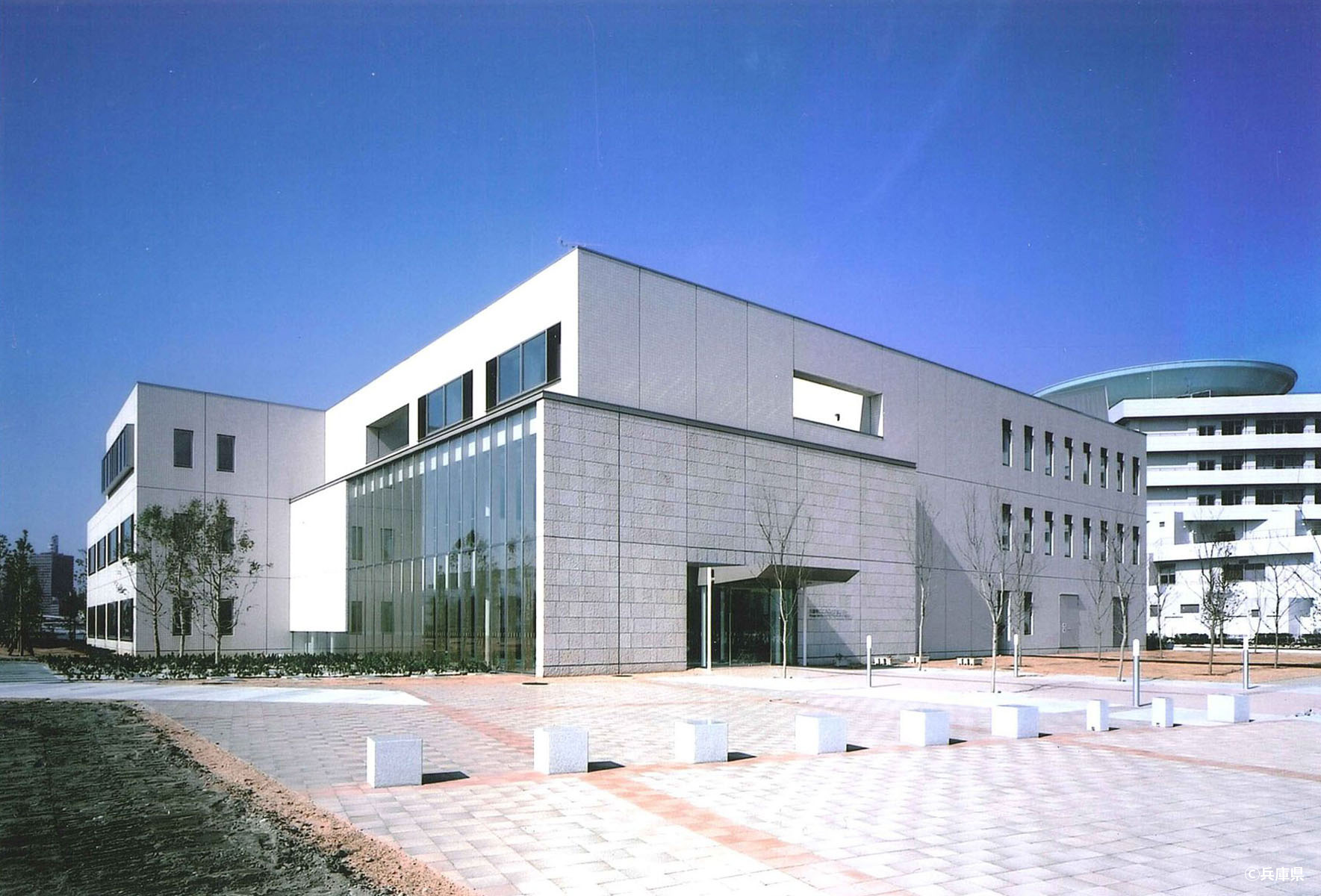
Main Hyogo Prefecture disaster prevention projects:
April 2004, opened the "Mental Care Center"
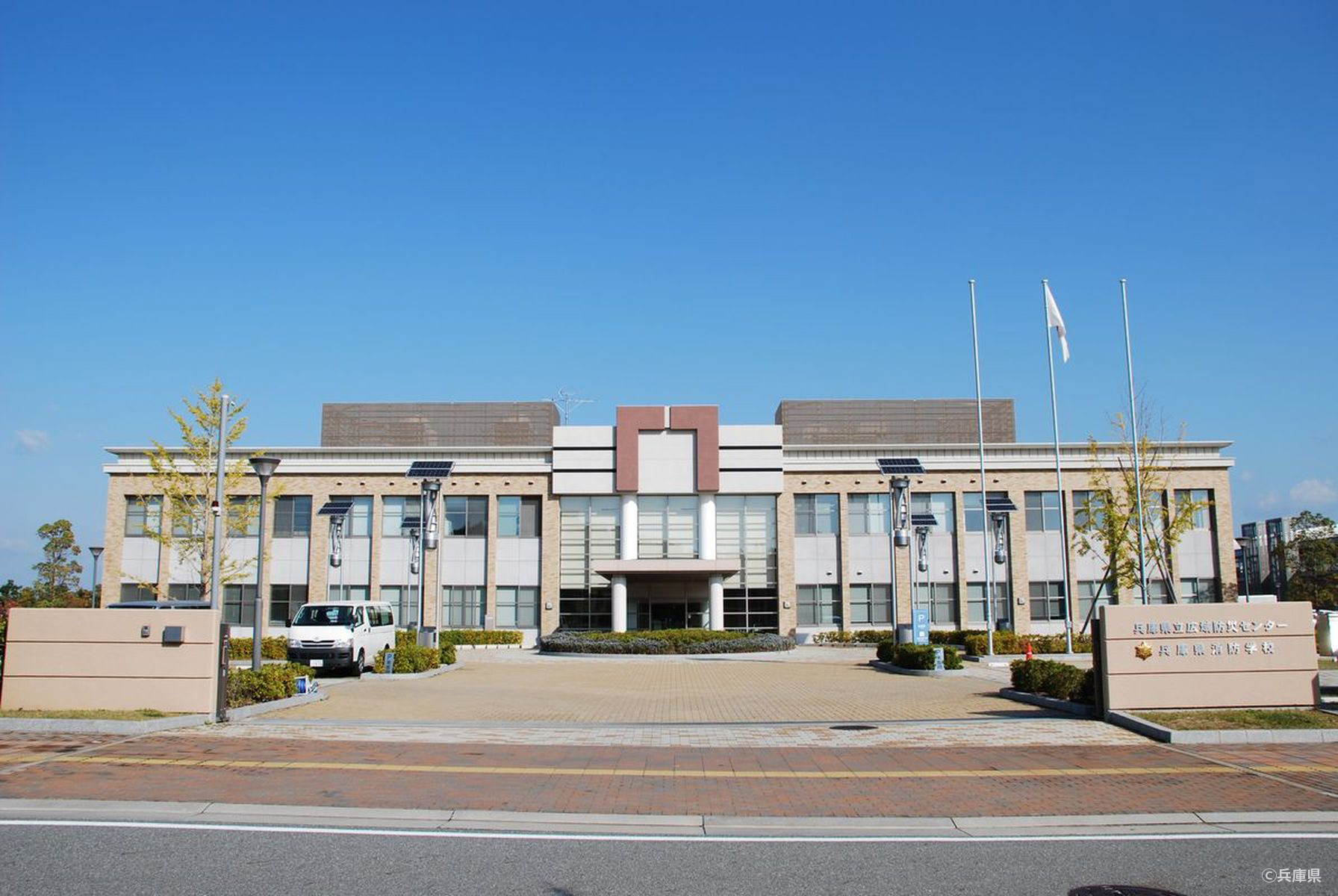
Main Hyogo Prefecture disaster prevention projects:
April 2004, opened the "Emergency Management and Training Center"
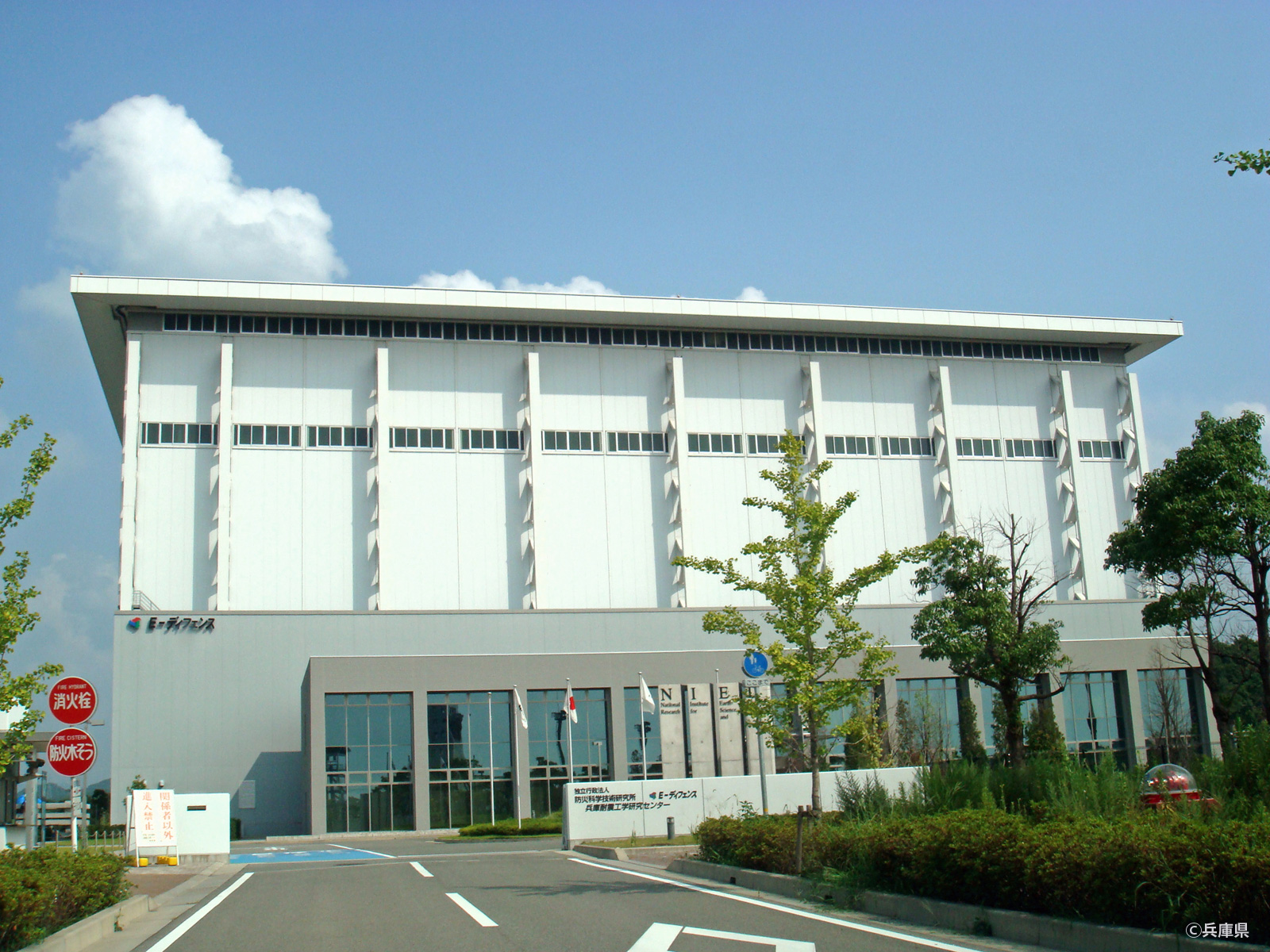
Main Hyogo Prefecture disaster prevention projects:
January 2005, completed the "E Defense Facility."
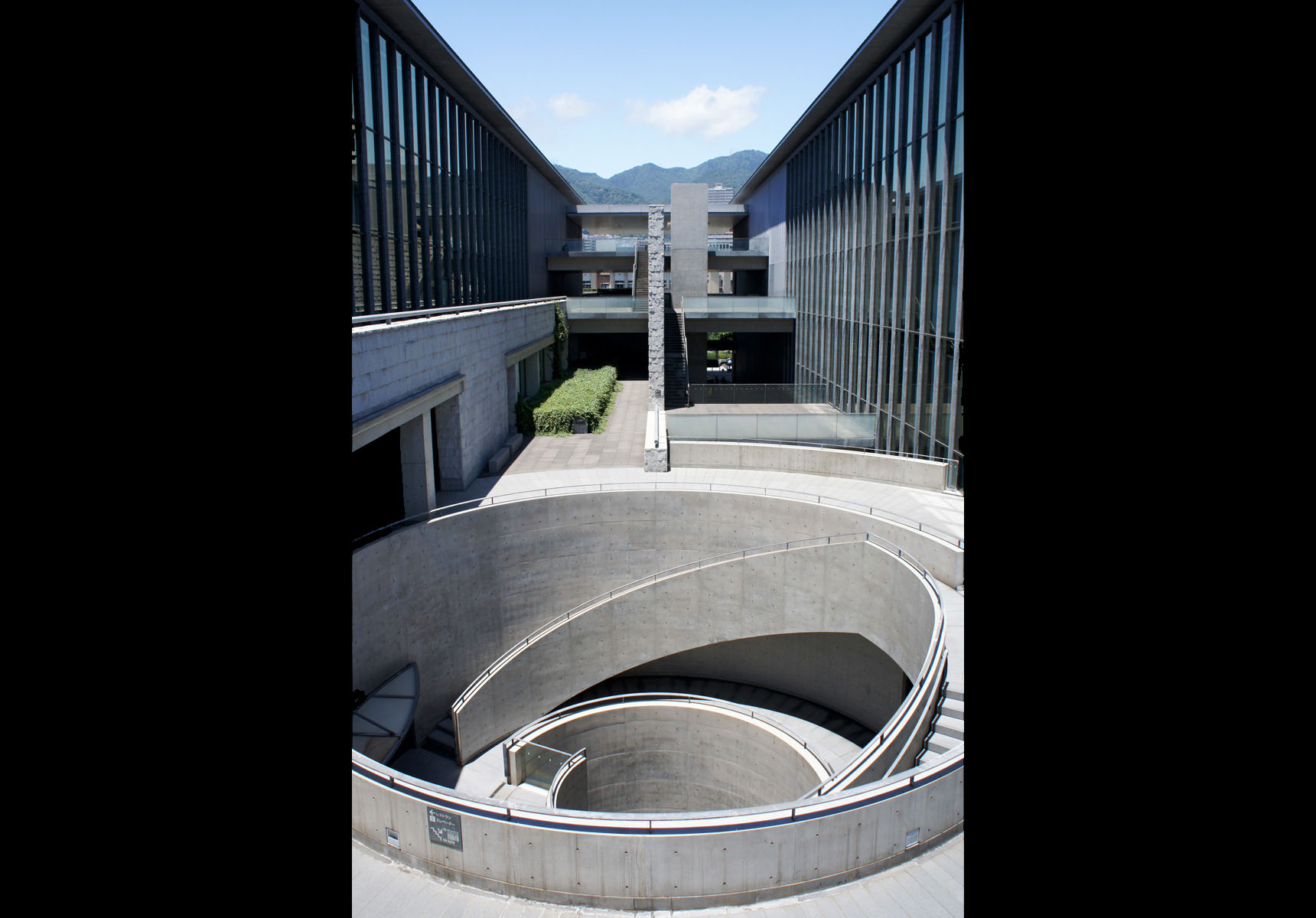
Main Hyogo Prefecture cultural projects:
April 2002 opened the "Prefectural Art Gallery,"
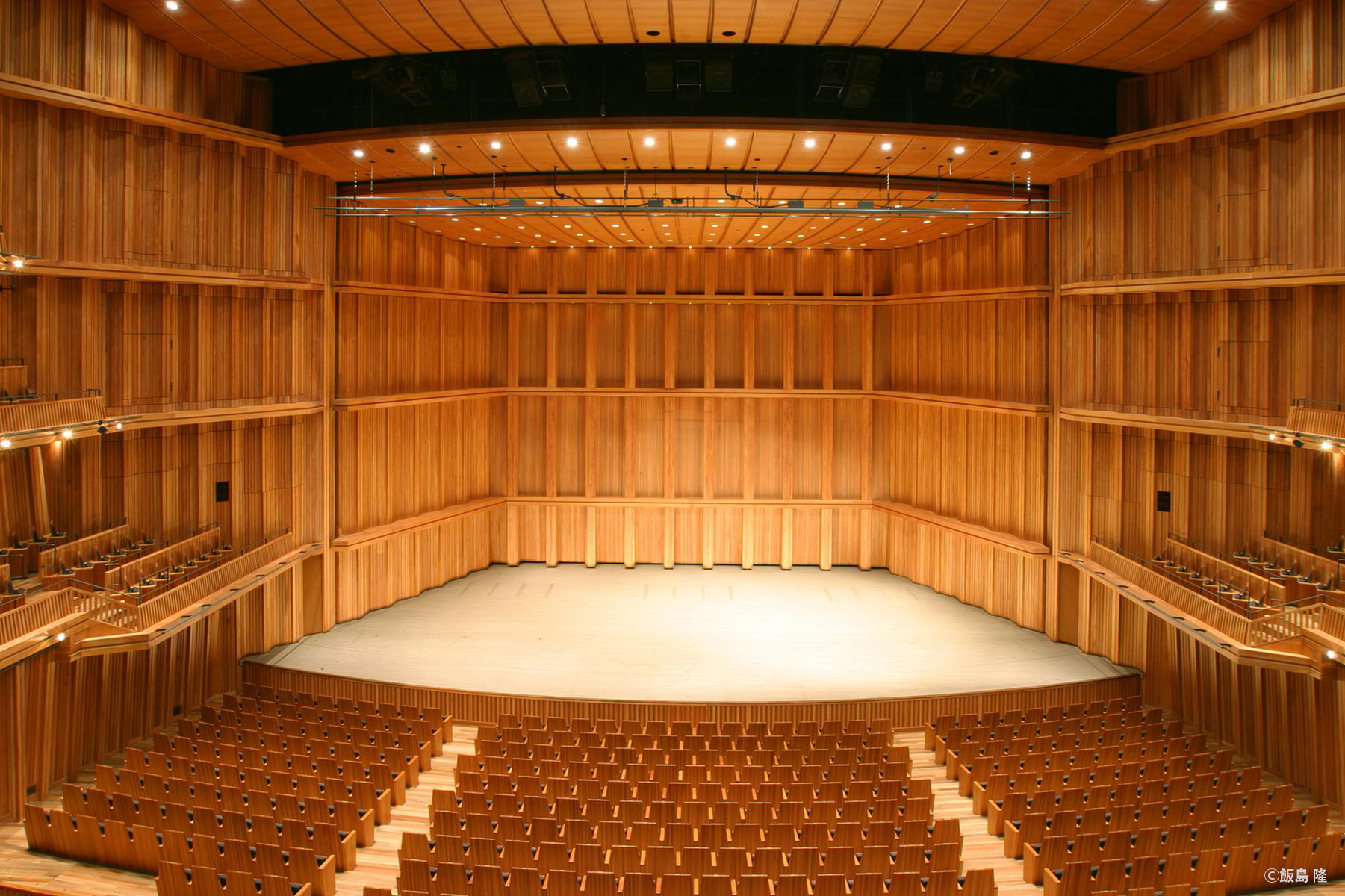
Main Hyogo Prefecture cultural projects:
October 2005 opened the "Hyogo Performing Arts Center"
© Takashi Ijima
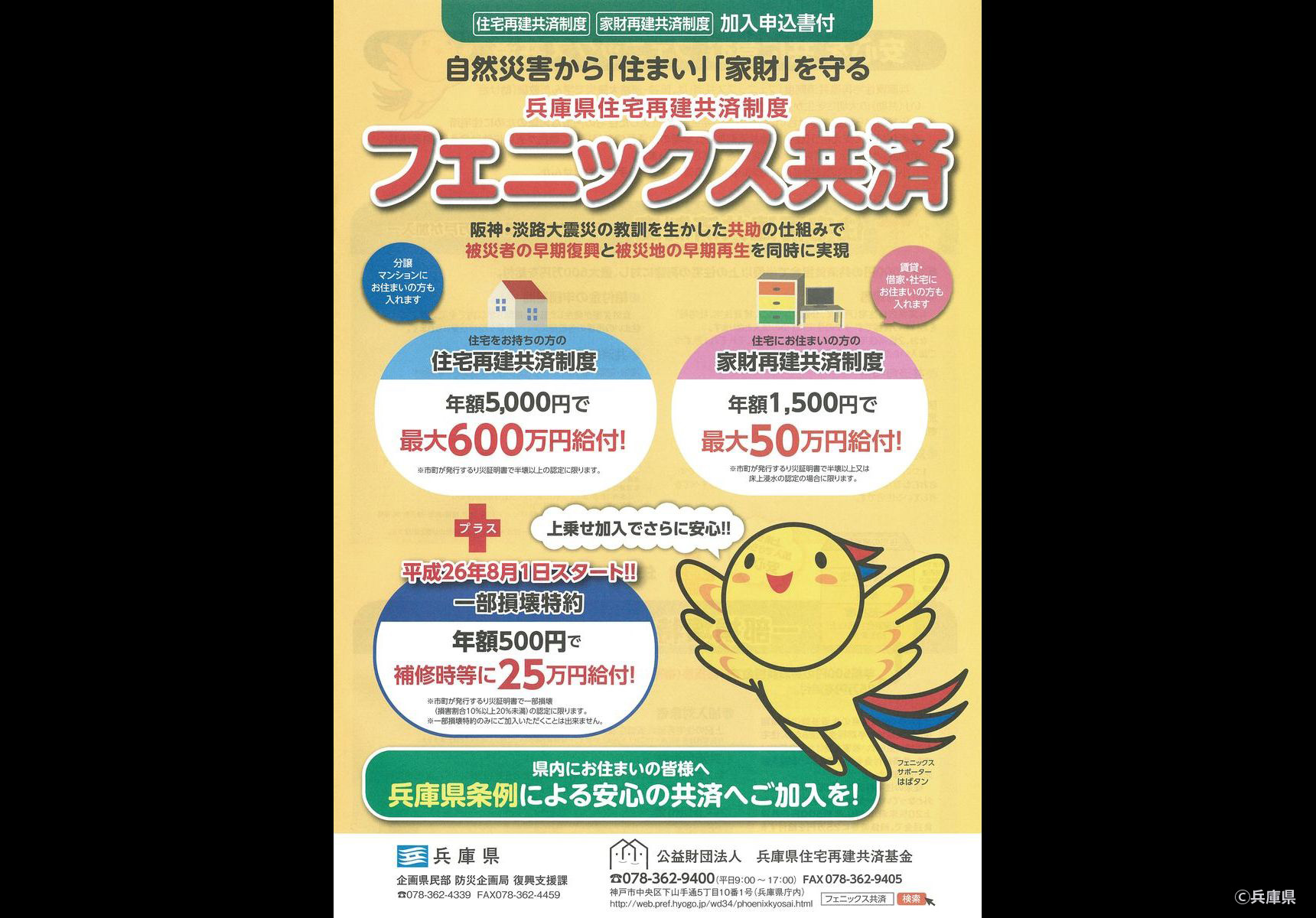
1 September 2005. Hyogo Prefecture "Phoenix Fund" for housing reconstruction started.
(Image is the cover of 2014 pamphlet)
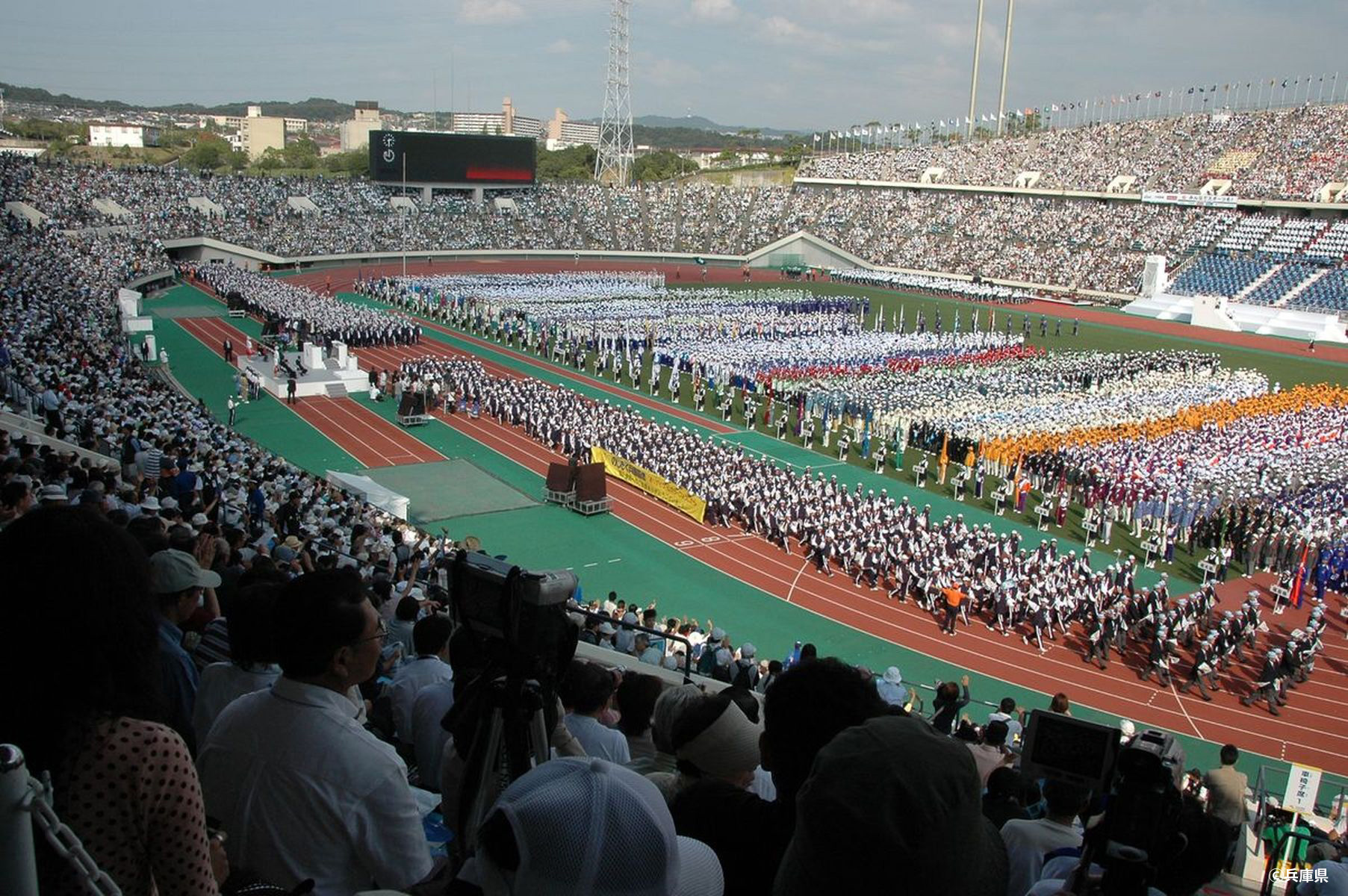
30 September 2006. 61st National Sports Festival held in Hyogo Prefecture. Habatan, the official Hyogo Prefecture mascot was born after this festival.
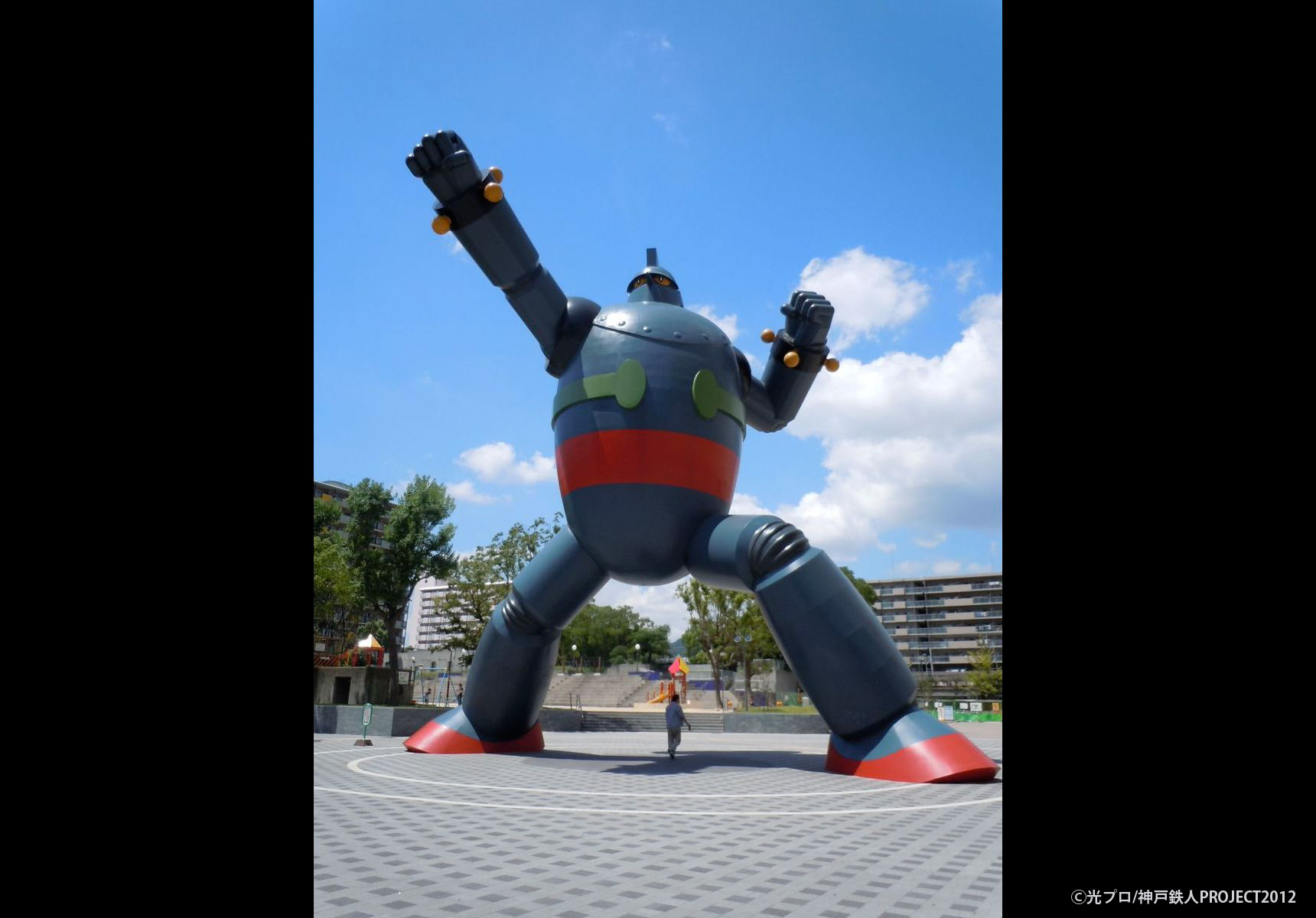
29 September 2009. Life size model of anime robot Gigantor completed in Nagata Ward.
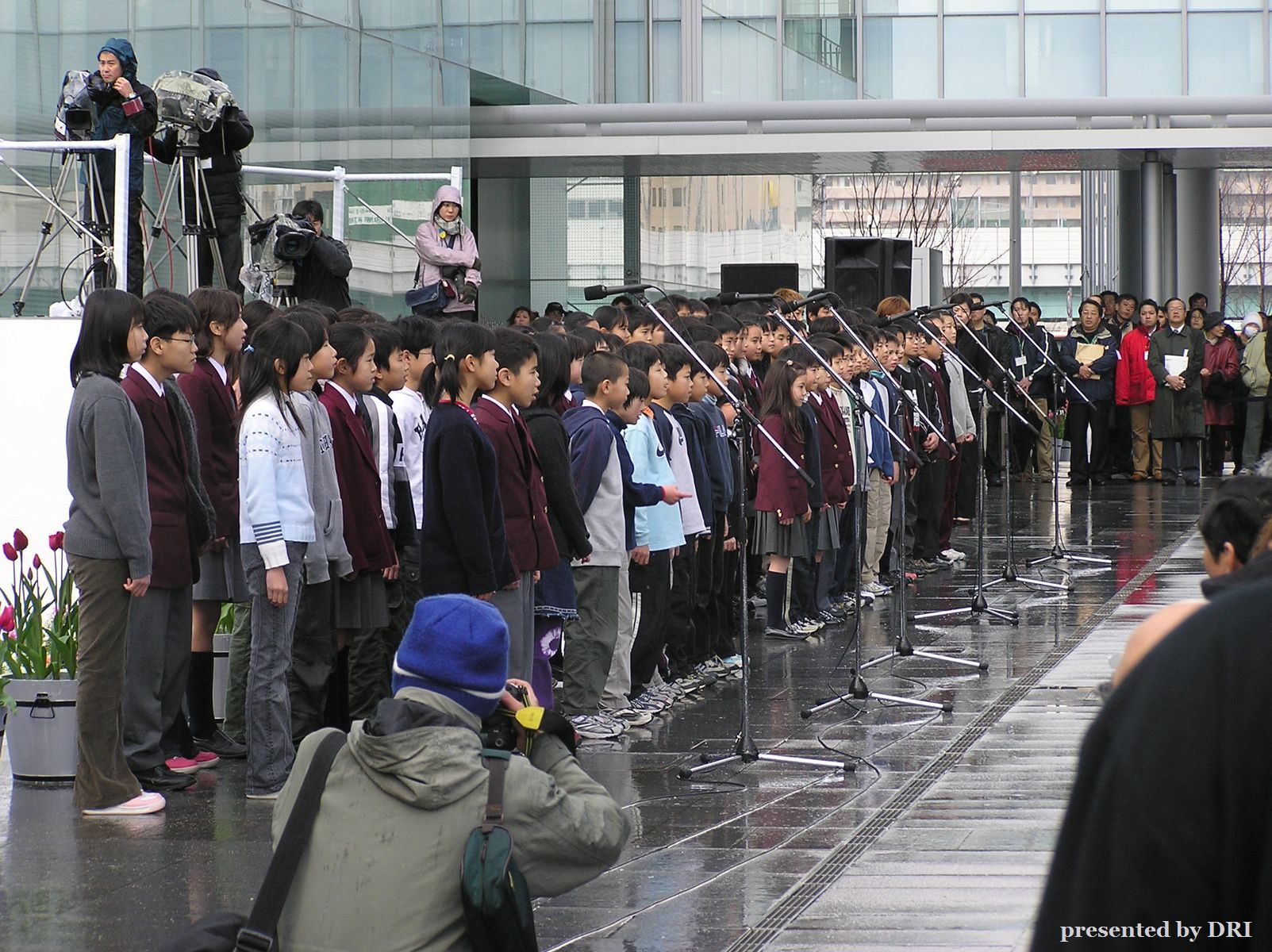
Primary school children singing a song created in after the earthquake. It is sung at ceremonies etc. each year since.
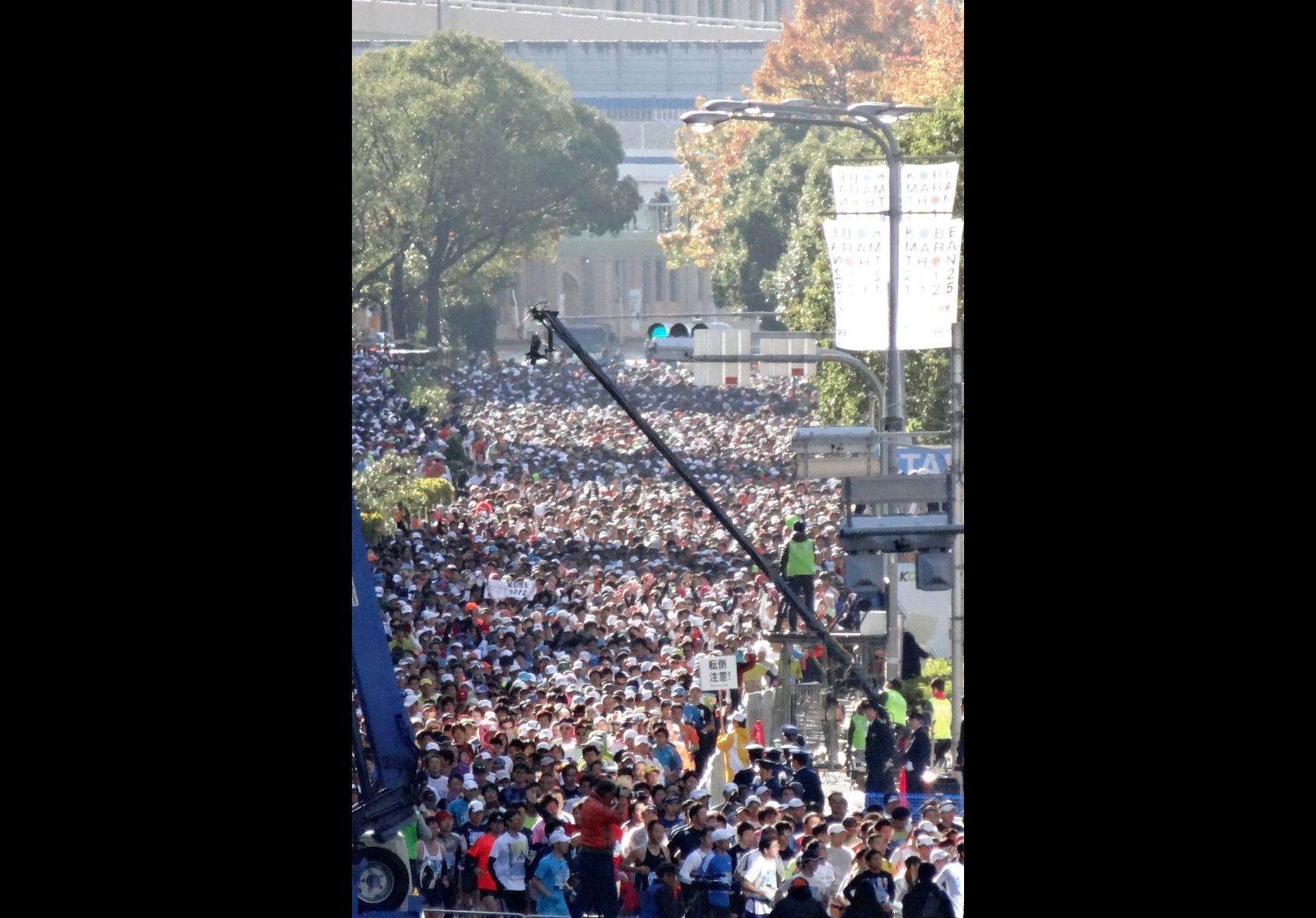
20 November 2011. First Kobe Marathon held, with the theme of appreciation and friendship.
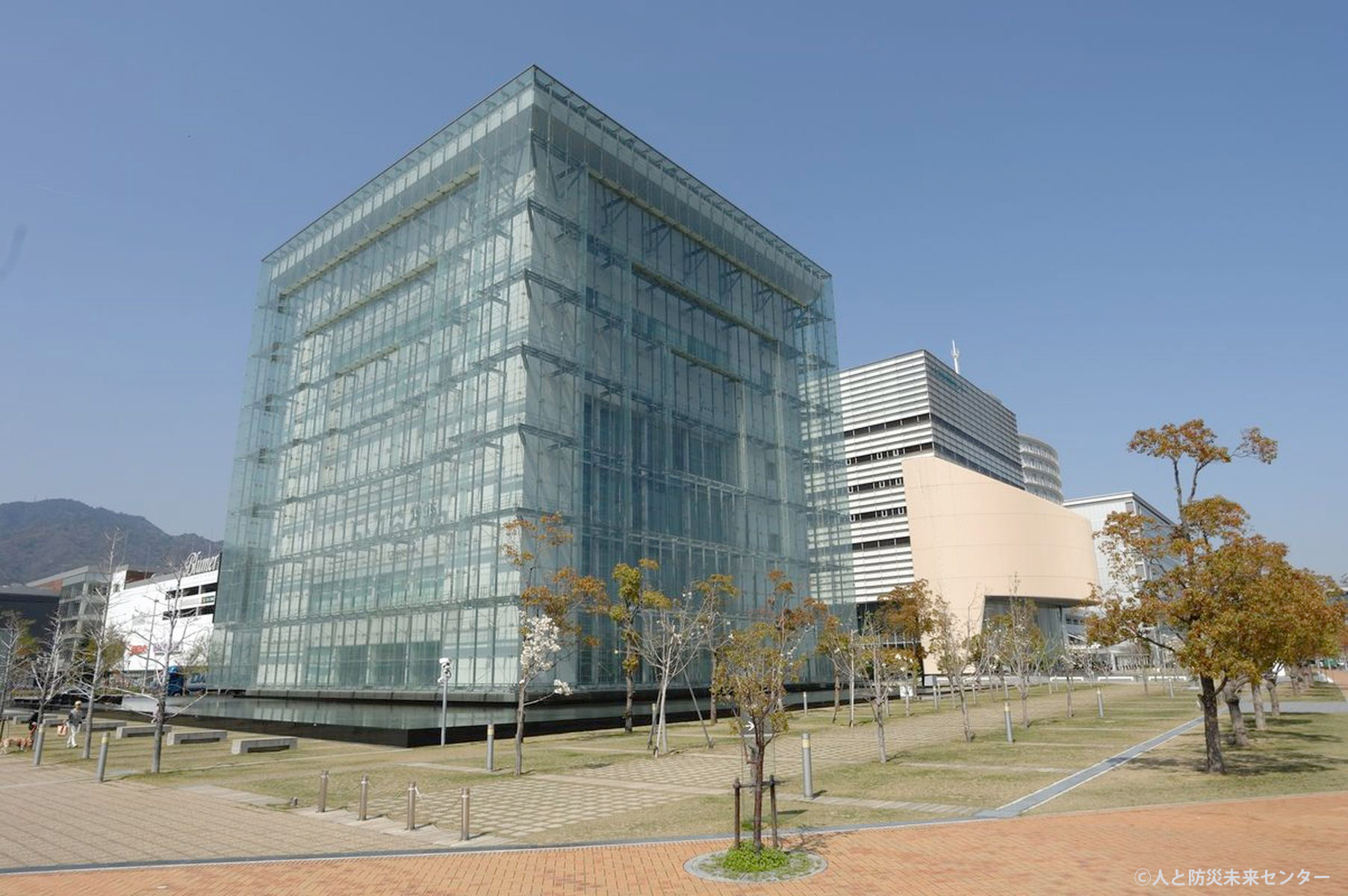
27 April 2002. Opening of the Great Hanshin-Awaji Earthquake Memorial Disaster Reduction and Human Renovation Institution, a facility to pass on the lessons and the legacy of the experiences of the earthquake.